The best times to visit Namibia for hiking, wildlife and more

Oct 23, 2023 • 4 min read

Take advantage of Namibia's dry skies for excellent stargazing © Paul & Paveena Mckenzie / Getty Images
With its famously clear skies and abundant sunshine, Namibia is a wonderful destination at any time of year. The weather is almost always good – the ever-present sunshine is even highlighted on the national flag – and most areas of the country are accessible year-round.
Yet, depending on your interests, it’s worth putting some thought into the timing of your trip. Hiking is best planned for the cooler winter months from May to October to avoid the summertime heat, while coastal exploration is easier in the summer, from December to March, when winds are gentler and there is less fog.
Whatever draws you, plan the perfect time for your visit with this guide to Namibia’s seasons and events.


June to October is the best time for safaris and for visiting Sossusvlei
Cloudless daytime skies, clear, cold nights and almost no likelihood of rain are the hallmarks of Namibia’s wintertime, from June to October. Inland, temperatures average between 19ºC and 24ºC (66ºF to 75ºF) during the day, while from June to August, nighttime temperatures in the desert and at altitude generally sit below 10ºC (50ºF) and sometimes drop below freezing.
The cooler high season is also the dry season, so foliage is less dense and animals can be easily spotted as they congregate around scarce water sources. This is a fine time of year for wildlife watching at Etosha National Park , and safari camps fill up. On the coast, winds can be stiff and the shoreline is often blanketed by a thick morning fog, although this generally burns off before midday.
If you're thinking of scaling the dunes around Sossusvlei , June through August are ideal months, as temperatures are at their coolest and the sands not as searingly hot.
In delightful October, with winter definitively over, Namibia's jacaranda trees burst into bloom. They are especially lovely in Windhoek and the northern town of Tsumeb, where streets are shaded by lavender-hued canopies and carpeted with the fallen blossoms.

April, May and November are best for shoulder-season discounts and exploring away from the crowds
April and May are lovely times to be in Namibia. Much of the country is covered in shades of vivid green, the rains have washed away the late dry-season dust and the air is exceptionally clear. Daytime temperatures range from 24ºC to 28ºC (75ºF to 82ºF). Apart from the Easter holidays, safari camps are generally not full.
In November, daytime temperatures can exceed 30ºC (86ºF) as the thirsty land eagerly awaits the return of the rains. Wildlife watching is ideal, with plenty of animals visible, but without the crowds of July and August. Many lodges and camps in national parks and private reserves offer discounted rates. Birding also starts to peak at this time, as migrant species make their way into the region.

December to March is the best time for coastal travel and birding
Along the coast, the Namibian summer is marked by a holiday vibe, pleasant conditions and opportunities galore for a braai (barbeque). Sea breezes provide refreshing relief from the inland heat, and there is less fog and wind than in the winter months.
With the advent of the rains, birding in Etosha National Park and countrywide reaches its prime. Around February, flamingos gather by the thousands in Etosha pan to breed – a magnificent sight. While Etosha’s wildlife is widely dispersed and can be difficult to spot, the park has its own appeal at this time, with no crowds apart from the Christmas-New Year period.
Although the summer months are the wettest time of year in Namibia, downpours are mostly limited to late afternoons and evenings. Unpaved roads, especially in the far north and in the waterway-laced Zambezi region, can become difficult to traverse, but otherwise, rain does not usually interfere with travel.
Temperatures are high everywhere, especially in the far south. In the Fish River Canyon , the mercury can soar to above 40ºC (104ºF), and the canyon hiking trail is closed.
Namibian Independence Day on 21 March heralds the end of summer, as the skies clear and migrant birds prepare to depart.
Wherever you travel, keep in mind that accommodation - especially on the coast and in Etosha National Park - fills up during the December and January school holidays; advance bookings are recommended.
This article was first published Sep 16, 2022 and updated Oct 23, 2023.
Explore related stories

Jan 2, 2023 • 12 min read
Want to start planning for the year ahead? Featuring sports events, natural phenomena and more, these are 20 amazing trips to consider taking in 2023.

Aug 23, 2024 • 7 min read

Jul 18, 2024 • 7 min read

Jul 17, 2024 • 8 min read

Mar 20, 2024 • 8 min read

Feb 20, 2024 • 17 min read

Dec 8, 2023 • 4 min read

Oct 27, 2023 • 8 min read

Oct 26, 2023 • 3 min read

Oct 23, 2023 • 7 min read
Best time to visit Namibia
When planning a trip to east Africa, choosing the best time to visit Namibia and its surroundings is important. Guests should be aware of the differences in climate, availability, activities and pricing when choosing between the various months and seasons.
Table of Contents
Best time to go to Namibia: Regions and months
Namibia is a beautiful country to visit, regardless of the season and popular with visitors arriving into Namibia from the U.S, U.K, Germany, Switzerland, Italy, South Africa and beyond. Some visitors may require a Namibia visa to secure their entry.
The country has a subtropical desert climate characterised by great differences in day and nighttime temperatures, low rainfall and overall low humidity.
Namibia also has desert along the coast and in the south, and arid, but with a rainy season from November to March, in inland north-central areas and in the north-east.
The country experiences winter and summer at opposite times as Europe and North America and they correspond to the Dry and Wet seasons.
The best time to visit Namibia is in the Dry season from June to October, although it can be visited throughout the year. Wildlife viewing in all parks, but especially in Etosha National Park is best in the Dry season.
Namibia wildlife viewing
Because of the arid environment, wildlife numbers are relatively low in Namibia, but animals are easy to spot. All of the big predators are present, and cheetahs are especially common throughout.
Huge herds of animals, elephants in particular, can be seen in the Dry season at Etosha pan.
Damaraland is home to a healthy population of desert-adapted elephants, a smaller population of black rhino can be tracked in a similar environment. The secretive brown hyena is sometimes seen lurking around seal colonies on the coast.
Other marine wildlife includes the rare heaviside’s dolphin and migrating southern right whale.
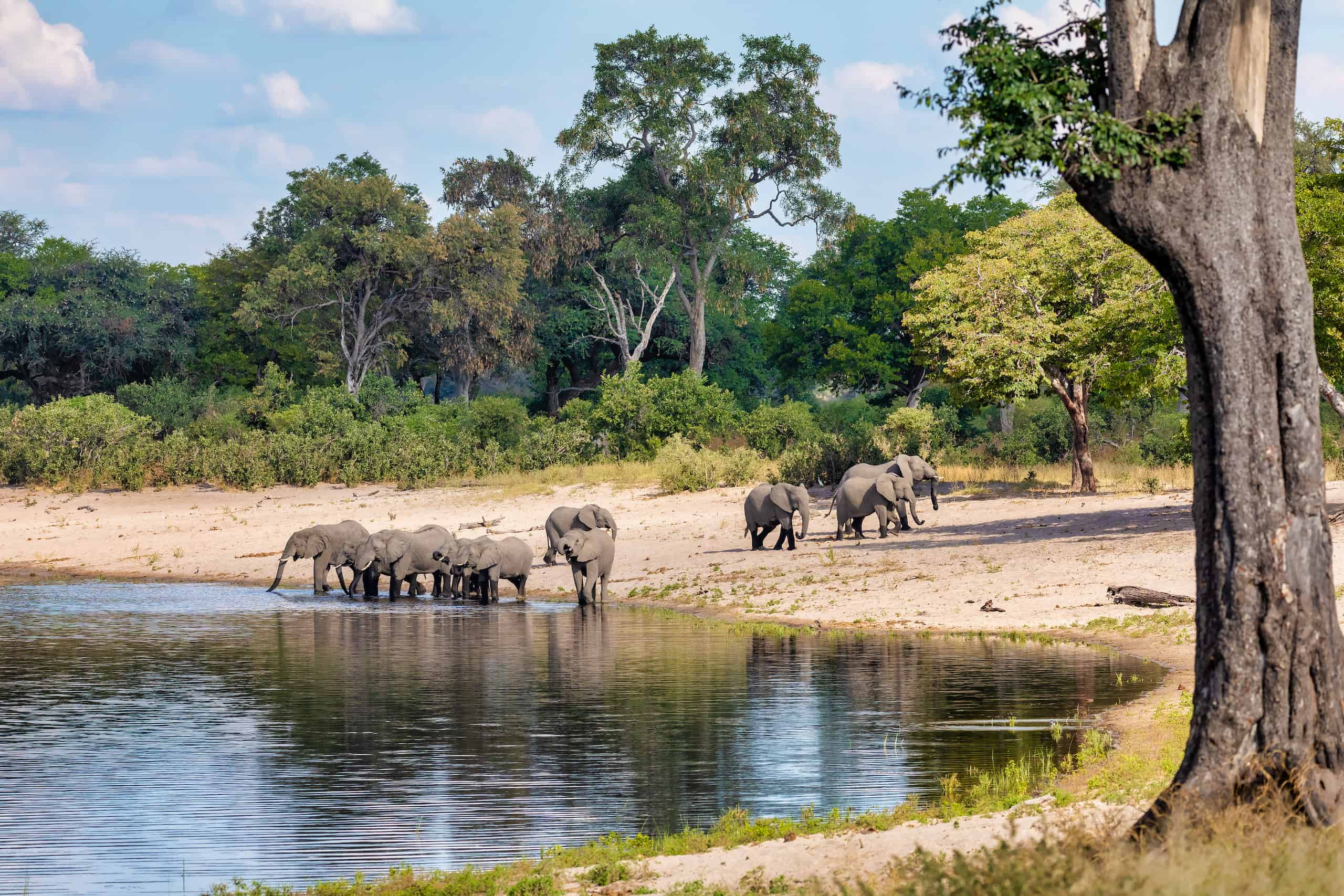
Weather and climate in Namibia
Seasons in namibia .
The climate is generally dry and pleasant. Between December and March, some days will be humid and rain may follow, often in localised, afternoon thunderstorms. In the Wet season, animals move away from the waterholes and scatter around the park.
Namibia is relatively dry throughout the year, but there are two rainy seasons. The little rains are from November to December and the main rainy season is from January to April.
During the rains, vegetation grows throughout the region and wildlife tends to scatter and is harder to find. The end of the Dry season (July-October) is the best time to see animals at the waterholes.
This coincides with the busiest tourist season and visitors are advised to be aware of Namibia vaccine requirements.
Temperatures in Namibia
Mean annual temperature for Namibia is 20.6°C, with average monthly temperatures ranging between 24°C (November to March) and 16°C (June, July). Mean annual precipitation is 269.2 mm.
Rainfall occurs from October to April, with minimal rainfall in May and September, across the latest climatology, 1991-2020.
The dry season in Namibia is from April to October, with the rains mainly falling from November to March. In April/early May, the grasses are still long and foliage quite thick after the rains, making game viewing more challenging.
Namibia’s Wet Season. The ‘rainy’ season is during the summer months, from November to April. The weather tends to be hot and humid with dramatic afternoon thunderstorms.
When to go to Namibia: Activities
The best time to visit Namibia is from July to October, when the temperatures are just above 20°C and the chance of rain is low. This is also the best time for wildlife viewing and so many other great things to do making it peak travel season — you will need to plan well in advance
Outdoor activities
Namibia has some of the most beautiful landscapes in Africa or perhaps even the world. It’s hard to explain what makes its vistas so inspiring and mesmerizing, but many would say that the country’s biggest asset is its wide-open spaces.
Climbing Dune 45 in Sossusvlei
Deep in the heart of the Namib desert are huge red dunes. At over 300m high, some of these are the tallest sand dunes in the world. The most photographed dunes are those surrounding famous pans, such as Sossusvlei and Dead vlei.
For climbing, however, dune 45 (45km along the road towards Sossusvlei) has the most ideal conditions. Walking along the crest and reaching the top of this sand formation is no easy feat, but more than worth the effort.
Etosha National Park
The Etosha National Park is centered around the vast Etosha salt pan. The pan itself is usually dry and only fills with water briefly in the summer, but is enough to stimulate the growth of a blue-green algae which lures thousands of flamingos.
Most of the wildlife, including herds of zebra, wildebeest and antelope, can be seen around the waterholes that border the pan. Etosha is served by three well established rest camps and offers a great self-drive safari experience.
Fish River Canyon
The Fish River Canyon is one of the best places to visit in Namibia. As one of the largest canyons in the world, it is always impressive, but early or late in the day the combination of soft light and playful shadows reveals its true beauty.
You’ll get a great photo from the main viewpoint, but avid hikers will get a better sense of the canyon’s proportion when tackling the 90km multi-day hike. For guided hikes, it’s recommended to carry a small amount of Namibian currency or USD dollars to tip your tour guide.
Located in the Namib Desert, Sossusvlei is an enormous clay pan surrounded by gigantic, red sand dunes. The Tsauchab River flows through the desert, and its rare flooding waters the vegetation that survives in the clay soil.
During sunrise and sunset, the colours of the sand dunes are constantly changing and provide an opportunity for photographers. The fierce desert winds continually alter the shape and texture of the dunes, providing an ever-changing desert landscape.
What is the best time to visit Namibia?
July to October is the best time to visit Namibia during the dry season for a safari.
What type of climate does Namibia have?
Namibia has a subtropical desert climate characterised by great differences in day and nighttime temperatures, low rainfall and overall low humidity with mean annual temperatures of 20C.

Best Time to Visit Namibia
It doesn’t matter what time of year you experience Namibia—its epic wildlife and breathtaking beauty is on display year-round. The cooler and drier winter season, from May to September, is the most popular time due to concentrated wildlife. The shoulder months of April and October can vary, but often offer the best of both summer and winter. The green season months, from November to March, are punctuated by short and spectacular afternoon showers. It’s during these warmer summer months that the plains game enter calving seasons, flocks of migratory species descend upon the verdant landscape, and dust-free skies allow for astonishing vistas. To take advantage of this quieter (and cheaper!) time, our special Green Season Safari captures the best of Namibia—with savings of more than $1,500 per person compared with safaris in the peak season.
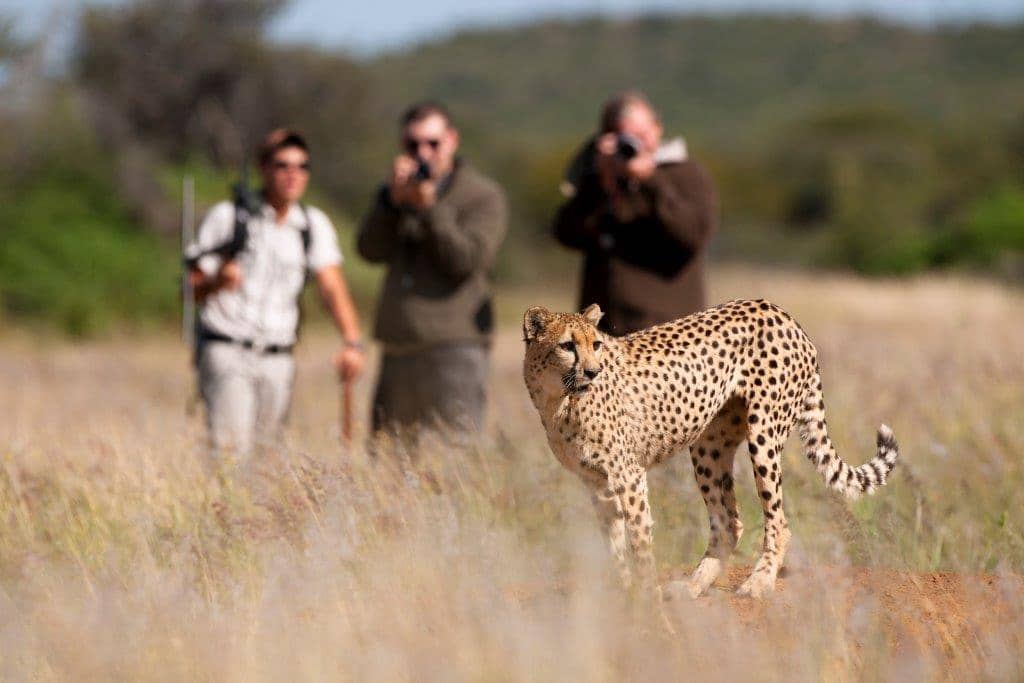
Visiting during the summer’s peak means higher temperatures and afternoon showers, which is a small price to pay for the highlights it affords: fewer crowds, prime birdwatching, and the deep hues of the Namib desert contrasted against lush greenery. Join us on our Green Season Safari —a great value at over $1,500 less per person than for a similar peak-season safari—to explore every corner of this otherworldly destination.
Similar to January, this month’s higher heat, humidity, and chance of rain can often feel like a blessing in disguise, with clear, dust-free air; warm morning game drives; and unique wildlife viewing (Baby animals! Flamingos!).
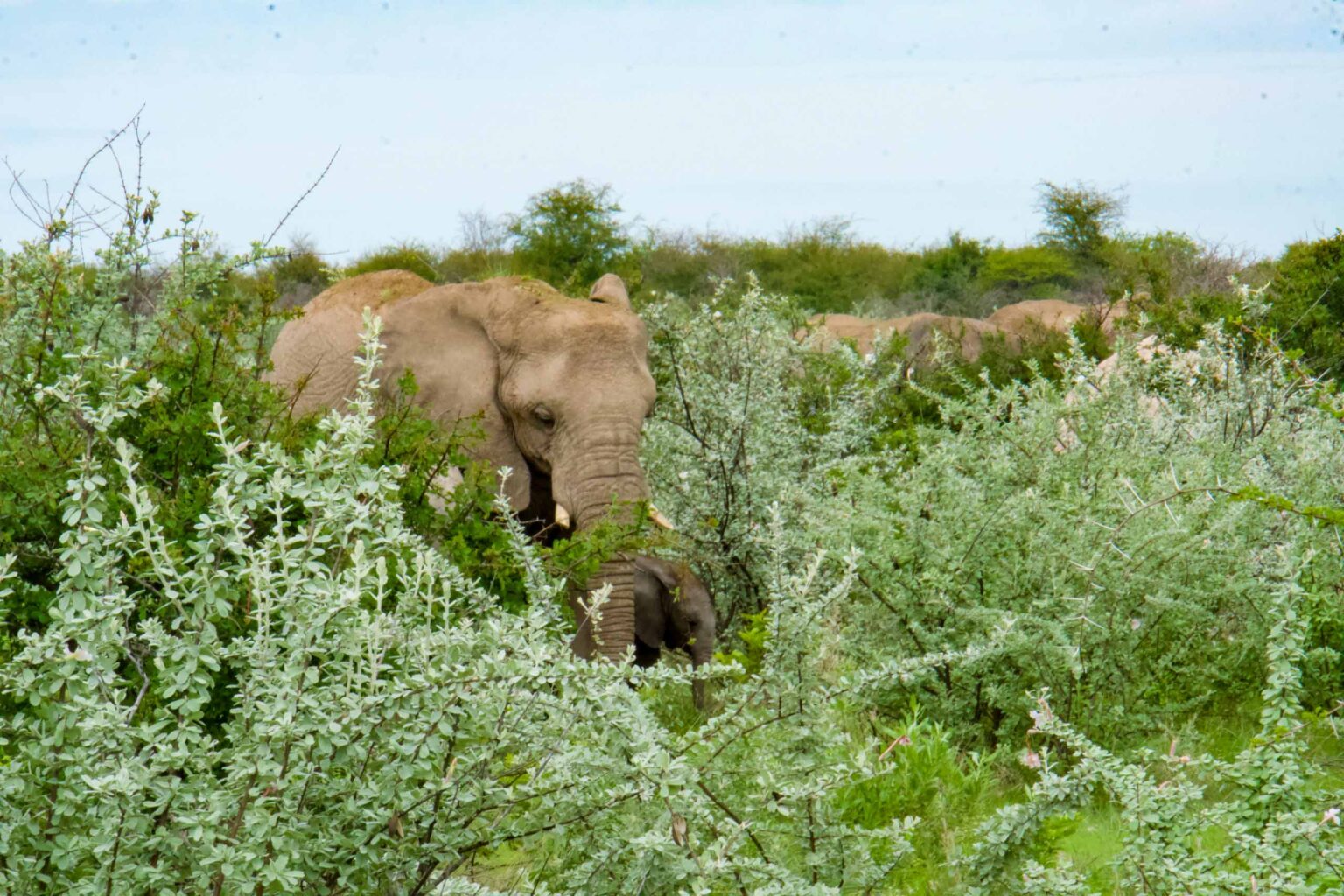
Offering a lovely balance between summer and winter’s unique draws: cooler air yet the chance to see spectacular thunderstorms; pleasant desert mornings and comfortable coastal afternoons. It’s an especially ideal time to visit the iconic Skeleton Coast, one stop on our thrilling two-week Green Season Safari , which comes with a savings of more than $1,500 per person compared with safaris in the busy season.
This month ushers in the end of the rainy season. It also marks the slow start to peak safari season. Our classic Namibia Expedition kicks off this month, and takes full advantage of the shoulder season, from tracking rhino on foot in Damaraland to sleeping beneath the stars in Africa’s first Dark Sky Reserve.
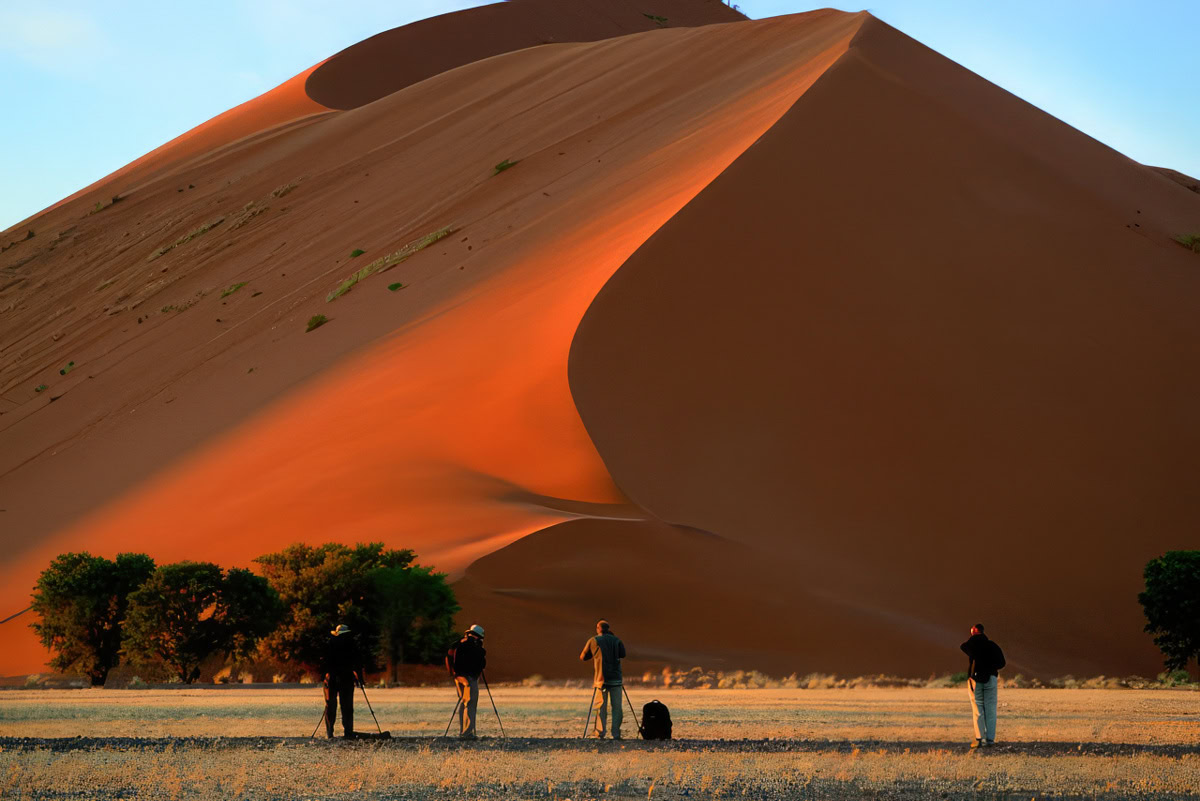
The official start to winter means less humidity and cooler temperatures. Plus, as vegetation dwindles and water sources dry up, Namibia’s unique wildlife (Desert-adapted elephants! Black rhino!) become easier to track and spot. Our Ultimate Namibia and Botswana adventures begin this month, highlighting the best of each destination.
We begin to enter peak wintertime, with chilly mornings and nights, and drier conditions making for excellent game-viewing, especially in the wildlife epicenter of Etosha National Park. Joining our Namibia Expedition and Ultimate Namibia and Botswana journeys is a world-class conservation itinerary: In the Realm of the Desert Lion . This exclusive safari, only offered every few years, takes WT travelers behind-the-scenes of the country’s efforts to protect this unique predator.
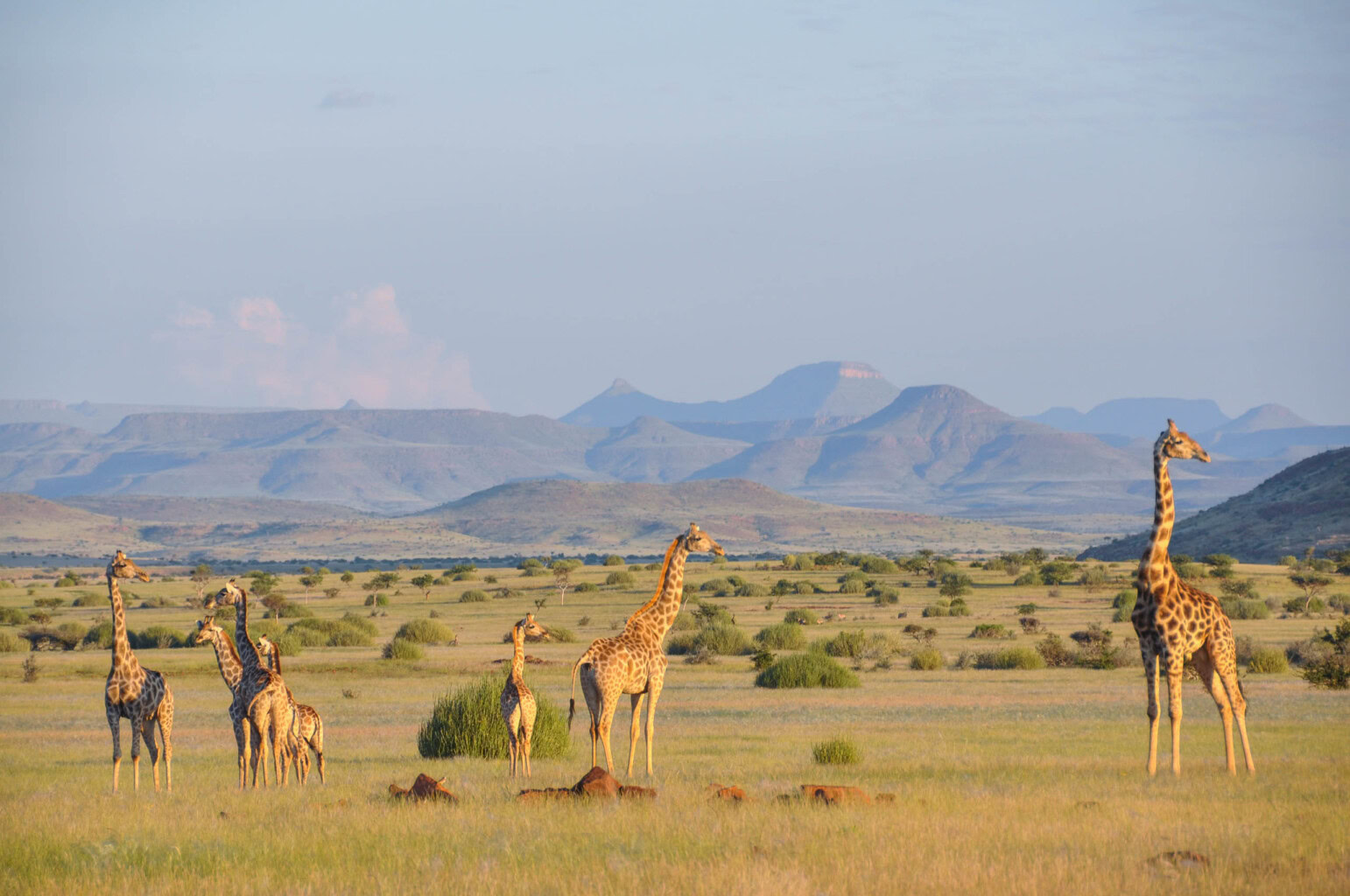
This is the coolest and driest time of the year, which for Namibia’s wildlife means journeying to find fewer water sources. Resulting in scenes straight out of a Disney movie—wildebeest, giraffes, elephants, and more congregating around the same watering hole. This month, join us for a very unique experience: Our Namibia Giraffe Conservation Safari where you’ll have the opportunity to work alongside a leading research team to track and tag giraffes in the wild.
Similar to July, this is an ideal time to explore much of the country, especially the country’s greatest wildlife source, Etosha National Park, and the magnificent Sossusvlei Dunes. While this is the busiest time of the year, our special access to private concessions and reserves means you’ll be far from the crowds.
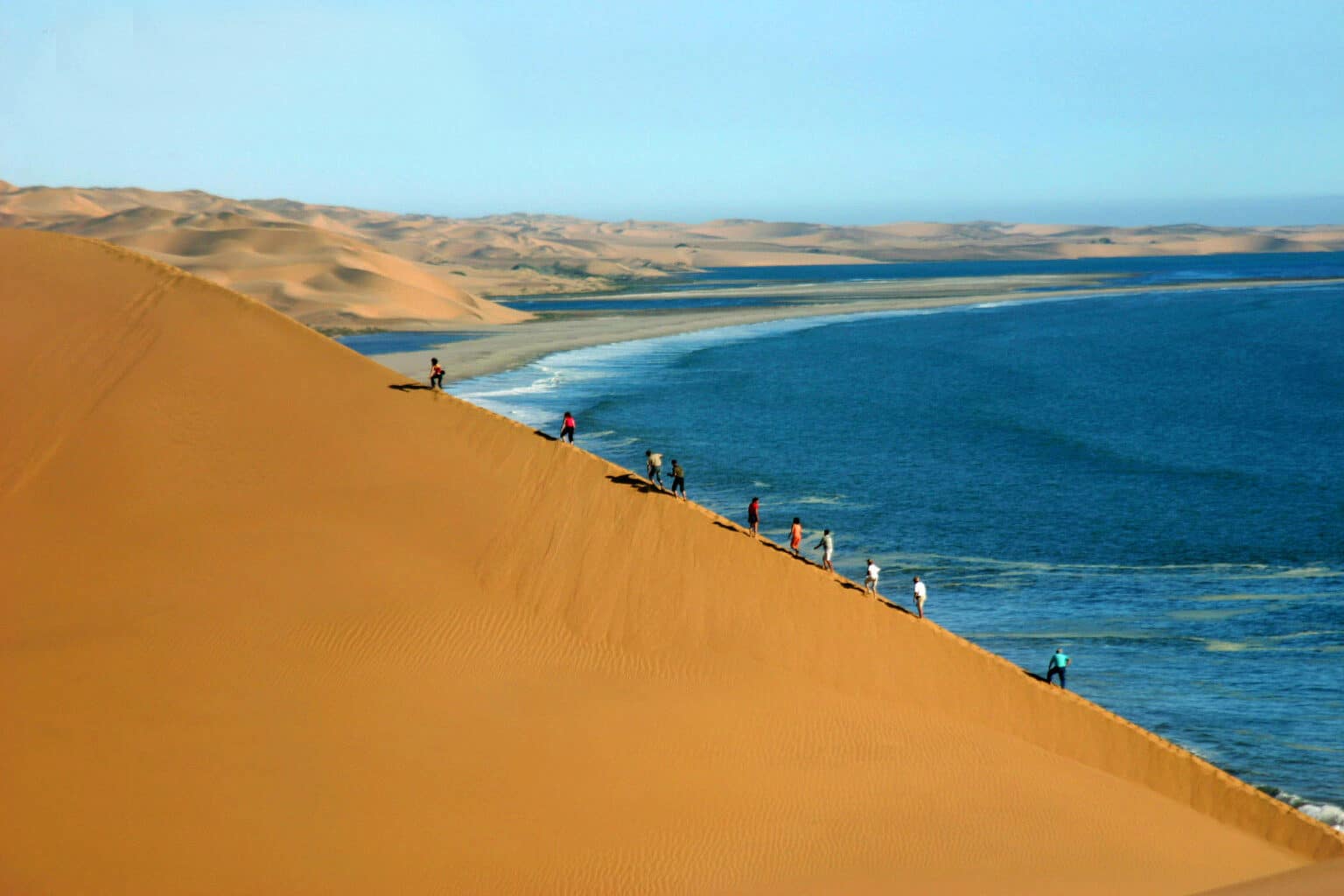
Considered one of the most pleasant times of year due to spring-like conditions, September is when temperatures start to rise but the rain remains at bay. In addition to our classic Namibia Expedition , which gets you off the typical visitor circuit, we offer a departure of In the Realm of the Desert Lion , a conservation safari that’s exclusive for WT travelers.
The end of winter means fewer crowds, though months of little rainfall can often result in dusty conditions and occasional sandstorms. A vestige of the country’s capital, Windhoek, being once a German colony is a lively Oktoberfest celebration. Join us on a Private Journey for an intimate adventure charting the best of Namibia.
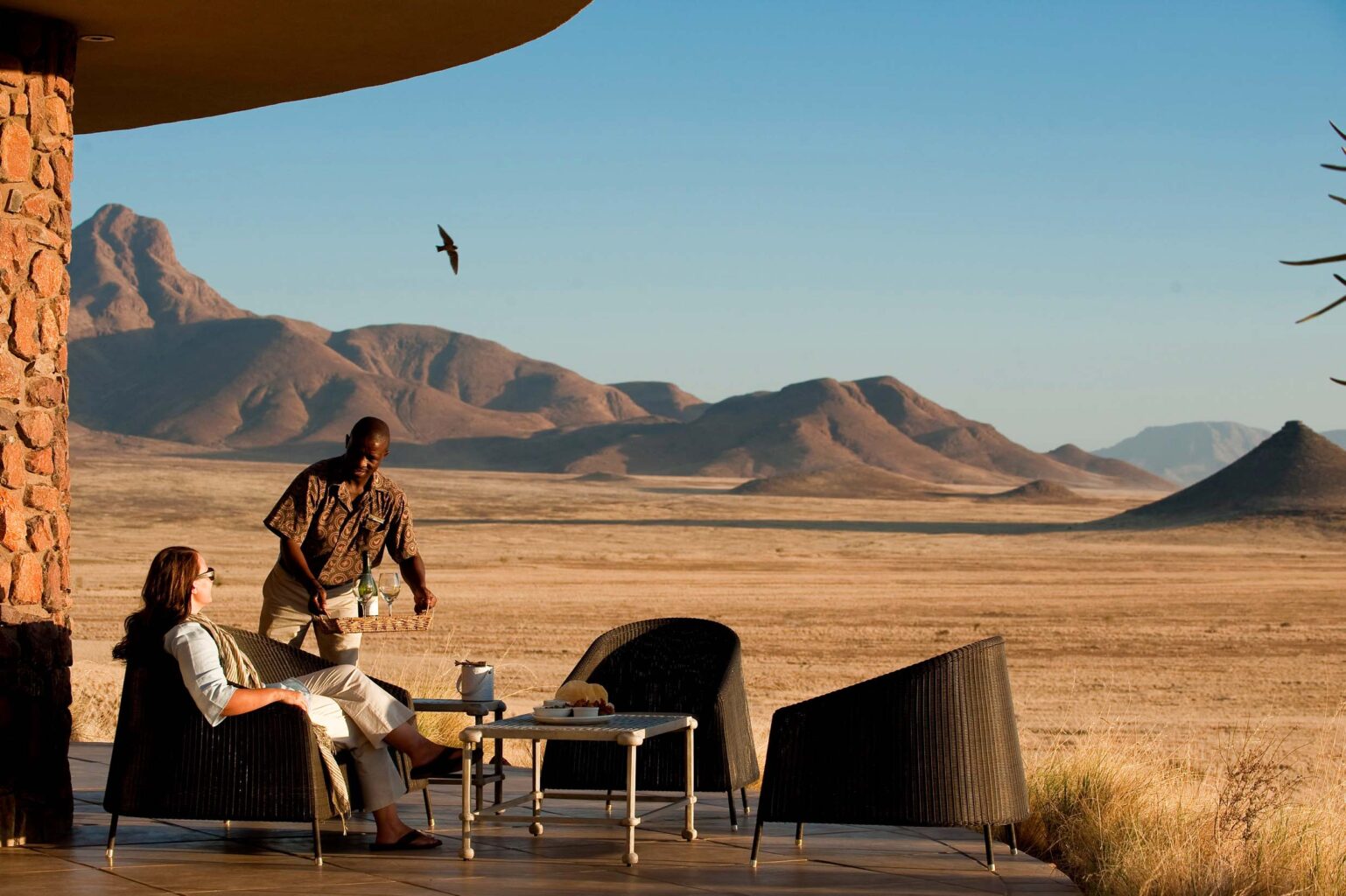
It can be difficult to predict weather conditions this month, when year-to-year variation can mean prevailing winter temperatures and little rainfall, or a strong start to the green season—the first thunderstorm of the year is always a celebration! Plus, it’s the start of prime bird-watching.
Summer is usually in full swing by now, with warmer and more humid days, and nights that are either crisp and clear from an afternoon rainstorm, or cloudy in preparation for rain the next day. The influx of migratory birds, including an abundance of flamingos that coat lagoons in pink, makes for excellent bird-watching.
Namibia’s Weather
We’ve planned our adventure for Namibia’s best season (April through September), when daytime temperatures are in the mid-70s and wildlife viewing is at its peak as waterholes attract a vast array of animals. Nighttime temperatures in the desert can drop to the 50s, so be sure to pack layers for early-morning game drives and our nights on the Tok Tokkie Trail. The coastal region, including Swakopmund and the Skeleton Coast, is cool and dry throughout the year.

All Trips to Namibia
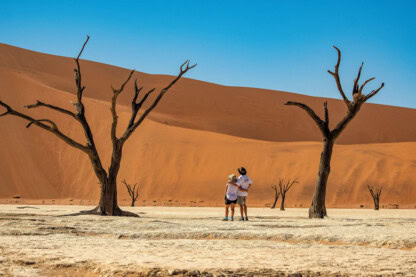
Small Group Adventure
Namibia Expedition
From $9,895
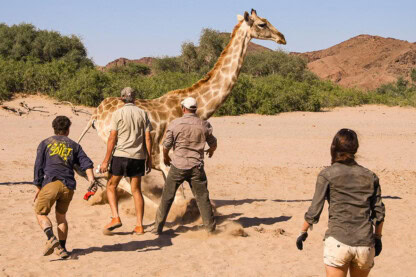
Namibia: Giraffe Conservation Safari
From $10,495
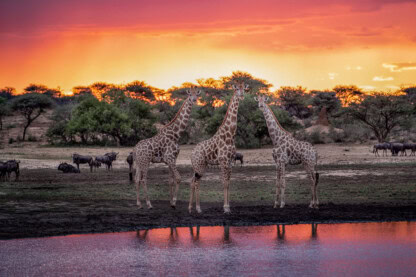
Namibia: Green Season Safari
From $11,995
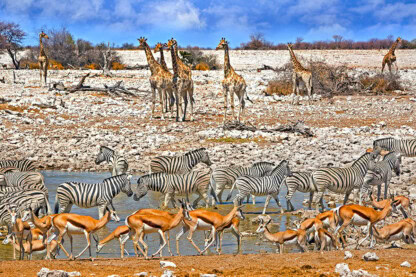
Ultimate Namibia and Botswana
Namibia, Zimbabwe, Botswana
From $12,995
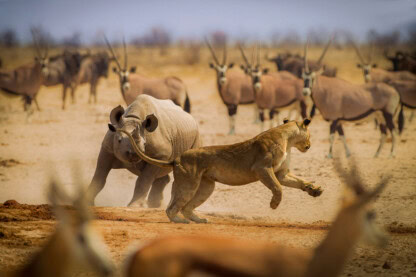
Namibia: Desert Lion Conservation Safari
From $9,795

Private Journey
Namibia Private Safari
Call for Pricing
Talk to an Expert
Our Africa Specialists know every detail about our Namibia safaris. They will be happy to answer any questions and help you choose the journey that’s right for you. Contact us to learn more or book your trip today!

Best Time to Visit Namibia
Warm sunshine, clear skies, and mild evening temperatures make September the ideal month to explore Namibia . Because of the scarcity of water supplies, animals congregate around waterholes, providing excellent opportunities for game viewing.
Speak to a certified Namibia specialist to start planning your tailor-made vacation…
Georgie, Botswana, Namibia Specialist
Month-by-month guide for traveling in Namibia
Visiting namibia in january.
Summer has officially begun in Namibia. Humidity is common, and temperatures can soar to 104 degrees Fahrenheit in the desert and 86 to 95 degrees Fahrenheit elsewhere. Although afternoon thunderstorms are possible, they do not occur daily. The weather is typically clear in the mornings and rainy in the late afternoons.
Events & Festivals
- In the summer, from November to February, birdwatchers can see more than 450 kinds of birds in the Caprivi Strip, making it the ideal time to visit if you’re interested in birding.
- Thousands of flamingos congregate in Swakopmund lagoons throughout the summer months (November–February), making it the ideal time to witness a flamboyance of flamingos.
Visiting Namibia in February
Hot and muggy days with the possibility of afternoon thunderstorms are typical, much like January.
Visiting Namibia in March
As soon as it stops raining, temperatures drop and precipitation levels drop as well. The days are warm and sunny, reaching 86 degrees Fahrenheit, but the nights are getting chilly again, with lows of about 59 degrees.
Visiting Namibia in April
Daytime highs should fall to about 77 degrees Fahrenheit by April, and the rain should have ceased by then as well. Even though the desert can be cooler, nighttime lows can reach 55°F.
Visiting Namibia in May
It is in May that the winter season in Namibia begins. Humidity is low and rainfall is minimal throughout the winter. The depletion of rivers and other water sources causes wildlife to congregate around waterholes.
Visiting Namibia in June
Temperatures dip below 50 degrees Fahrenheit at night, and in arid regions, they can reach subfreezing. However, throughout the day, you can enjoy balmy temperatures in the 70s Fahrenheit under partly cloudy skies.
Visiting Namibia in July – August
The winter months often fall in July and August. Warm clothes are a must for game drives in open vehicles; the temperature can drop to freezing points. Highs range from 70 to 77 degrees Fahrenheit. Even in the desert, temperatures at night can drop below freezing, with lows of 45°F.
Visiting Namibia in September
The most popular season to visit Namibia is in the beautiful month of September. Humidity is still low and temperature is just right, so it’s a perfect temperature for relaxing. The skies are clear and the weather is dry.
Visiting Namibia in October
In October, the verdant foliage begins to wither as the temperature begins to rise. Due to the unusually dry weather, this is an ideal time to watch a sporting event. Daytime highs can reach 84 degrees Fahrenheit, and the desert is significantly hotter.
Visiting Namibia in November
November brings very high temperatures with little humidity. The heat index keeps climbing. The average high during the day is over 86 degrees Fahrenheit. As the afternoon progresses, a possibility of precipitation increases as clouds gather.
Visiting Namibia in December
Typically, December is when we see the first rains, and the temperature drops along with them. After the first rains, the environment undergoes a metamorphosis as vegetation grows and animals disperse in search of new water sources.
Wildlife viewing peaks between June and October
Visiting Botswana at any time of year is a fantastic idea, but the best time to see the animals is during the peak season.
From June to October, wildlife viewing is at its best in many regions, with concentrations of animals increasing as the amount of water on the outskirts decreases. Keep in mind that the nights in June and July, especially in the desert, can get downright chilly—but the days are usually sunny, mild, and just delightful.
In September and October, the temperature rises throughout the day and at night. By mid to late October, the daily temperatures reach a height of approximately 40˚C, but thankfully, it is always dry heat, not humid heat, which is a significant improvement.
Understand the seasons and take advantage of low rates
During the months of January through March, you can anticipate a relatively low volume of visitors while yet enjoying the same exceptional guiding and lodging services at off-season prices.
December through March is when Botswana receives the most of its precipitation. Even though it can be challenging to observe animals due to the thick vegetation, you will still encounter many of species, including newborn calves and many migrating birds. If you can, try to arrive in late April or early May when the weather is still mild during the day and clear at night.
Once a year in April or May, the Okavango experiences its annual “flood.” This causes the savannah to be flooded, leading to the creation of beautiful waterways that are ideal for exploring by Mokoro. As a result, the wildlife in the area comes to concentrate on a smaller number of islands. The amount and timing of rainfall also has a significant impact on local wildlife in the Linyanti Swamps, Selinda Spillway, and Savuti Marsh, influencing factors like the size of buffalo and elephant herds as well as the abundance of predators in the area.
Namibia travel guides
The landscape of Namibia is expansive and breathtaking, featuring the oldest desert on Earth, the tallest dunes, and the second-largest canyon. Skeleton Coast is a great place to see seal colonies, while the expansive plains of Damaraland are the perfect place to go on a trek to see black rhino. The nation is prepared to be discovered in novel ways, from self-drives to hot air balloon tours, and it can accommodate both the most energetic vacationers and those in quest of a little luxury.
If you’re planning a vacation to Namibia , whether it’s a honeymoon or a family safari, our travel guides will be a great asset.
Inspiring Namibia Itineraries
Our goal in creating these itineraries was to provide you with some ideas for what you may see and do in Namibia by highlighting some of the best routes we’ve come across.
Namibia Travel Advice
Even though it feels like another planet, the desolate landscape of Namibia is both welcoming and yet familiar. A land of stark contrasts and brilliant colors, it is a photographer’s dream. Namibia is one of the world’s least inhabited countries, but its hypnotic vistas and vast desert expanses will win the hearts of those seeking tranquility. Namibia exemplifies the best of Africa: a place of boundless grassland and bushland, inhabited by warm, genuine people. The expansive Etosha National Park and numerous smaller nature reserves and ranches provide a safe haven for a diverse array of wild species. Namibia is an exciting destination, but thrill seekers aren’t required to enjoy it.
Places to Visit in Namibia
Many of the destinations we suggest seeing in Namibia can easily be covered in a single vacation. Etosha National Park is a great place for safaris, Damaraland is home to desert-adapted elephants, and Sossusvlei offers sunrise views over burnt orange dunes. From the verdant Caprivi Strip to the rugged Naukluft Mountains with their deep valleys and outcrops to the shipwreck-strewn Skeleton Coast with its sandy beaches, the country’s landscapes are as diverse as the people who live there.
Things to Do in Namibia
There is a lot more to see and do in Namibia than only the animals in Etosha National Park, which is famous around the world. Every drive here is an adventure, what with the towering sand dunes, mist-covered shoreline, and massive canyons.
Climb the tallest sand dunes on Earth at Sossusvlei, paddle with seals at Pelican Bay, or, for a stark contrast, discover the verdant waterways of the Caprivi Strip in this country of limitless horizons and azure sky. Visiting the secluded Damaraland region to see the desert-adapted elephant is another great choice for a Namibian vacation.
Best time to visit Namibia
Book your individual trip , stress-free with local travel experts
Select Month
- roughguides.com
- Travel guide
- Itineraries
- Local Experts
- Travel Advice
- Accommodation
Plan your tailor-made trip with a local expert
Book securely with money-back guarantee
Travel stress-free with local assistance and 24/7 support
A semi-arid country possessing a climate generally characterized by low rainfall and low humidity , Namibia is a year-round destination, though the searing summer temperatures (October–February), which can exceed 40 degrees Celsius in some areas, deter many European visitors from holidaying at this time.
- When's the best time to visit Namibia
- What's the best month to visit Namibia?
Best time for a safari in Namibia
When is peak season in namibia, festivals and holidays in namibia, travel ideas for namibia, created by local experts.
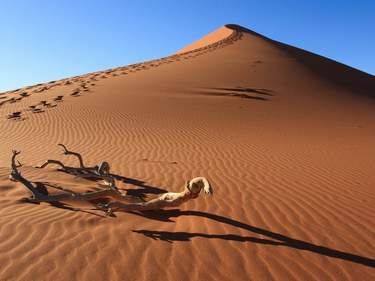
Ultimate Self Drive in Namibia
Explore Namibia on this epic, 10-day self drive trip. Highlights include the Namib, an ancient desert with towering dunes, dramatic mountains and colonial architecture at the waterfront. Additionally, you will visit the Himba people, discover Etosha National Park and more.

Epic Gondwana Adventure: Deserts, Ocean and Wilderness
Experience the best Namibia has to offer with a trip across the country, from the Kalahari to the Namib, the coast to Damaraland, ending off with an unforgettable time in the wildlife-mecca that is Etosha National Park.

Wilderness Safaris by Flight
Take convenient flights to explore the country's remote deserts, luxury lodges, safari camps, and iconic sights, from Sossusvlei's immense dunes to the rugged landscapes of Damaraland and the remote beauty of Kaokoveld.
When's the best time to visit Namibia
The peak tourist season in Namibia is in winter – June to September – which coincides with the dry season : there is virtually no rain and no clouds, so you’ll witness stunning night skies . It’s also easier to spot wildlife during these months as vegetation is sparse and animals are forced to congregate at established waterholes.
Days are sunny but average maximum daytime temperatures are more tolerable – 20–30 degrees, depending where you are – though they plummet at night: at the height of winter ( June–August ) they can drop to between 5 and 10 degrees, even dropping below zero in the desert and more mountainous areas.
The downside of visiting in the Namibian summer is that lodge prices and visitor numbers are often higher, although since the country is so vast, only Etosha , Swakopmund, and Sossusvlei get really crowded.
Start planning your trip to Namibia today! Simply get in touch with our local experts who will tailor a unique itinerary to suit all your wishes.

What's the best month to visit Namibia?
Namibia, a country known for its stunning landscapes and diverse wildlife, offers unique experiences throughout the year. However, choosing the best month to visit depends on what you want to see and do. Below, we take a look at seasonal changes, weather conditions, and different attractions to help you decide which time is right for you personally to travel to this breathtaking country in Southern Africa.
January: Best for green landscapes and bird watching
January in Namibia is characterized by a hot and humid climate, with temperatures typically ranging between 20°C and 35°C (68°F to 95°F). This time of year is characterized by high humidity and frequent afternoon thunderstorms, especially common in the northern regions. The landscape is lush and colourful, making this the best time to visit Namibia for birdwatching enthusiasts.
However, despite the attractive greenery, high temperatures and humidity can seem challenging, and rainfall can lead to mud and make some desert regions less accessible. Nevertheless, fewer tourists during this period can offer a more secluded vacation.
February: Best for landscape photography
February continues the theme of the wet season, featuring heavy rainfall and maintaining the high temperatures seen in January, ranging from 20 to 35°C (68 to 95°F). Continued rainfall contributes to lush landscapes and an abundance of wildlife, especially birds, making this an ideal time for nature lovers.
However, the climate remains challenging: significant humidity and heat can make travelling uncomfortable. In addition, mud can limit access to some areas and activities.
Looking for even more options for your winter getaway? Explore our guide to the best places for a February holiday .
March: Best for off-peak travel
As March arrives, rainfall begins to decrease, although temperatures remain relatively warm, ranging from 18 to 32°C (64 to 90°F). The decrease in rainfall makes travelling easier than in previous months: the scenery is still lush but less crowded, providing a quieter experience.
Although the weather is generally improving, heavy rains can still occur from time to time, which can affect the accessibility of some regions and outdoor activities.
Find even more options for your trip in our list of the best holiday destinations in March .

Lion cubs in Etosha National Park, Namibia
April: Best for hiking in Fish River Canyon
April marks the beginning of the dry season, with cooler temperatures and less rainfall, ranging from 15°C to 30°C (59°F to 86°F). This month is particularly favourable for wildlife watching as animals begin to congregate near dwindling water sources, and the more temperate climate makes travel and exploration more comfortable.
However, you should be aware that evenings can become significantly cooler, requiring extra layers of clothing to keep you warm.
May: Best for game viewing
May in Namibia is characterized by dry weather, clear skies, and moderate temperatures, usually between 10 and 28°C (50 and 82°F). This period is among the best times to visit Namibia for wildlife watching and landscape photography due to its good visibility and comfortable temperatures.
However, mornings and evenings can be quite cool, and as the tourist season begins, visitor numbers may increase in some areas.
Find even more options for your trip in our list of the best holiday destinations in May .
June: Best for desert adventures and star gazing
June is characterized by cool temperatures, especially in the mornings and evenings, with daytime temperatures ranging from 7°C to 25°C (45°F to 77°F). The dry climate and clear skies create ideal conditions for outdoor activities and admire the rugged, beautiful desert scenery.
However, you should be prepared for very cold nights and realize that wildlife may be more scattered, as water is still relatively available outside of the central springs.
Still looking for options for your summer trip? Explore our list of the best destinations for holidays in June .

Waterberg Plateau, Namibia @ Shutterstock
July: Best for desert tours and cultural festivals
In July , at the height of Namibia's winter, mornings and nights can be cold and daytime temperatures range between 5 and 22°C (41 and 72°F).
This is also the best time to visit Namibia as it offers some of the best game-watching opportunities, as animals are more likely to be found near waterholes and the number of tourists is lower than during the peak season. However, the very cold conditions in the early morning and late evening require warm clothing.
Looking for even more ideas for your summer adventure? Explore our list of the best holiday destinations for July .
August: Best for whale watching
In August , temperatures begin to rise, marking the end of winter. Daytime temperatures typically range between 10 and 28°C (50 and 82°F). The rise in temperature means that wildlife begins to gather more frequently at water sources, providing excellent viewing opportunities.
However, it also coincides with the start of the high tourist season, leading to more crowds and potentially reducing the sense of solitude in the wilderness.
Still haven't decided where you're going this summer? Explore our list of the best August holiday destinations .
September: Best for e xploring the Caprivi Strip
Namibia gets warmer in September , with temperatures typically ranging from 15 to 30°C (59 to 86°F), signifying the beginning of spring. This month is known for its peak conditions for wildlife watching and pleasant weather suitable for various outdoor activities.
However, it is also associated with a surge in the number of tourists, resulting in higher prices and potential crowding at popular tourist spots.

Trees and wooden boat reflected in water at sunset, Zambezi river, Namibia © EcoPrint/Shutterstock
October: Best for fishing expeditions on the Zambezi River
In October , temperatures rise significantly from 20 to 35°C (68 to 95°F), marking the onset of the hot season. Wildlife can still be seen during this period, especially near bodies of water, as the heat causes animals to congregate in search of water.
However, the intense heat, especially in desert areas, can be challenging, so early morning and late evening are the best times for outdoor activities.
Looking for more options for an autumn holiday? Also check out our list of the best destinations for an unforgettable holiday in October .
November: Best for hot air balloon rides
November brings hot weather and the start of the wet season, with temperatures ranging from 18 to 33°C (64 to 91°F). The climate change revitalizes the scenery, with greener vistas and an increase in birdlife. However, the weather can be unpredictable and you may encounter both scorching heat and sudden downpours.
This month offers a unique perspective of Namibia as it transitions from dry to wet season, and is suitable for those looking for a combination of adventure and wildlife watching.
December: Best for a beach holiday
December in Namibia marks the full onset of the rainy season, bringing hot, humid conditions with temperatures ranging from 20 to 35°C (68 to 95°F). The rains transform the landscape, creating a lush, colourful environment and improving birdwatching conditions. However, increased humidity and the likelihood of heavy rainfall can affect travel and outdoor activity plans.
Despite these challenges, December offers less crowded vacations and the opportunity to see Namibia's rain-rejuvenated landscapes, appealing to those who prefer more secluded travel and enjoy the vibrancy of the wet season ecosystem.

Sunset in Etosha, Namibia © Lottie Gross
The best time to visit Namibia for a safari is during the dry season, from May to October, when wild animals congregate near water bodies, making them easier to spot. The weather during these months is mostly dry and cool, especially from June to August, providing comfortable conditions for game drives and outdoor activities.
Mornings and evenings can be cold, especially in desert areas, so warm clothing is recommended. The safari season peaks in September and October when temperatures begin to rise, but before the onset of the rainy season. This period offers excellent opportunities for game viewing, but it is also the time when the largest number of tourists are seen.
If you still want to avoid the crowds of tourists and also get good wildlife-watching opportunities, May and June are ideal, offering a balance between pleasant weather and animal visibility.
Want to give your kids an unforgettable safari experience? Read everything you need to know about travelling to Namibia with kids .
The peak tourist season in Namibia runs from July to October, coinciding with the dry winter months. During this period, the weather is mostly pleasant, with warm days and cool nights, making it ideal for wildlife watching and outdoor activities.
Tourist numbers peak, especially in popular destinations such as Etosha National Park and the Namib Desert, due to the excellent game-watching conditions and comfortable climate. Hotel accommodations and tours can be booked in advance, so if you are going to visit the country during these months, advance planning is recommended.

Oshanas, Namibia @ Shutterstock
Bank Windhoek Arts Festival
February–September. Windhoek . Annual festival of the visual and performing arts in venues across the capital, which climaxes in September. Includes the national Triennial Visual Arts competition, in which prize-winning works are exhibited.
Enjando Street Festival
March. Central Windhoek. Also known as Mbapira, this festival sees a two-day extravaganza of music, dance and colourful costumes, attracting groups from all over Namibia.
Sunday closest to Aug 23. Okahandja. Colourful Herero costumes, poetry and military parades remember those who died in the resistance against the German army.
Küste Karneval
August. Swakopmund. Annual German street carnival involving parades, food stalls and plenty of partying for adults and kids.
Lusata Festival
Last week of September. Chinchimani Village, 6km from Katima Mulilo. The annual traditional cultural celebration of the Mafwe people that takes place in the village of the tribal chief, Chinchimani Village, and attracts Mafwe from outside Namibia too.
Oruuano of Namibia Arts Festival
September & November. Soweto Market, Katutura. Organized by the Oruuano Namibian Artists’ Union, involving lots of dance and music.
Windhoek Show
First week of October. Windhoek. The country’s main agricultural and industrial trade fair, accompanied by funfair entertainment, live music and food stalls.
Oktoberfest
Last week of October. Windhoek. A German import, the Oktoberfest draws an international crowd, complete with beer-swilling, games, Lederhosen, Dimdl dresses and oompah bands.
The Rough Guides to Namibia and related travel guides
In-depth, easy-to-use travel guides filled with expert advice.
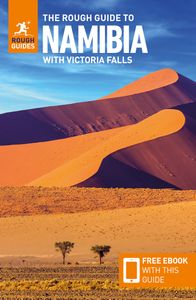
Travel advice for Namibia
From travel safety to visa requirements, discover the best tips for visiting Namibia
- Eating and drinking in Namibia
- Getting around Namibia: Transportation Tips
- Going on safari
- Sports and Outdoor activities in Namibia
- How to get to Namibia
- Travel Health Namibia
- Travel Tips Namibia for planning and on the go
Find even more inspiration for Namibia here

written by Rough Guides Editors
updated 12.06.2024
Ready to travel and discover Namibia?
Get support from our local experts for stress-free planning & worry-free travels.
- Where to stay
- Travel advice

- Namibia safaris
Namibia safari guides – where & when to go, and what to see & do
Wedged between the Atlantic coast and the Kalahari Desert, Namibia is one of Africa’s hidden gems that is slowly emerging as a popular tourist destination, with safaris in Namibia high on the to-do list. A sense of freedom is generated by an epic, empty landscape with wide horizons, unpolluted skies and one of the world’s lowest population densities. These facts, combined with a plethora of large game animals and a frontier feel make Namibia the ultimate photography or self-drive safari destination , and not too bad either if you’re looking for an indulgent luxury safari experience.
The Namib Desert is the oldest and one of the largest deserts in the world , and a predominant feature of the country, extending all the way up the Atlantic coast on the western side of the country. The desert is scored by a number of rivers coming down from the Central Plateau – most of which are now permanently dry, or only flow during the rainy summer months.
The north of Namibia is dominated by the huge, permanently flowing rivers of the Kuene, Kavango and Zambezi, which make up the borders with Angola, Botswana and Zambia respectively. This part of the country is lush and green with dense woodlands most of the year, and home to several small national parks that teem with wildlife and birdlife. The rest of the country is made up of scrubby bushland of the higher Central Plateau, trailing off into the Kalahari desert in the east.
Wildlife in Namibia is varied, and taking a safari in Namibia will allow you the opportunity to see all of Southern Africa’s mammals. As well as the big five , the Namib Desert is home to the exceptional and endemic desert-adapted elephant and rhino. In the Namib Desert and elsewhere in Namibia a truly extraordinary fact is that the country has one of the densest congregations of animals in the world, combined with one of the sparsest human populations, making for fantastic wildlife viewing.
Unlike much of the rest of Africa, habitat destruction is not generally an issue in Namibia, and you can expect to see large mammals roaming the wilderness as you drive between Namibian national parks or towns. This means you need to be ready for a safari experience in Namibia at any time you’re not in a well populated area!
Useful resources
Book a Namibia safari
Namibia wildlife
Namibia Tourist Board
Namibia Wildlife Resorts
Weather in Namibia
Namibia guidebooks
Namibia safari highlights
Sossusvlei’s stunning dunes.

Discover the sand dunes of Sossusvlei with a dawn game drive and hike to top of a dune to watch the sun rise over the Namib desert. The dunes and surrounding area are truly specatular, reaching almost 400 metres high and providing inspiration to any budding photographer.
Self-drive safari in Etosha

Take a self-drive safari tour around accessible but wild Etosha National Park – one of the world’s premier national parks. 763 km of open roads around the park make for the ultimate self-drive safari. The park is based around a huge salt pan, and seems inhospitable to life, but a string of watering holes brings herds of antelope species and their prey from the surrounding scrub.
Fish River Canyon views

Visit the jaw-dropping 100km long, 26km wide Fish River Canyon in the Ai-Ais/Richtersveld Transfrontier Park . It world’s second largest canyon after the Grand Canyon in the US, though with far less tourists visiting, as with all destinations in Namibia it’s both beautiful and serene.
The Walvis Bay ‘marine big five’

The cold waters off the Namibian coast harbor a wealth of marine life, no location more so than Walvis Bay. Styled as the ‘marine big five,, it’s possible to see whales, dolphn, sunfish, turtles and seals on a boat – or even canoe – safari .
Best time to go on safari in Namibia
As with the rest of Southern Africa, Namibia experiences summer between November and March and winter from May to August. From August temperatures keep rising until October when the first rains start to arrive in the northern areas, followed by large amounts of rain and occasional flash-flooding.
The best time to go on safari in Namibia depends on where you’re going, and what you’d like to see. October to March is the best time to visit Namibia’s coast around Walvis Bay and Sossusvlei as the climate provides a pleasant respite from the heated interior. If you’re travelling through the Skeleton Coast region the climate is similar year-round, with regular mist and winds.
For the inland areas of Namibia – including the Namib desert, Etosha and Kavango regions, the cooler months from April September provide temperatures far more bearable than summer months. Between May and September, thirsty animals gather at diminishing waterholes, making it the best time to go to Etosha for game viewing.
Flights To Namibia
Search, track and book flights to Namibia , from anywhere in the world.
Namibia Accommodation
Find safari accommodation in Namibia – from budget campsites to luxury lodges.
Namibia Car Hire
Considering a self-drive safari? Research and book car hire in Namibia .
Activities in Namibia
Search and book things to do in Namibia – tours, excursions and activities.
National parks in Namibia
All national parks in Namibia are administered by the extremely efficient Namibia Wildlife Resorts.
Namibia is an enormous country, and one with large tracts given over to national parks. This gives Namibia the impressive status of being the country with the highest ratio of animals to humans in the world: In short, Namibia’s national parks are fantastic places to visit for safaris and wildlife watching.
A word of warning – the distances between national parks can be huge, and very few roads are tarmacked. A 2WD will serve most of the year in most parts of the country, but rainy season will see even 4WDs struggling in some areas on a driving safari in Namibia.
Top Namibia national park picks
Etosha national park.

A classic African national park – with excellent visitor facilities – housing the ‘big five’ and much more in plains surrounding a huge central salt pan. Herds of elephants, black-maned lions and the world’s largest population of rare black rhinos gather at the 86 waterholes, springs and fountains found around the edges of the pan.
Skeleton Coast National Park

With a reputation as one of the most desolate places on earth, the 20,000 km sq park is one of the most inhospitable and least visited places on earth. Shimmering white dunes, martian rock, beautiful sand beaches and treacherous, rough seas dotted with hulks of shipwrecks make up the park scenery.
Namib Naukluft National Park

The oldest desert on earth, and quite possibly the most beautiful. Namib Naukluft National Park is easily accessible from Sossusvlei, where giant dunes tower 400m into the air, and pockets of long ago dried-out lakes serve as sporadic homes to forests of thousand year old dead trees. In a word, epic!
Cape Cross Seal Reserve

All national parks in Namibia
Use the map to locate all national parks in Namibia. Click the icons for more info.
Get Directions
Babwata National Park: Small national park in Caprivi Strip, unique in that it houses both a large animal and human population.
Cape Cross Seal Reserve: More seals breed at Cape Cross that anywhere else in the world, so if you like seals you’re in for a treat.
Etosha National Park: A classic African national park – with excellent visitor facilities – housing the “big five” and much more in plains surrounding the huge central pan.
Fish River Canyon National Park: A rugged desert wilderness home to the awe-inspiring Fish River Canyon – the world’s second largest canyon.
Khaudum National Park: Remote and wild national park hidden away in the Kavango Region is home to large elephant herds and packs of the endangered wild dogs. A visit here is not to be taken lightly.
Mamili National Park: Little visited .national park in Namibia’s northern Caprivi Strip, offering plenty of classic African wildlife a true wilderness experience.
Mudumu National Park: A riverine national park with undisturbed mopane forest, flood plains and swamps. Unsurprisingly, water-living creatures feature large – crocodiles, hippos, elephants, otters, turtles.
Namib Naukluft National Park: Namibia’s largest park, and one of the world’s oldest and most intensely studied deserts.
Skeleton Coast National Park: Take a drive through one of the world’s most inhospitable spots, with alien landscapes and ancient shipwrecks adding atmosphere.
Sperrgebiet National Park: Recently established desert national park on Namibia’s “forbidden coast”, home to ghost towns, Atlantic coast and hyenas.
Waterberg National Park: Rising 200m above the dry African savannah, the lush green Waterberg Plateau is unique in terms of vegetation and geological makeup.
Other Namibia safari resources
Namibia safari companies.

Whilst self drive safaris are a definite option in Namibia – given most national parks in the country allow this – there are still a number of quality safari tour companies in Namibia that you may want to speak to before arrival in the country. With a fairly well developed regional and international inbound tourist market, Namibia has lots of wildlife activities and safaris on offer. These are supported and promoted by a broad range of safari tour targeting budgets of all sizes and trips of all lengths – from half days trips from the capital Windhoek to two or four week driving expeditions. Check out our reviews of safari tour companies in Namibia .
Namibia safari lodges
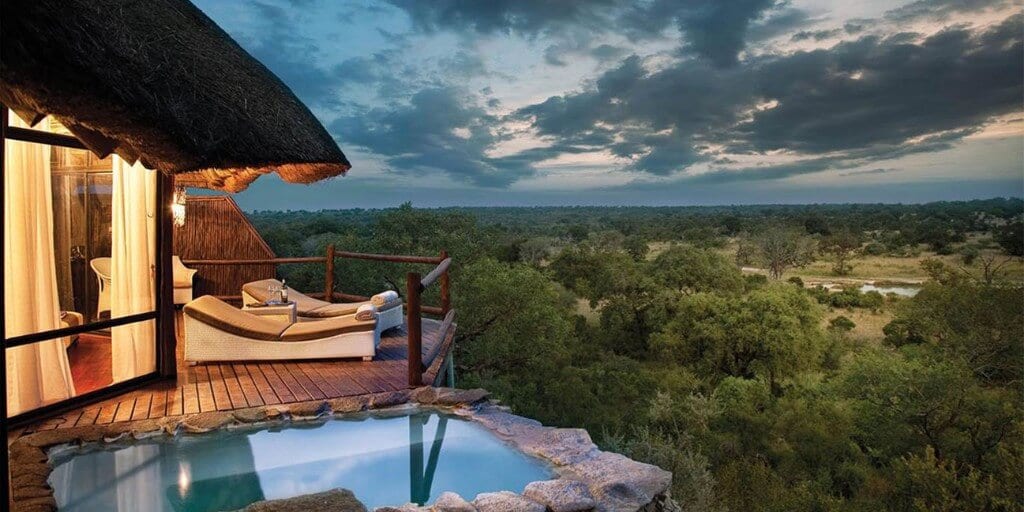
Much like it’s neighbour Botswana, Namibia doesn’t see huge tourist numbers and has a focus on either low-impact, high-end safaris, or self-drive safaris. Safari accommodation on offer in Namibia reflects this, with a broad range of high-end safari lodges around the national parks, and excellent camping facilities for self-drivers attached to most safari lodges. If you want accommodation in a national park, this must be booked in person or by phone with Namibia Wildlife Resorts, who take care of all of Namibia’s national parks. Search and book accommodation in Namibia .
Read safari guides to all countries
Botswana safaris , Namibia safaris , Rwanda safaris , South Africa safaris , Tanzania safaris , Uganda safaris , Zimbabwe safaris
Do you have any experience of planning or going on safari in Namibia?
We’d love to hear any feedback or tips you may have – please get in touch , or add to the comments below.
Top countries for safaris
- Botswana safaris
- Kenya safaris
- South Africa safaris
- Tanzania safaris
- Uganda safaris
Safari basics
- Safari animals
- How to find the right safari company
- When to go on safari
- What to take on safari
- Safari clothing – what to wear
- Safari rules & etiquette
- Wildlife spotting tips
Most read articles
- All about the ‘big five’ animals
- Collective nouns for animals
- Safari movies to watch before you go
- The world’s fastest land animals
- Apex predators
- 10 Fascinating African tribes
- The biggest animals in the world
- 17 Epic hybrid animals
- The world’s ugliest animals
- Why are flamingos pink?
Africa’s best game reserves
- Chobe National Park, Botswana
- Etosha National Park, Namibia
- Kruger National Park, South Africa
- Masai Mara National Reserve, Kenya
- Moremi Game Reserve, Botswana
- Okavango Delta, Botswana
- Serengeti National Park, Tanzania
Session expired
Please log in again. The login page will open in a new tab. After logging in you can close it and return to this page.
- Work With Me

- Sierra Leone
- South Africa
- New Zealand
- Falkland Islands
- Netherlands
- Accommodation
- Electrical Gear
- Essential Gear
- Working Abroad
- Blogging Resources
Africa , NAMIBIA
Best time to visit namibia + 10 other top travel tips for this country.
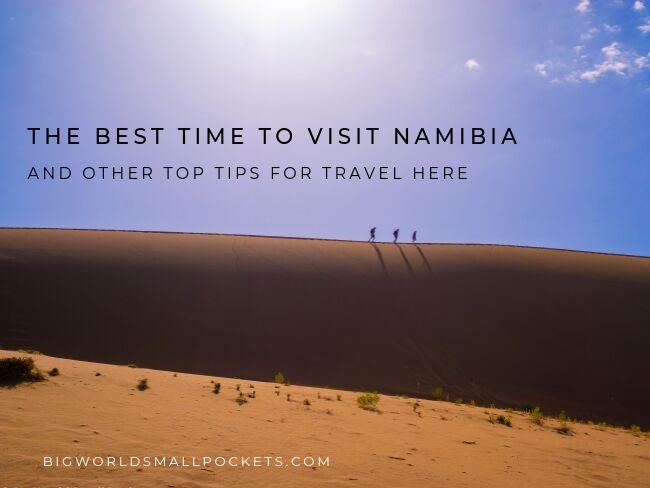
When is the best time to visit Namibia? Keep reading to learn when you should travel to this country and as well as 10 other key tips for your great adventure here…
Oh my oh my, well what can I say, Namibia has to be one of the best countries in Africa to travel if you’re into, well anything really – wildlife, deserts, road tripping, photography, extreme sports, spectacular scenery… just about everything you go to Africa for!
It took me 5 trips to Africa to finally get to this country, but I reckon I saved one of the best till last!
And that’s because Namibia truly is breathtaking.
Safe, a little more developed than many other countries in this part of the world and with some truly mind-blowing landscapes, this is a dry desert, sparsely populated land that is bound to take your breath away.
So if you’re thinking of hitting up this Southern Africa beauty, but still have some questions about when, why and how to do it, then read on to discover my full guide about the best time to visit Namibia and a host of other top tips for planning your travels here…
Related Posts
- How Much Does an African Safari Cost?
- 10 Epic Things to Do in Namibia You Can’t Miss
- Complete Namibia Packing List
This page contains affiliate links meaning Big World Small Pockets may receive a small commission on any purchases at no extra cost to you.
Grab Your Copy of How to Travel Africa for Less
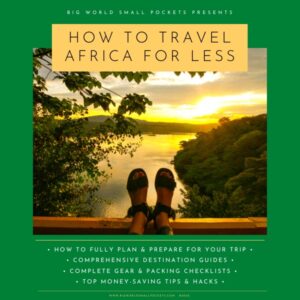
- Full Planning & Preparation Guides
- Detailed Destination Info
- Complete Packing & Gear Lists
- Top Money-Saving Tips & Hacks
Click Here to Check It Out!
What is the best time to visit namibia.
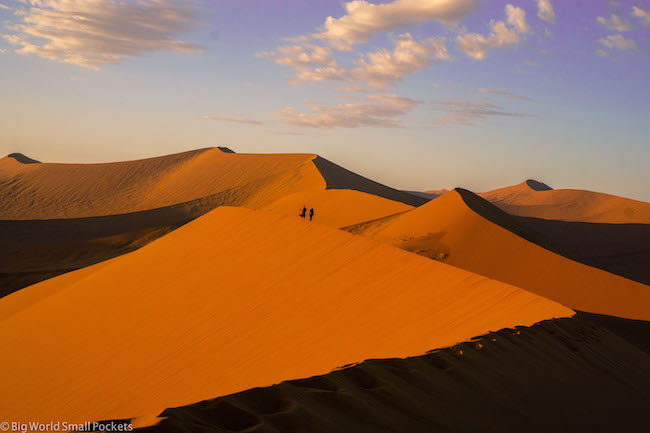
While this country can be visited at any time of the year, probably the best time to visit Namibia is during the months of September through November, with October being the pinnacle month.
This is when the low summer season has yet to begin (meaning you won’t get soaked or too sweaty) and the peak winter season has ended (meaning you can avoid the crowds!)
September to November is also a great time to balance the attractions this country holds.
Indeed these months are one of the best times to safari in Namibia, because the dry water holes mean it’s easy to spot tons of wildlife, especially in Etosha National Park .
These months are also great for exploring and enjoying Namibia’s desert landscapes because the nights and early mornings are not too cold and the rains haven’t yet arrived!
In this way, September through to November is what’s known as the shoulder season in Namibia and offers better prices, fewer crowds and pleasant weather.
In contrast, June to August (known as the winter season) has higher tourist numbers and prices. While the weather is good, parks are busy and camping at night can be freezing!
In contrast, December through March (known as the summer season) can bring very high temperatures, with thunderstorms and heavy rains common as a result.
Both these factors make spotting wildlife very difficult and sometimes travel and access to parks can be an issue too.
I also think the months of September, October and November are the best time to travel to Namibia (indeed they are beginning of the high season across Southern Africa generally) because temperatures aren’t too hot yet.
Because Namibia has the tendency to do just this.
Get too hot I mean!
Which is why it’s so important to think about the best time to visit Namibia.
I visited Namibia in late January and while I was very lucky because there was no rain and I saw a lot of wildlife, it certainly was sweltering.
Thankfully it’s dry heat here (which I can cope with far better than humidity) and the nights were cool, but do be aware temperatures rose to over 35 degrees during the daytime and of course, you’ll largely have to get by without even a fan, let alone aircon!
When thinking about the best time of year to visit Namibia therefore, we can largely say that…
June – August
Known as winter in Namibia, this is the country’s peak tourist season with good, dry weather and lower temperatures. However, the number of other travellers and prices of accommodation etc are high and it can get very cold at night, so bring warm layers.
September – November
Essentially spring, these months form the shoulder season in Namibia with good, dry, weather for wildlife spotting, but lower numbers in the parks and better prices. Waterholes are still dry, meaning animal concentration is high, which is why I put this as the best time to safari in Namibia as well as see the desert. Temperatures are getting hotter at this time however and rain is a possibility towards the end of this period.
December – March
Low season in Namibia brings heavy rains and scorching hot temperatures. Wildlife spotting and travel conditions can be hard at this time and parks are very quiet.
April – May
The 2nd shoulder season and another good time to visit Namibia, this autumn period has good weather with pleasant temperatures and almost no rainfall. The landscape is lush and green and waterholes are full. While this can make for nice viewing and pretty landscapes, it can make wildlife harder to spot however due to foliage cover and the fact animals are more spread out.
How Long To Spend in Namibia?
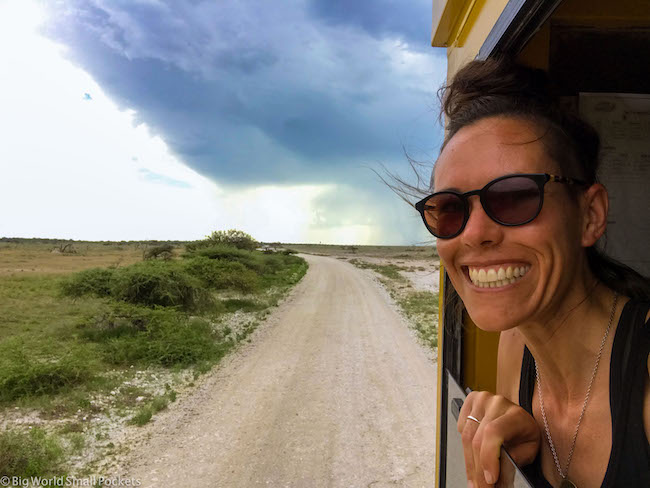
To put it frankly, Namibia is one of the most amazing destinations to visit in Africa.
Nothing can compare to the sort of safari experiences it offers care of Etosha National Park, the desert scenery you can witness at Sossusvlei, the sunsets, the remote camping opportunities, the mixed cultural vibes, the wild ocean experience of the Skeleton Coast and the amount of times it will have you reaching for your camera.
You should allow at least 2 weeks to experience the wealth of Namibia – a) because this is a huge land it will take time to explore and b) because you’ll need this long to really soak up what can only be described as one of Africa’s most unique and memorable landscapes.
LEARN MORE: 5 Epic Southern Africa Itineraries For Your Perfect Trip
How to Get to Namibia?
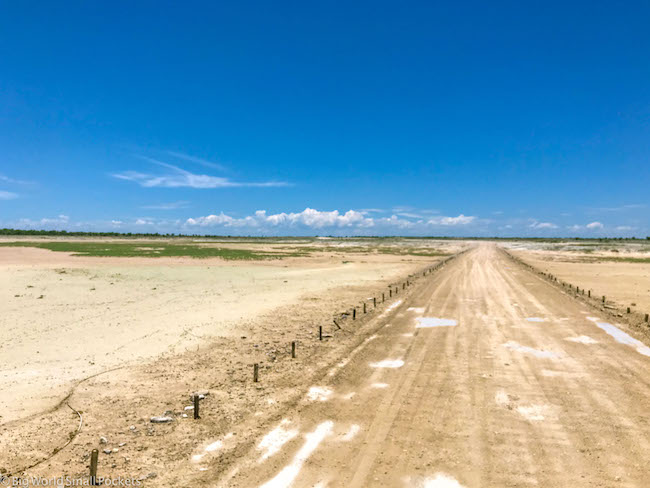
Situated just above South Africa on the west coast of Southern Africa, there are 2 main ways to access Namibia.
Either you can fly into Namibia’s capital Windhoek, which has international arrivals from several destinations in Europe, or you can fly to Cape Town and from there take a cheap budget flight to Namibia.
As always, I use Skyscanner to check for the best prices.
Driving to Namibia is also totally possible and most people access it from South Africa (it’s a 2-3 day drive from Cape Town) as part of an extended road trip or African overland tour between the major Southern African attractions of Cape Town , Botswana and Victoria Falls .
As well as getting to Namibia from South Africa, many people also make the classic Southern Africa route I’ve described above in reverse – starting in Victoria Falls and from there driving into and across the top of Botswana and then crossing into northern Namibia, before journeying south through the country onto Cape Town.
If you’re planning on this, then it’s worth considering the best time to visit Namibia and Botswana together.
When combining these countries, I’d probably pick the autumn shoulder months of April and May as the best time to travel this region, namely because the Okavango Delta will still have a lot of water in it.
Learn more in this post I wrote about the best time to visit the Okavango Delta, which also includes some other key travel tips for this part of Botswana.
How to Get Around Namibia?
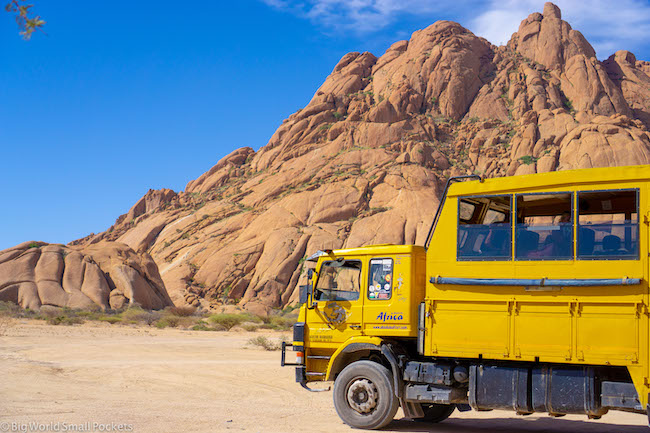
As I mentioned above, Namibia is a very sparsely populated country, in fact it’s one of the most sparsely populated on earth, which means public transport is almost non-existent here and, given the distances you’ll need to cover and how remote many of the top attractions in this country are, it’s also not that convenient when it does exist.
Ditto domestic flights, which are possible, but hugely expensive and will land you in small, remote towns, from where you’ve still got to access the parks and places you came to Namibia to see.
As such, there’s no question, the best way to get around Namibia is via road, which is another good reason to consider the best time to visit Namibia.
This can either be done as a part of a self-drive experience, which is a good budget option if there’s a few of you to share the costs and you feel comfortable with some 4wd driving.
Self-drive options can either form part of a larger Southern Africa excursion, where you rent a car in say Cape Town and drop it off in Victoria Falls, or a shorter, Namibia-only road trip, where you hire a car in Windhoek, make a loop of the country, and then return it back to the capital.
Alternatively, you can take a tour to explore Namibia.
This can be a great option for solo travellers – as it will easily bring you into contact with other friendly nomads and can end up costing you less than hiring your own vehicle.
Tours in Namibia are also great for new travellers or first time Africa travellers who may feel nervous about navigating Namibian roads and destinations by themselves.
Tours take the hassle out of having to organise everything, plan routes and find places to stay etc, and can therefore be a great option for those who are time-poor.
Alternatively, if you’re travelling on a budget, then I highly recommend Absolute Africa.
I loved my trip with them in Nambia because, as a solo female, I made so many great friends and felt totally safe the whole time.
As such, I’m currently offering all my readers (male and female!) an exclusive discount on all Absolute Africa tours, meaning you can now travel even more in this amazing continent for less!
Simply send this top African overland tour company an email to [email protected] , quoting the discount code BWSP, and start planning your incredible trip with them today!
Just enter your details below and I'll email it you - simple!
Information will be sent to the email provided above
Best Things to Do in Namibia
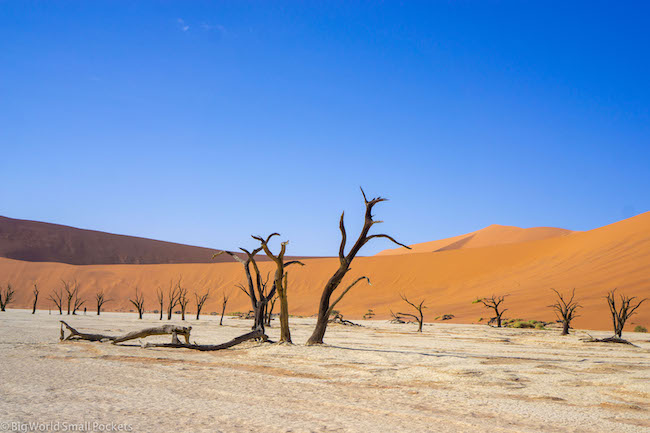
I have written 2 separate posts about the best places to see in Namibia and the best things to do in Namibia, so check those out for some more detailed ideas.
But quickly here, I’ll list the major spots you can’t miss, especially if you choose the best time to visit Namibia well.
Of course, there’s loads of choice for off the beaten track adventure in this country too, which self-driving options in particular will give you more of a chance to experience.
That said, with Namibia being a big country and most people not having a huge amount of time to travel and explore it, I’ll list the most popular destinations below…
#1 Etosha National Park – One of the most spectacular safari destinations in Namibia given it’s wildly different landscapes and plethora of animals. Essentially an ancient, and now dried up pan, watering holes here form the backbone of the animal spotting in this huge park. Allow at least 2 days to drive across and camp in this magical reserve.
#2 Sossusvlei – A dreamy desert landscape that has an eerie ancient forest situated within it, now made famous through Instagram. Dune climbing, desert camping and epic sunrises/sunsets are all part of the experience here.
#3 Spitzkoppe – Essentially a private reserve belonging to the nearby village community, this place has incredible rock formations and some amazing examples of traditional rock art.
#4 Cape Cross Seal Colony – This is meant to be the largest seal colony in the world and the sight of literally thousands of seals, plus the smell of them too, is quite unbelievable!
#5 Swakopmund – A bizarre, German colonial town come seaside resort come African adventure spot in the middle of the desert that offers a huge array of extreme adventures from skydiving to dune biking.
#6 Windhoek – Colourful capital with some lovely colonial-era architecture.
#7 Fish River Canyon – The second largest canyon in the world, which offers some amazing hiking and epic views.
Best Wildlife Safaris in Namibia
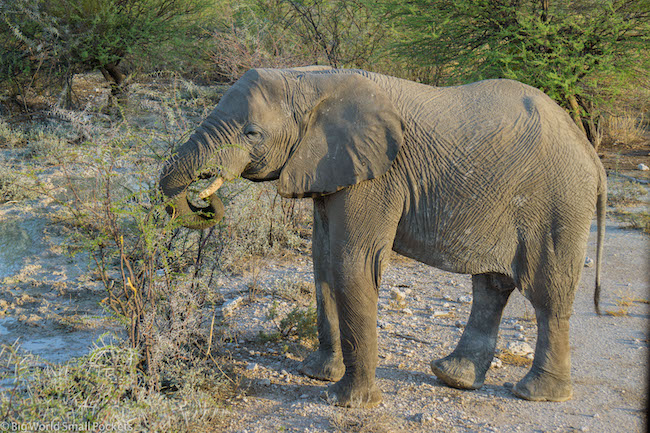
You’ve already heard me talk about the seals you can see in Namibia at the Cape Cross Colony, which definitely provides a very unique wildlife experience here.
But really, the big daddy in the Namibia wildlife crown is Etohsa, situated in the north of the country.
I’ve covered my time there in detail in my Etosha National Park specific post, but this park offers the big 5, as well as a whole host of other classic African animals and is an absolute must-see.
Honestly, it’s easily one of the best parks in Southern Africa, if not the whole of the continent, because of its dramatic landscapes, concentration of wildlife, good facilities / amenities, easy access and awesome camping opportunities.
Spotting wildlife is usually conducted around the water holes throughout the park, where the animals tend to gather in large numbers, but the camps here (there’s 3 main ones, meaning you can spend a couple of nights within the reserve itself) also boast watering holes, which are illuminated at night for some great animal encounters.
And if it’s wildlife you’re after then it’s a good idea to think about the best time to safari in Namibia.
As I discussed at the beginning of this article, June, July and August are peak season in Nambia and a great time to safari if you don’t mind the crowds.
If you want less people around you however, I recommend September, October and November instead as the best months to safari in Namibia because waterholes are still dry (meaning a great concentration of wildlife and better spotting opportunities) and crowds are thinner.
Wildlife spotting is much harder during the rainy season of December through March and thick foliage and full waterholes can make seeing animals difficult in April and May too.
And if you’re looking for the best widlfie tours in Namibia, then it might be useful to know I travelled through this country as part of an amazing adventure with Absolute Africa who I highly recommend for their excellent prices, great customer service, wonderful itineraries and amazing overall experience.
They are especially great for solo female travellers, as it’s easy to make friends and feel very safe with them.
For other great tour choices in Namibia, including those with a more comfortable travel style, that specilaise in safaris, check out these top options .
What to Take to Namibia?
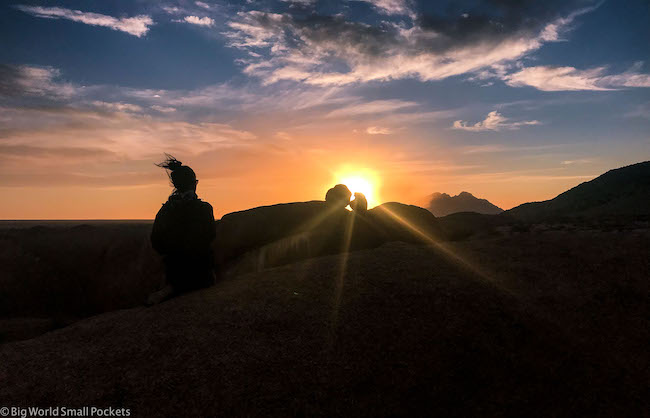
If I’ve not made it clear enough already, then I’ll spell it out now – Namibia is remote and outside of the major towns like Windhoek and Swakopmund, there are almost no shops or supplies available.
Taking everything you need with you as you journey around the country therefore is essential.
This includes:
- Sarongs make great multi-purpose travel items and I love these ones from One World Sarongs
- Toilet paper
- Strong insect repellent, a 30% DEET option is a safe bet
- Small first aid kit
- Headlamp like this Black Diamond Storm , which I have and love!
- Good camera, lens, tripod and cleaning kit – I love my Sony A6000 mirrorless camera which was ideal for capturing the magic of Namibia
- Swimwear and a good travel towel
- Thin, light clothing you can layer
- Camping gear including sleeping bag and a silk liner , which is perfect combination for keeping you warm in those cool desert nights, but also sweat-free when the sun comes up in the morning!
You’ll also need to take enough food and water with you – and lots of it!
I’d suggest at least 5 litres of water per day per person.
Of course, always take all your trash and rubbish back out with you after visiting any areas of natural beauty.
A guidebook would also be good to give you some background info on this country, and the Lonely Planet guide to Namibia and Botswana is a good option.
As it’s very hot in the daytime here (too hot to do much when I was there at least) books to read, games to play or other activities to enjoy in the shade are recommended.
It’s also worth bearing in mind that Namibia’s desert topography means it can get very cold at night, so bringing thick layers to wrap up in of an evening is an excellent idea. A good light, packable, down jacket makes an excellent travel packing item.
At night, you might also need to be careful of animals – never go anywhere alone after dark and always listen for wildlife noises and scan the surrounding area with your headlamp.
Travel Insurance for Namibia
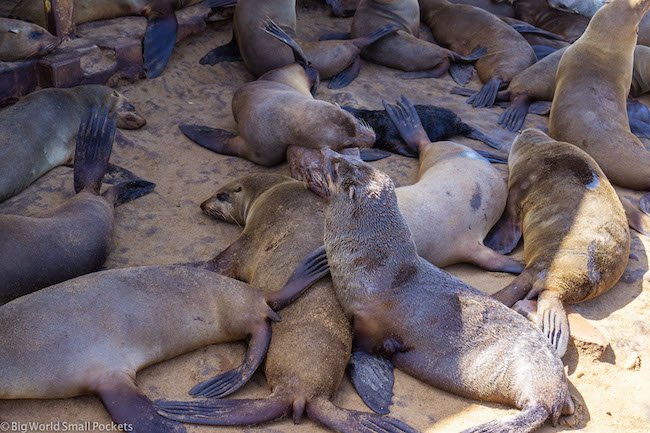
Alternatively, if you’re a long-term traveller, digital nomad or frequent remote worker seeking travel health cover, check out Safetywing’s Nomad Insurance policies.
And on this point, I also always advise consulting a travel health professional before you head to Namibia and educating yourself about the risks of malaria and what you can do to prevent it.
Is Namibia Safe to Travel?
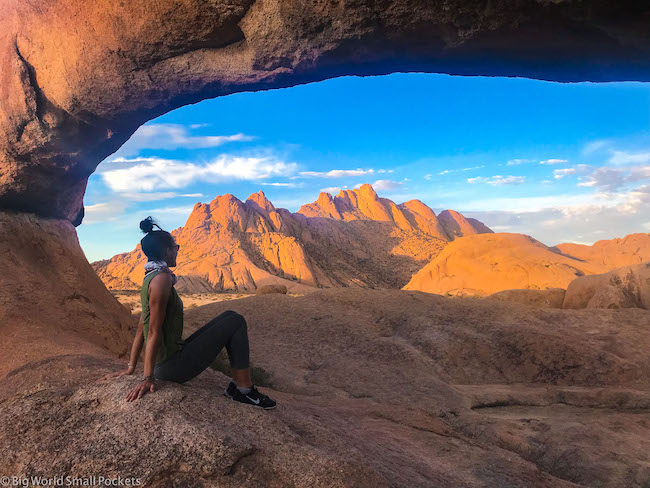
I travelled as a solo female to Namibia and found it very safe.
In fact, I think Namibia is one of the safest countries to travel in Africa.
Of course, there are health considerations to take into account, as well as the dangers of wildlife and driving in remote areas, but by and large I found Namibia a very safe and relaxed place to travel.
Local people are friendly, most of the tap water is drinkable and in the south of the country, you don’t even have to worry about malaria!
That said, as a solo female traveller I wouldn’t walk around by myself in towns or cities at night and I’d have some reservations about driving around and camping by myself too.
That’s why I chose to join a group overland tour in Namibia and highly recommend this option if you are a solo traveller too.
Catering for all budgets, you can enjoy tours that operate on a shoestring with no frills and basic camping included (obvs my option!) right up to luxury tours that offer lodges, private safari experiences and small groups.
How Much Does it Cost to Travel Namibia?
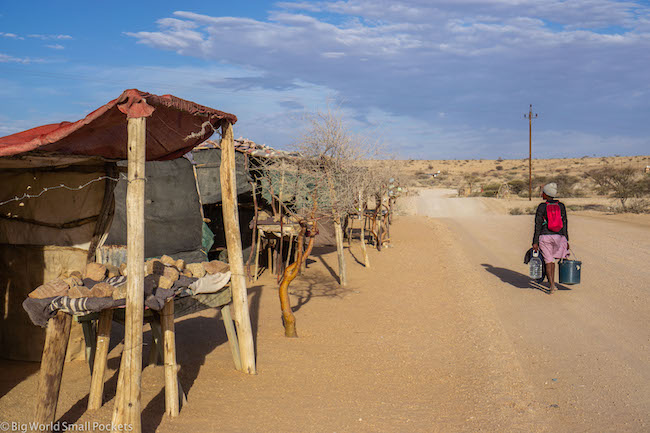
Overall, Namibia isn’t a cheap excursion given its remote make-up and the distances you need to travel to cover the top sights.
Renting a car between a group, to self-drive around the country in a loop from Windhoek and taking camping gear with you, can save you a lot of money.
Otherwise, I highly recommend joining a budget overland tour – I honestly don’t think you can do it cheaper as a solo traveller and it’s a great way to make friends, leave the planning to someone and enjoy the experience with others too.
Most budget tours will take you camping across Namibia and, as there are plenty of campsites around the country, if you’re road tripping too, this will be your cheapest option.
This is exactly how I saw Namibia and if you don’t want to drive alone or have the hassle of trying to find friends to rent a vehicle with, I highly recommend it!
And finally, there are the costs of the activities.
Park fees, guide fees, safari fees, camping fees and fuel all need to be factored in and will vary, depending where you visit, how long for and the distances you cover in Namibia.
Supermarkets can be found in towns across Namibia and are often the best places to source food and drinks, so you can self-cater and keep costs down that way too.
Travel Money in Namibia
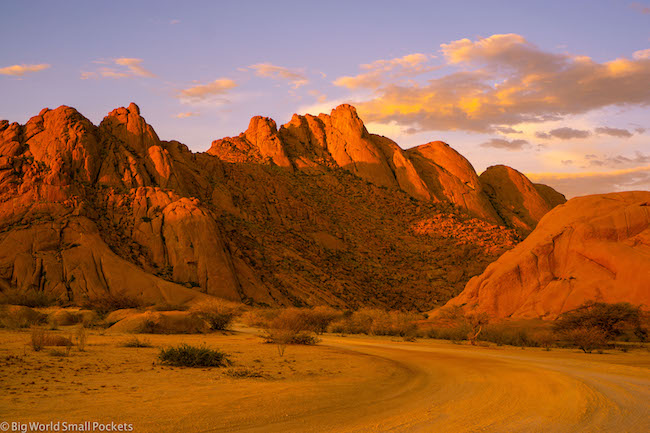
When it comes to paying for things in Namibia, it’s great to know hotels and tours can generally be paid for by card.
ATMs are available in most major towns.
You’ll also want to ensure you’re not being charged overseas transaction fees or getting poor exchange rates when using your card abroad, which is why I always take my Wise card away with me wherever I travel.
The easy way to spend abroad with real exchange rates, no markups and no sneaky transaction fees, you can use your Wise card just like a debit card in Namibia… and it links easily with Google and Apple pay – sold! Get yours here .
PIN IT TO PINTEREST!
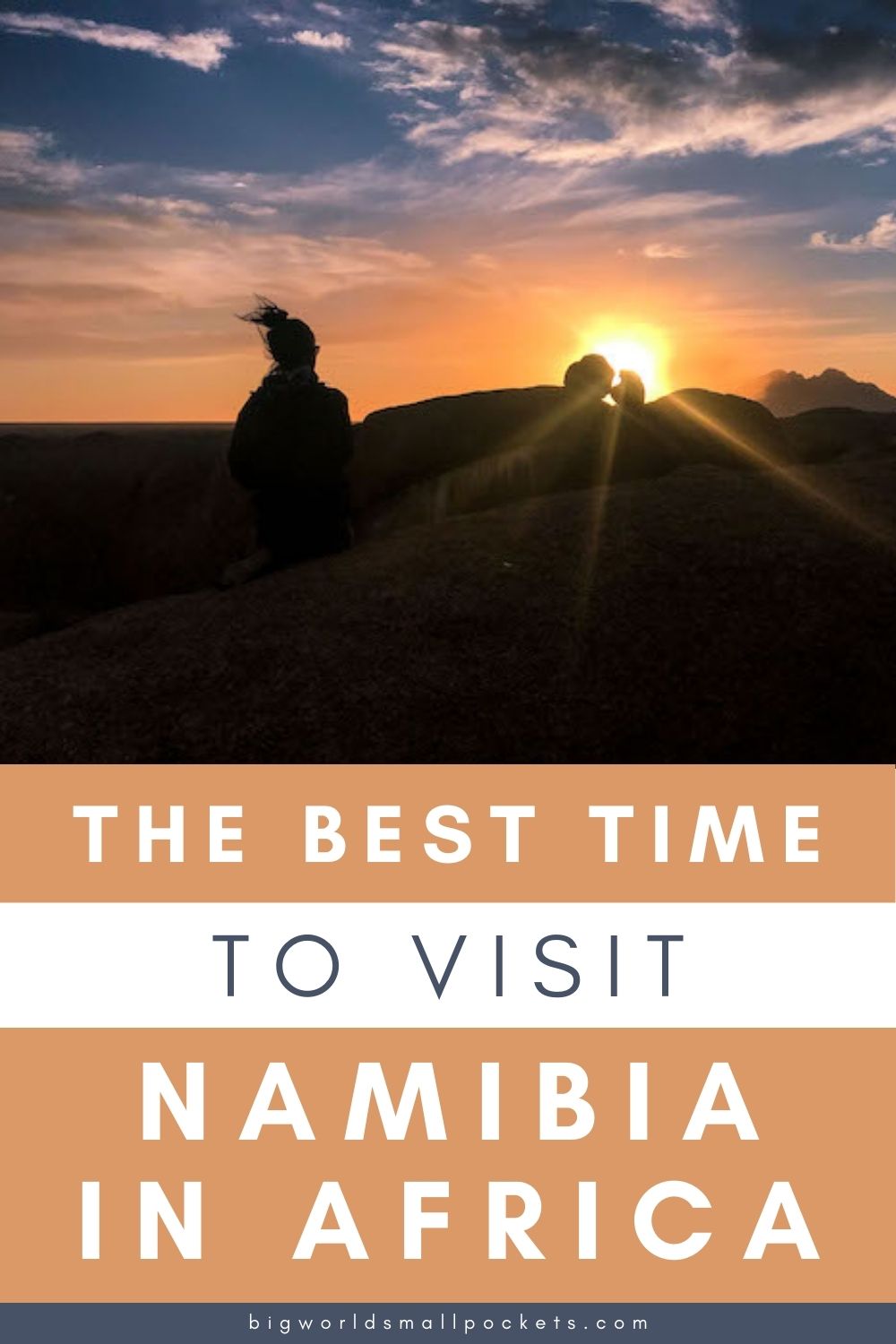
And that’s my complete guide to this amazing country, including the best time to visit Namibia, what to do there, how much it will cost, what you need to take and what you can expect.
Do let me know I’ve missed any crucial information out by firing your questions into this comments box below…
Creator of Big World Small Pockets, Stephanie Parker is a travel addict! Originally from Jersey in the Channel Islands, Stephanie adventures the world collecting tips, advice and stories, to share with a smile
Leave a Reply Cancel reply
Your email address will not be published. Required fields are marked *
This site uses Akismet to reduce spam. Learn how your comment data is processed .

- Find Your Tour
- Heavy Discount
- Enquire / Contact Us
- Send an Inquiry
- Map of Africa
- Contact Details
- African Safari Cost
- Travel Insurance
- Custom Safaris
- All Budget Safaris
- Africa Camping Safaris
- African Safaris for Seniors
- Exclusive Small Group Camping Safaris
- Gorilla Trekking Safaris & Tours
- Lodge Safaris
- Short Stay Tours
- All Overland Tours
- Camping Overland Tours
- Exclusive Overland Safaris
- Lodge Africa Overland Tours
- All Family Safaris
- Family Camping Safaris
- Family Lodge Safaris
- Family Safaris in East Africa
- Family Safaris in Southern Africa
- All Adventure Travel
- Great White Shark Diving
- Walking Safaris & Hiking Tours
- Chobe National Park
- Etosha National Park
- Kilimanjaro
- Kruger National Park
- Ngorongoro Crater
- Okavango Delta
- Sabi Sands Game Reserve
- Serengeti National Park
- South Luangwa National Park
- The Garden Route
- Victoria Falls
- Zanzibar Island
- Masai Mara Conservancies
- Namib Desert
- Pilanesberg National Park
- South Africa
- Kingdom of eSwatini
- Dar es Salaam
- Johannesburg
- Livingstone
- Antananarivo
- Adventure Travel & Activities
- Africa Beaches & Islands
- African Animals & Conservation
- African Culture
- Best Things to Do
- Big 5 Safari
- Bucket List Ideas
- Family Safari
- Overland Africa & Budget Safaris
- Places in Africa
- Safari Costs & Budgeting
- Travel Tips & Planning
- Where to See
- Botswana (Okavango Delta +)
- Cape Town + Garden Route
- East Africa
- Kenya (Masai Mara +)
- Kruger + Sabi Sands
- Morocco + Ethiopia
- Namibia (Etosha +)
- Rwanda + Uganda
- South Africa, Lesotho + Eswatini
- Southern Africa
- Tanzania (Zanzibar, Serengeti +)
- Zambia, Zimbabwe + Malawi
- Safari Costs
- Client Reviews

When is the Best Time to Visit Namibia for Safaris & More?
The best time to visit Namibia is generally during the country’s dry winter season, which runs from May to September. This is when the days are warm, but not scorching hot.
As a largely desert-covered country, Namibia sees extreme climatic changes throughout the year. From over 100°F in summer, down to freezing at night time in winter, temperatures in Namibia can vary wildly!
This means that to understand more about the best time to travel to Namibia, you first need to understand the country’s weather patterns…
Namibia’s Climate & Seasons
While regional variations do occur, Namibia's climate can generally be divided into three main seasons.
The hot and dry season (the first part of the country’s summer) runs from October to December. During this time, temperatures can be scorchingly high!

This hot and dry time of year is then followed by the hot and wet season (also known as the 'rainy season') which occurs from January to April. This is the second part of the country’s summer.
During this time, temperatures stay high across Namibia, with increasing humidity and some rainfall.

Lastly, Namibia's dry, winter season runs from May to September, bringing with it cooler temperatures and a dry, less humid, climate.
Being such a vast country, you will however, experience different climates in different regions of Namibia, so it’s worth doing your research before travelling.
As a useful starting point, here’s our advice on the best times to visit this incredible country.
Overall Best Time to Visit Namibia
Overall, the best time to visit Namibia is from May to September - the country’s dry, winter season - when temperatures are more comfortable, the skies are blue and the chance of rain is low.

The lower humidity during these months is also more pleasant, and the risk of malaria is at its lowest at this time too.
Starting off at the beginning of the dry winter season, there are definitely some benefits to a Namibia safari in May and June. These can be great months to visit, as the country emerges from the wet season, meaning a pleasant freshness and less dust in the air.
The country’s landscapes also look amazing, with much of the vegetation still lush and green, and prices may also be lower during these months.

Moving on, the dry winter months of July and August are a great time for wildlife viewing in Namibia, and happily coincide with the US school summer holidays, making the perfect time for a family trip!
However, bear in mind, that this is peak travel season in Namibia so you’ll need to plan your Namibia safari well in advance and should expect to pay a little more.
Also be aware that, while days are generally warm in July and August, nighttime temperatures can drop to below 50°F, and, in desert locations, it can even get down to freezing! As such, be sure to pack a thick sleeping bag if you’re camping on your Namibia safari. You'll also want to pack warm clothing for nighttime game viewing at Etosha's spotlit waterholes and for the evening and early morning game drives, which can be chilly in open vehicles.

Later in the dry, winter season, September is also a nice time to visit Namibia because it’s generally not too cold at night.
But trust us when we say you’ll want to pack a lip balm and lots of moisturizers at this time - deep into the dry season, there is very little humidity in the air, making for very dehydrated skin!
By October, the daytime temperatures are beginning to climb, regularly reaching 85°F and even hotter in the desert as summer commences. If you’re planning a family Namibia safari this may not be ideal!
Best Time for a Namibia Safari
Once again, the dry winter months from May to September are widely regarded as the best time for a Namibia safari, especially in Etosha National Park, the country’s most popular wildlife destination.

Because there’s little to no rain and the humidity and temperatures are lower at this time of year, the weather is ideal for pleasant game drives.
It’s also the best time of year for wildlife spotting because the continuing lack of rain causes many water sources to dry up across the parks and reserves. This then drives animals to converge in large numbers at the few remaining watering holes, increasing the concentration of wildlife in these places and heightening the chance of excellent safari experiences!
Indeed, it’s common at this time of year to see a big variety of wildlife – including elephant, zebra, giraffe, gazelle, and wildebeest – in large numbers, all drinking together.

The country’s game parks are quieter in May and the start of June, but can get busy in July and through September due to the school holidays. During these months, make sure to book well ahead!
One caveat here is if you’re more into birdwatching tours than game drives in Namibia.
If this is the case, the best time to travel to Namibia is during the rainy season - typically between January and April. This is when many migratory species visit the country, adding to the array of amazing birding opportunities.
Best Time to Combine Namibia with a Visit to Botswana or South Africa
While visiting southern Africa, many travellers will combine a trip to Namibia with a visit to one of its beautiful neighbouring countries - likely Botswana or South Africa.
And why not!?

When you’ve come all this way for an amazing adventure, it would be a shame to skip over these incredible bucket list opportunities too!
We have a range of safari tours that encompass some of Botswana or South Africa’s main attractions, meaning both these countries can be easily included in your Namibia safari trip, no matter how many days you have on your itinerary.
But when should you go?
For a safari trip that combines Botswana and Namibia, the best time to visit is again from May to September.
Botswana’s dry season largely overlaps Namibia’s, with May through October being the best time for wildlife spotting in Botswana and also the best time to travel to the Okavango Delta - one of Botswana’s most stunning safari destinations.

This makes a combined trip to Namibia and Botswana easy to plan!
You can see our range of great tours that encompass the best these two beautiful (and contrasting!) countries have to offer here .
It’s also very common for travellers to include a visit to Cape Town in their Namibia travel plans, with many Namibia safari tours starting or ending in ‘The Mother City’ , as Cape Town is affectionately known!
This is no surprise given the drive from Cape Town to the Namibian border is relatively short, and that international flights from Cape Town to Namibia’s capital, Windhoek, are both frequent and affordable. But when it comes to planning a trip that combines a visit to Cape Town and Namibia, a bit more thought is required. That’s because Cape Town has a very different weather pattern to Namibia.
The best time to visit Cape Town is really between November and March, with this being the country’s summer season when the weather is definitely more favourable. That being said, the autumn months of April, and even May, can still be very pleasant in Cape Town.

So with this in mind, April and (depending on your priorities) May, or October might be the best time to travel to Namibia if you also want to make the most of Cape Town’s warmer weather.
So that’s our guide to the best time to visit Namibia.
If you want some help planning your Namibia safari adventures, and to find some of the most affordable deals, talk to one of our African travel experts .

Stephanie Parker Author
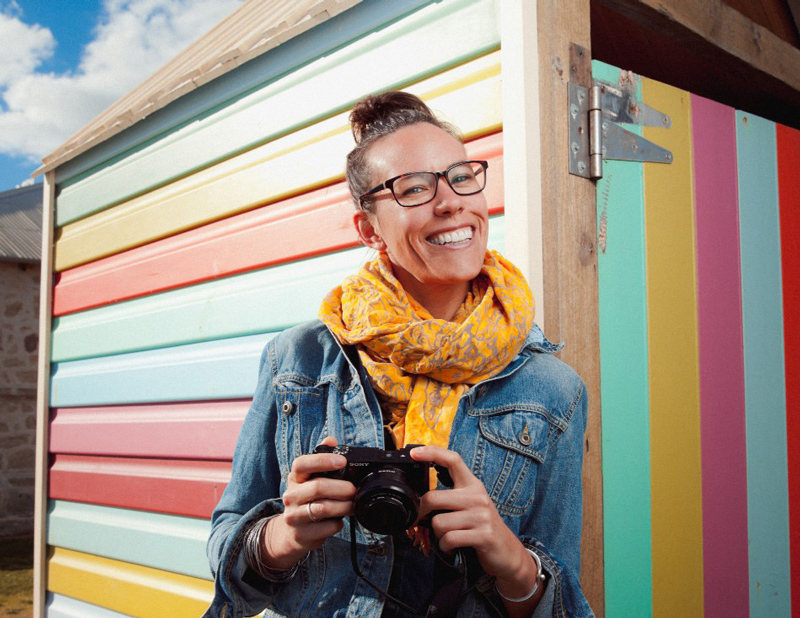
Related Destinations
Explore these destinations mentioned in this post.
__thumb.jpg)
Private Group?
A private, tailor-made safari is within your reach. Experience all of your bucket-list safari related items on a budget now.
Similar & Related Blog Posts
Below you'll find further reading and articles related or similar to this post.

15 of the Best Namibia Safaris on a Budget
If you're searching for a cheap (but not nasty), high-quality Namibia safari this post is for you. This shortlist of the Best Namibia…

Know any Namib Desert facts? Get ready for a Namibia Safari worth remembering
The Namib Desert is one of the oldest and driest deserts in the world. Namib, meaning “vast” in the Nama language, is home to over 3,500 species…

Why Visit South Africa & Namibia on Your African Safari?
You’ve decided to finally book that dream holiday: an African safari. Each African country offers its own unique points and none of them lack incredible…

Explore Namibia on the ultimate 10 day budget camping safari
Which is the best Namibia Camping Safari on a budget? This 10-day Explore Namibia Camping Safari is one of the best budget adventure…

10 Best budget Windhoek hotels: the top places to stay in Namibia’s capital
Namibia is a land of vast open spaces, red dunes, desert, and wild coastline, all scattered with wildlife. Windhoek, Namibia's capital city, is the…

Can’t afford a space trip to Mars? A Namibia Safari is Way Better Anyway
With the signing of an American law stating that manned missions to deep space, including to Mars, will be NASA’s primary goal, and the…

Best Time to Visit Botswana for an epic Wildlife Safari
It’s generally acknowledged that May to October is the best time to visit Botswana, but we think it’s a bit more nuanced than that! After all,…

The Best Time to Visit South Africa? Cape Town to Kruger & More
If you’re wondering about the best time to visit South Africa, then the chances are you’re already sold on the amazing travel experiences this…
These trips cover similar ground…

10 Day Explore Namibia Private Safari Tour
This small-group Namibia Private Safari Tour explores the Namib Desert, Swakopmund, Brandberg, Damaraland, Etosha National Park and Waterberg Plateau.

12 Day Namibia Self Drive Safari
The Namibia Self Drive Safari saves time and money. Explore Etosha, Namib Desert and more on an independent Namibia tour - accommodation and car hire arranged.
__large.jpg)
3 Day Etosha Private Safari in Namibia
A Private Namibia Safari to Etosha National Park, Namibia's best national park. Explore Etosha on guided game drives in a 4x4 safari vehicle staying at…

3 Day Private Namibia Safari to the Namib Desert
This Private Namibia Safari to the Namib Desert travels in a small group by 4x4 vehicle, staying at a comfortable lodge near Namib-Naukluft Park. Explore…


4 Day Swakopmund & Namibia Desert Private Safari
A short Private Namibia Safari to Swakopmund and the Namib Desert. Start and end in Windhoek, exploring seaside Swakopmund, Sossusvlei and Namibia's Desert.
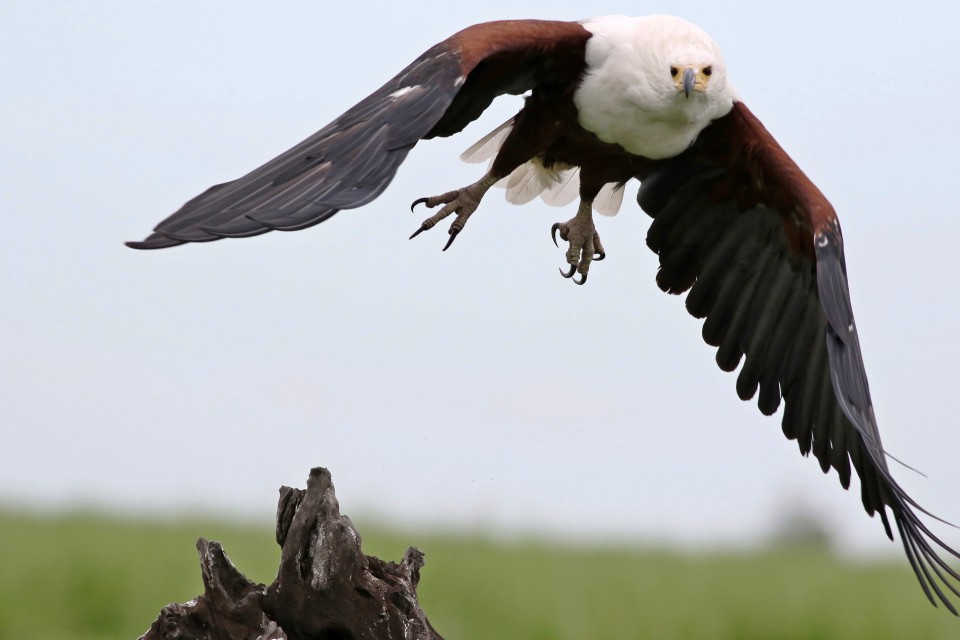
12 Day Namibia & Botswana Safari: Swakopmund to Victoria Falls Camping Tour
Travel overland from Swakopmund, Namibia to Victoria Falls on this Namibia & Botswana Safari. A budget camping tour to Etosha, Okavango Delta, Chobe &…
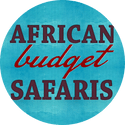
Connect with us
Useful resources.
- Get Travel Insurance
- Book Flights
- Get Car Hire
- Signup for our newsletter
Popular Destinations
Latest blogs.
- How to plan an African safari on a very tight budget: the 8-step guide to safari planning
- Top 10 Safest Countries in Africa to Visit (2024 Global Peace Index Rankings)
- Best Countries to Visit in Africa? Here are 15 Amazing African Countries
- South Africa Tipping Etiquette: 8 Top Tips for Tipping in South Africa
- How Much Does an African Safari Cost? Your Budget Africa Safari Guide

Call us toll free from US/Canada on 1-888-414-6513 , or from the UK on 0-808-189-1052 . All other countries can contact us on +27 21 791 0878 .
© 2024 African Budget Safaris | Privacy | Terms | Cookie Policy | Consent Preferences
Beach Destinations
Northern Africa
South East Asia
Australasia
New Zealand
UK & Ireland
Mediterranean
South America
Central America
Middle East
- Itineraries
True Collections
Holiday Types
The Art of the Wild
About True Travel
Positive Impact Travel
Visit us: 208 Fulham Road, London, SW10 9PJ
True Travel

A Monthly Guide
A month by month guide to namibia.
Covered by vast swathes of the Namib and Kalahari Deserts, Namibia is a true year-round travel destination, with an incredible array of experiences to enjoy no matter what time of year you choose to travel.
The large disparities between the winter and summer weather can dictate when to visit if you have specific interests and activities you wish to enjoy, but if you are simply looking to enjoy this remarkable destination then there are no poor times to travel. In general visitors to Namibia will drive themselves in a 4×4 rental vehicle and the road network remains in good condition throughout the year, but guided safaris, as well as fly-in options are also worth considering when visiting some of the more remote and unusual areas.
Unlike many other sub-Saharan African countries the focus isn’t purely on wildlife viewing here, with incredible landscapes and adventure activities part of the allure of a visit as well.
Regarded as the peak of the Namibian summer time, January sees the country at both its warmest with temperatures peaking towards 40 degrees celsius (105 degrees fahrenheit) and wettest with spectacular storms seen every few days. If you can cope with the heat then it can be a hugely rewarding time to visit as the rains turn the normally dry and barren deserts into a carpet of lush green grasses and wildflowers.
Game viewing can be challenging at this time of year with surface water more readily available, but the iconic Etosha National Park remains an ever-reliable place to see wildlife, especially rhino and lion which love the many waterholes that can be found around the park.
Owing to the heat, activities are often restricted to being on vehicles rather than walking based activities, but short walks early or late in the day are offered from most properties.
Once the New Year rush is over prices drop to their lowest levels where they remain until the end of the summer months.
As with January, the hot and often stormy days persist into February, with the moody grey skies and carpet of green on the desert floor offering an especially appealing backdrop for photographers.
It is also an outstanding time for birders, with the areas around Spitzkoppe in the southern part of Damaraland and the coastline around Swakopmund and Walvis Bay especially popular, as is the Etosha National Park. The plains game in Etosha are starting to give birth to their young which does mean some incredible predator interactions can be enjoyed – a raw but fascinating insight to life in the bush.
Summer cruises along the coastline from Swakopmund are great fun at this time of year and the huge temperature difference between the cold Atlantic Ocean and roasting hot desert can make for spectacular fog banks coming in later in the day – best enjoyed from the deck of your hotel with a cold drink in hand.
Whilst the days remain hot as we roll into March the rains are starting to break, with storms becoming more infrequent and the surface water starts to dry up quickly, meaning the start of the season for seeing desert elephant and rhino in the Damaraland area.
The game viewing experience in Etosha is also rapidly approaching its best as the young plains game find their feet and the larger wildlife continues to be attracted to the many waterholes which are easily seen from the roads and viewing areas. Heading further south the Western Kalahari is still in full bloom from the summer rains with grasses and vibrant plants thriving on the red dunes. Visits to the abandoned diamond mining town of Kolmanskop become more pleasant as the heat starts to subside and the coast is an ever-popular place to spend a few days to enjoy the cooler temperatures that the sea breezes afford.
It is the last month of lower season pricing prior to the busier season starting in April.
Change is in the air as summer morphs rapidly into autumn, day time temperatures are noticeably cooler and rainfall drops significantly, which opens up more walking activities.
It is a great time of year to head into the concessions of the Damaraland desert to track rhino in the company of their guardians – a fascinating experience and one not to be missed. Game viewing in Etosha continues to improve rapidly, with more and more wildlife starting to congregate around the waterholes which are becoming one of the few sources of water in the park.
More adventurous visitors who are looking to get off the beaten track can start considering a trip to the Caprivi Strip which spurs off from the eastern side of the country. Offering more lush, riverine terrain akin to Botswana, as opposed to the deserts of the rest of the country, more traditional safari encounters can be enjoyed here. The Okavango River runs through part of the Caprivi Strip and acts as the conduit for waters from the highlands of Angola to reach Botswana’s fabled Okavango Delta, drawing wildlife to the banks of the river to drink.
The cooler winter months have arrived in earnest now, with daytime temperatures peaking in the mid-20s celsius (late 70s Fahrenheit) and this is the ideal time for walkers to start visiting the country.
Chief amongst the areas to visit for those keen to explore on foot is the Fish River Canyon in the far south of the country, with a number of full and multi-day walking trails now on offer in the cooler period that lasts until September. Equally, it is a great time for searching the deserts of Damaraland for elephant which dig in the dry beds of the ephemeral rivers for water stored deep beneath the sand.
Exploring from Swakopmund and Walvis Bay are in full swing, with quad bike trips, horseriding trails, living desert tours and 4×4 trips to Sandwich Harbour very popular during the cooler winter months. The game viewing in Etosha is approaching its very best thanks to the cooler daytime temperatures and lack of surface water – cheetah sightings become increasingly common and it is a great time of year to see larger herds of elephant.
As with May, days get cooler (if a little shorter) and the rains have subsided almost entirely, making way for cool but bright and clear days which persist through until October and sometimes even November.
The game viewing in the Caprivi Strip is approaching its very best come June and the chance to see large herds of buffalo, as well as wild dog, is high and it remains the only part of Namibia where these animals can be seen.
Equally, Etosha offers excellent wildlife viewing opportunities and the landscapes are at their most spectacular during these clear, dry days. It also remains an amazing time to explore the dramatic plains of Damaraland, either searching for desert-adapted wildlife or exploring the breathtaking Etendeka Plateau on foot and even enjoying overnight walking trails and camping in the desert.
Swakopmund remains a great spot to be, with locals and tourists enjoying the huge range of activities on offer.
To the south visitors can continue to enjoy the fascinating story behind the diamond mining town of Kolmanskop , the feral desert horses found at the tiny outpost of Aus as well as walking and biking trails in and around the Fish River Canyon.
The peak of Namibia’s winter sees temperatures remain in the mid-20s (or late 70s Fahrenheit) and there is no rainfall at this time of year. This means it is the ultimate time for being out and about exploring, whether on foot or in a vehicle with some incredible experiences assured.
Seasoned visitors will look to get off the beaten track and explore more remote areas such as the Skeleton Coast and even that area around the Kunene River in the far north of the country. Offering access to some remarkable landscapes, encounters with a variety of wildlife as well as remote tribes, these off the beaten track destinations are at their very best during the winter months.
Equally, the game viewing in Etosha and the Caprivi Strip are at their very best, especially in the more private areas where off-road driving and even on foot approaches are possible. Walking in the Fish River Canyon area remains excellent. This is the most popular time of year to visit Namibia (along with August and September) so booking well in advance – often a year or more – is advised.
Winter continues with cool days, little wind and clear skies, making Namibia the perfect destination for intrepid explorers and wildlife enthusiasts alike.
The game viewing continues to thrill visitors to the northern parts of the country, especially in Damaraland where the chances of seeing desert elephant and rhino are at their highest.
Visitors looking to really escape the crowds can consider adventures through the remote deserts of the Kaokoveld in the north-west of the country, with the cool days and crisp nights perfect for camping out and admiring the night skies. On stargazing, the clear skies are perfect for keen astronomers, with many lodges boasting their own telescopes and even in-house astronomers to help you pick out the constellations of the southern hemisphere night sky.
Enjoy exploring the Kalahari and Fish River Canyon areas as the season for serious walking starts to draw to a close.
Demand remains high for many properties at the peak of the European school summer holidays.
The last of the winter months across Namibia, September sees daytime temperatures starting to rise and generally this is the last month that lodges will offer significant walking activities and overnight camping/trekking experiences.
The game viewing remains incredible as the long and dry winter draws to a close and water sources become increasingly scarce. Big cat sightings are especially good at this time of year, taking advantage of the lack of cover for plains game to maximise their hunting opportunities. Equally, the desert elephant of Damaraland are common sightings digging in the sandy river beds that criss-cross the region in their eternal source for water.
Hikers and bikers should take advantage of the last of the cooler months for more in depth exploration of the Fish River Canyon as well as the western part of the Kalahari Desert. Longer trips through the Caprivi Strip offer the opportunity for some outstanding game viewing and even a few days at Victoria Falls to round off the experience.
The onset of summer sees a sharp rise in daytime temperatures and the risk of rain returns to much of the country, although it remains limited until the end of the year.
Game viewing is very good at this time of year, especially in Etosha, although this tends to be better in the early mornings and late evenings when the temperature is cooler.
Swakopmund and Walvis Bay remain as popular as ever and stay cool even when the temperatures in the desert start to rise, making them perfect for exploring as well as having a few days to relax and enjoy the quaint and relaxed ambience for which they are known.
Continue south to enjoy the clear night skies around Sossusvlei , climb the towering dunes and explore Dead Vlei before the temperatures rise too much and enjoy sundowner drinks out in the desert.
October is a spectacular time of year to be here and the last of the very busy months before some quieter times to travel over the summer.
Summer has very much arrived now, with daytime rains becoming more common, temperatures approaching their peak and the winds starting to pick up as well.
Visitors love heading up to the Skeleton Coast at this time of year, with the rains occasionally filling the usually dry river systems and attracting more wildlife, including lion and elusive brown hyena to the areas around the camps. Likewise, the coastal areas around Swakopmund are great for keen birders as well as those looking to explore the desert.
As always, game viewing is a very attractive part of visiting Namibia at this time of year and although the larger elephant herds to disperse with the rain these majestic pachyderms can still be seen in strong numbers, as can rhino in the concessions of Damaraland.
Although longer walkers are no longer on offer it is still a spectacular time of year to be at the Fish River Canyon with the views at sunset needing to be seen to be believed.
December follows a very similar pattern to November, albeit with days rapidly getting warmer and rain storms becoming more common. That said, it remains an excellent time of year to visit, with the deserts turned a lush shade of green in the aftermath of the rains with plenty of wildlife to be spotted.
As with most destinations across the globe, the Christmas and New Year period sees a spike in visitors so it’s worth planning a trip well in advance if you are looking to travel at this time and ensure you are in the right place for the festivities. Whilst a Christmas tree may seem out of place in the stark deserts, there is something innately magical about being in Namibia at this time of year and lodges really go the extra mile to ensure the festive period is full of tradition but with an African twist.
Namibia with True Travel
WHERE WE GO
Africa Asia Australasia Europe Latin America Middle-East
POPULAR DESTINATIONS
Italy South Africa France Costa Rica Thailand Botswana Peru
USEFUL LINKS
About Journal Careers Contact Request a Brochure Referrals Media Centre Cookie Policy Corporate Social Responsibility B Corp Privacy Policy Terms & Conditions
INSPIRATION
Itineraries Accommodation Destinations
GET IN TOUCH
- 208 Fulham Road, London, SW10 9PJ
- [email protected]
- 02031371247

Start Planning
Find your inspiration, when are you looking to travel, who are you looking to travel with, what type of travel experience are you looking for, subscribe to our weekly newsletter.
Weekly travel inspiration, news and updates from our team of travel specialists
Namibia safari – The complete guide for first-time visitors
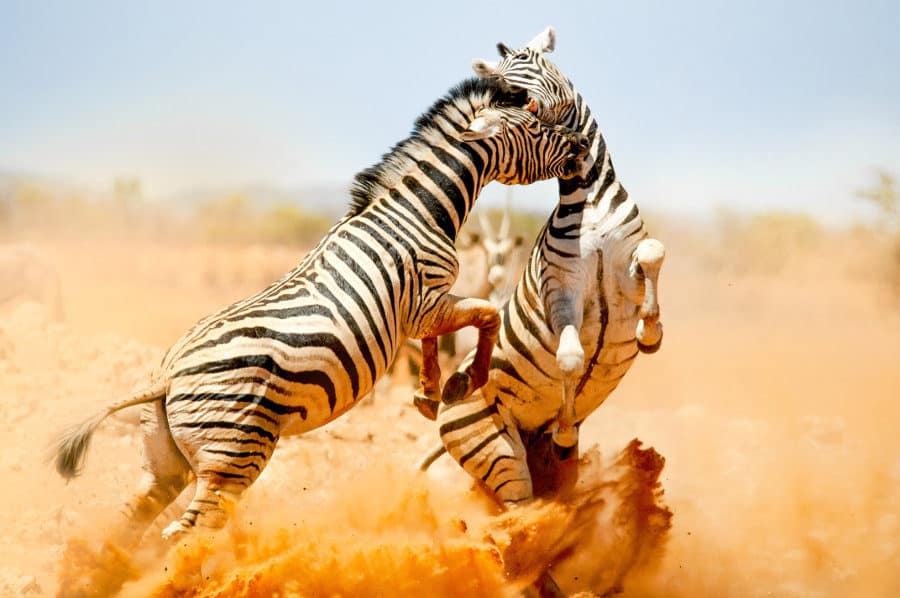
Namibia isn’t known for safari . This is Africa’s natural art gallery, a country of superlative landscapes and breathtaking silence.
Most people don’t even think a Namibia safari is possible. How can wildlife thrive in the desert? Why visit Namibia when Botswana and South Africa are next door?
Yet desert-adapted elephants make epic journeys across the sand. Rhinos gather around salt pans. Black-maned lions survey their dusty kingdoms. Gemsbok are everywhere, their majestic horns a symbol of Namibia.
A safari in Namibia can be as good as a safari anywhere else in Africa. It’s just a little different and you don’t have the same multitude of destinations.
This article guides first-time visitors through Namibia’s best safari destinations . It covers when to go, what to do, how to reduce costs, and how to make the most from the experience.
5 Compelling Reasons to Visit Namibia For Safari
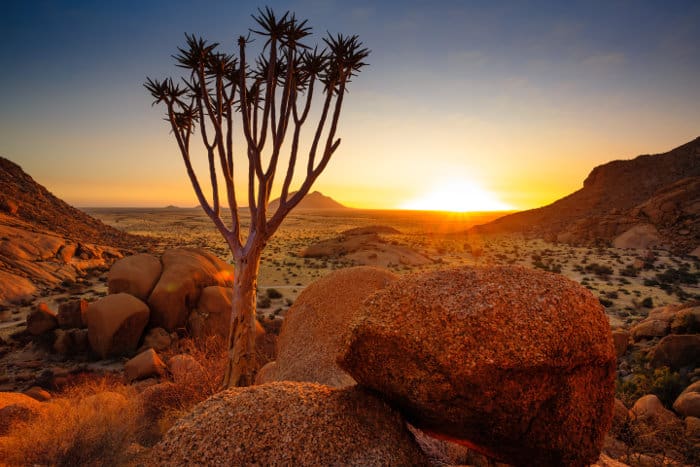
1. Africa’s natural art gallery
Namibia requires time . It’s one of the world’s most sparsely populated countries and it’s difficult getting around. There’s virtually nothing other than wilderness. Even a town that’s signposted for 500 kilometres passes by in the blink of an eye.
Most of the land is inhospitable . Western Namibia is covered by the world’s greatest sand dunes, a barrier too inpenetrable for even the rampaging colonialists.
Eastern Namibia is dominated by the Kalahari Desert , barren plains that bake beneath the sun. Scattered through these deserts are some of Africa’s most surreal sights.
The Fish River Canyon , stark and evocative as it cuts a path through Africa’s crust. It’s the world’s second largest canyon and you can read our guide here .
Then the Namib Desert , where Sossusvlei and Deadvlei are just the famous attractions in a landscape of kaleidoscopic dunes. Read our complete Namib Desert guide here .
Damaraland is all strange rocks and massive mountains, an ethereal assortment of shapes and silence.
The desert has even taken over towns. Luderitz and Kolmanskop are a poignant reminder of nature’s power, where old wooden houses are now buried in sand.
These highlights make for an inspiring adventure. In Namibia there is more than safari and that is one of the big highlights. The vacation is more diverse and it’s also a lot cheaper when you don’t need to pay park fees every single day.
2. Animals are easy to find
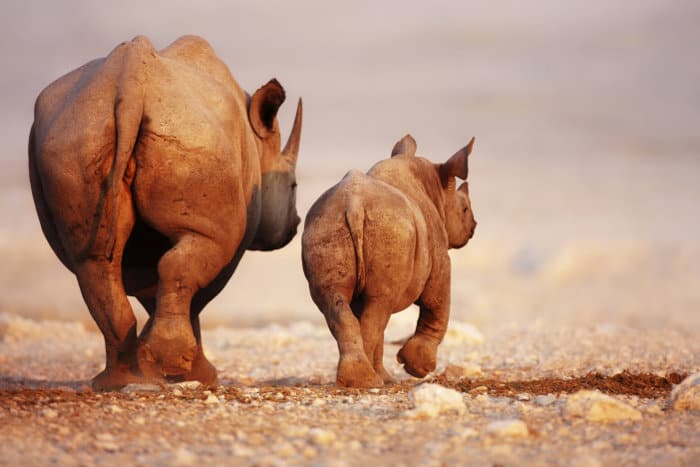
Although it sounds counter-intuitive, such an inhospitable environment makes the safari incredibly easy .
Life in the desert revolves around water . Animals must cluster close to where water remains. So every Namibia safari focuses on waterholes, pans or rivers. Find the water and you find the animals.
Vegetation is sparse . There are very few places for wildlife to hide. Again, this makes wildlife encounters easy. Just gaze across the desert and you can spot herds from miles away.
3. Living with giants
You must be tough to survive here . So step forward desert-adapted elephants, white rhinos, Angolan giraffe and some of Africa’s most elegant antelope species .
In terms of actual numbers there are less large mammals in Namibia than Botswana , South Africa , Kenya or Tanzania . However, as these animals gather in similar places it’s possible to experience a superb wildlife diversity in one place.
Most importantly, Namibia is where you get close . It’s where you feel the battle for survival and experience life on the edge. It’s one thing to see an elephant in a lush forest. It’s quite another to see the emotion on an elephant that has travelled five days to reach water.
Evocative scenes play out. Enchanting gestures communicate how these animals feel. There’s joy and energy. And then there is the brutal reality of life .
Perhaps a carcass being picked at by African vultures . Maybe a wounded animal stumbling away from a battle to mate; or lions tossing bones from a zebra carcass.
4. Africa’s cheapest safari
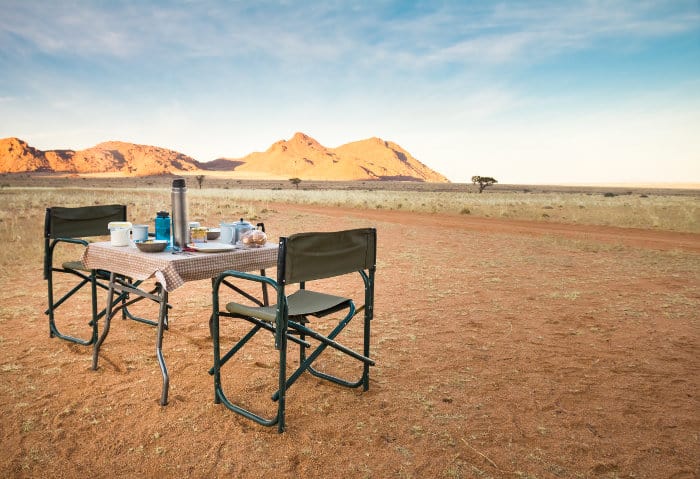
Probably the biggest reason for choosing a Namibia safari is the cost . Here you get the most intense encounters for the best price.
Park fees are lower than other Southern African countries and significantly less than in East Africa.
The camps and lodges are usually modest , without the thrills and luxuries of some in South Africa. Most of them are at the lower end of the price scale, which is very different from Botswana where camps could be USD 1000 per person a night.
Namibia’s public campsites are excellent . They are simple and well maintained, located in areas that can be rich in wildlife. Anyone who is self sufficient will find these camps accessible and cheap.
While Namibia is an enormous wilderness country the safari destinations are relatively easy to reach . A four-wheel drive vehicle is required.
But it’s not like in Botswana where flights are necessary to reach parts of the Okavango Delta , or in East Africa where it’s almost impossible to visit without a local tour.
Namibia is so vast that you don’t need to escape the crowds . You can have a private concession-style safari experience, full of exclusive natural encounters, without needing to pay a premium.
5. The best country for a self drive safari
Excellent camps , easy to find wildlife , and accessible destinations . That adds up to a great self drive destination. You do the safari and this is cheaper than a tour.
The classic way to explore Namibia is to rent a four-wheel drive vehicle that is equipped with a popup roof tent, a camp kitchen, and everything that’s needed for multiple days in the wild.
Visit the national parks , spend the days on safari, then set up at one of the campsites. It’s raw and rugged , an adventure in elephant country with no guides to protect you.
Self drive safaris are not advisable in East Africa – rules and regulations make them expensive and dangerous. One Africa Freak contributor encountered two backpackers in a Toyota hatchback stuck in the Serengeti mud, leaning out of the window taking photos of lions.
South Africa is good but doesn’t have the same wilderness factor , not when the Kruger now has a paved road through the middle of it.
Much of Botswana’s best safari destinations are inaccessible, either because the roads are washed away or the area has been gazetted as a private concession.
Then there is Namibia: freedom , beauty , safari and a connection with your wild side.
Guide to Namibia Safari Destinations
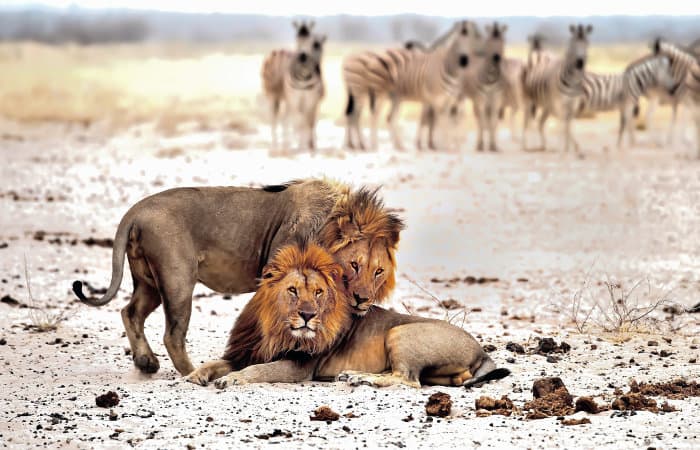
Etosha is one of Africa’s ultimate safari destinations. The rest in Namibia is good and exciting. Visit Namibia and Etosha has to be at the top of the list. If you can, add on the Caprivi Strip for an experience in contrasts.
Etosha National Park
Etosha has an eternal paradox . Like all of Namibia there is an incredible sense of wilderness and exploring a distant piece of old Africa. Yet Etosha is also very accessible and the game viewing is so simple.
There’s comfort and simplicity here, even when gazing across the shimmering Etosha salt pan. Within Etosha there’s the only water for hundreds of miles. That attracts a great succession of migratory mammals during the dry reason.
Often there’s a mystical collection of animals at a waterhole, a kind of animal party featuring hippos, gemsbok , impala, elephant, zebra and giraffe. Then the lions come and transform the dynamic.
The Etosha savannah is scorched yellow and red. Vegetation shrivels and a lot of the park appears lifeless. At the park’s heart is the Etosha Pan , a mammoth salt bed that the park is named after (Etosha literally means great white place ).

Antelope splash about the pan after the rains. Elephants and buffalo dig for the nourishing salt. Gaze across the pan and rhinos emerge from the mirage, the image like something from a work of fiction.
After the pan shrivels and dries, life revolves around the park’s different waterholes . Most camps overlook one of these waterholes so a lot of the safari can be spent sat on a balcony, drinking a beer as wildlife also takes a drink.
The Etosha camp accommodation is very cheap in comparison to South Africa and Botswana, usually less than USD 150 per room for a very comfortable tented camp in a prime location (it may be USD 1000 in South Africa).
Public campsites aren’t next to the waterholes but are among migratory channels so you will see animals nearby. And every night the Etosha animals create their own noisy lullaby.
Animals to see and planning an Etosha visit
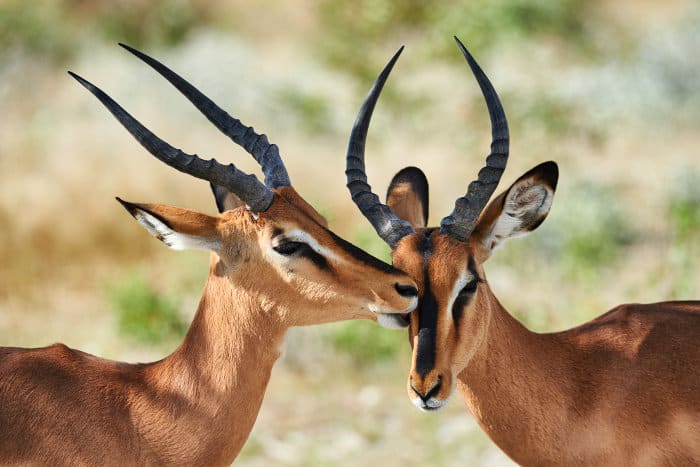
Etosha is home to four of the big five . It’s one of the best places in Africa to see white rhinos and their abundance is quite remarkable here.
Elusive species like black-faced impala are common. Tense predatory scenes are witnessed around the waterholes.
There’s just about everything you could ask for in a safari destination and the ease of the game viewing is elevated by Etosha’s openness . Spotting wildlife is straightforward, even without a guide.
Etosha is located in northern Namibia , roughly a four-hour drive from capital city Windhoek and seven hours from the Caprivi Strip.
Allow at least three full days . The park is big and there is more than enough wildlife for three days. Ideally consider four nights, allowing for two nights in two different sides of the park.
Ongava Game Reserve
A private concession in southern Etosha, Ongava is a luxurious and expensive destination. It’s typically included on high-end safari itineraries that use light aircraft to hop around the country.
The key highlight is the walking safaris , in particular walking safaris with white rhinos. Nighttime game drives and photography hides add to the intimacy.
Wildlife is similar to Etosha and there are only a dozen guests at a time , so it does feel very personal. Still, it’s debatable whether Ongava is worth the price when Etosha next door is so good.
Okonjima Nature Reserve
Halfway between Windhoek and Etosha, Okonjima can be a good Namibia safari introduction . The park is small and fenced but does provide good wildlife encounters, particularly with the cats.
Okonjima is home to the Africat Foundation that helps to rescue and rehabilitate Africa’s carnivores. These cats are in addition to free roaming wild predators. You will need to stay at the lodge in the reserve and one night is sufficient.
Caprivi Strip
Namibia’s fertile panhandle is a surreal contrast to the country’s desert wilderness. Forests and grasslands flourish as four of Africa’s great rivers take root: the Okavango, Zambezi, Chobe and Kwando .
These rivers attract migratory herds throughout the dry season, from various antelope to many thousands of elephant. Many animals stop by the Caprivi as part of their journey to the Okavango Delta or Chobe.
Animals and villages must coexist in the Caprivi. This makes sense: in a desert country almost everything wants to be near a river . There is no single national park but a series of small national parks interspersed with villages and a paved highway heading towards Victoria Falls.
Some of these have been established by local communities and the Caprivi Strip is a celebration of locally organised conservation .
Here there’s an acknowledgement that local people have been integral to conservation since the dawn of time. They’ve found a modern solution that satisfies the needs of wildlife, local people and tourists.
Bwabwata is the largest of the parks, followed by Mudumu and Nkasa Rupara . There’s also Caprivi Game Park , Mashi Conservancy , Wuparo Conservancy and Salambala Conservancy .
Although they don’t share borders, these parks do help create a single wilderness . They have successfully ensured the preservation of one of Africa’s most important wildlife corridors. Here you will see elephants and many other animals crossing the highway.
Each has either a public campsite or a camp and the prices are very reasonable .
Animals to see and planning a Caprivi visit

There is a little of everything but mostly you encounter elephants and different antelope . Giraffe poke their heads up above the trees, buffalo march around and zebra are conspicuous.
Don’t expect many big cat encounters . Not many live here and the lush vegetation makes them difficult to find.
Local San guides may be able to show you a wild dog den, so visitors with patience can be rewarded with sightings of one of Africa’s most endangered species; read the full wild dog story here .
It’s relatively easy to cover any of the parks in a single morning or afternoon drive. To spend more than two nights in any of these parks doesn’t make sense.
The Caprivi is in the far north of Namibia and it’s literally a 400 kilometre strip that juts above Botswana. Follow the strip to the end and you reach Victoria Falls .
We’d recommend spreading the Caprivi journey over three days . With that you can spend a night in two parks or conservancies before leaving Namibia to visit Victoria Falls or Chobe in Botswana.
But if you are blessed with time then extend the journey. These peaceful parks provide a beautiful connection with your wild side . No other people, a handful of grazing animals, and a fertile wilderness.
When to Go on a Namibia Safari

Namibia has clearly defined seasons and these have an enormous impact on the safari experience.
June to August – dry season, mild temperatures, good game viewing
- Mild days and cold nights ; bring warm layers and expect to spend each evening around a campfire.
- Great dry season wildlife viewing with lots of animals around waterholes.
- Dusty skies which aren’t ideal for photography.
- Peak season can result in crowds, especially in parts of Etosha.
September to November – dry season, hot, excellent game viewing
- Hotter days and warmer nights; be prepared to sweat.
- Outstanding dry season game viewing ; there is hardly any water left so wildlife is highly concentrated.
- Less visitors compared to June to August.
- The rains usually start in November and usually come as a relief.
December to January – wet season, very hot, best avoided
- Very hot days in the desert.
- Occasional storms but it doesn’t rain that much in the desert.
- A surprising number of visitors as it is school holiday time in Southern Africa.
- Animals have dispersed so game viewing is more difficult .
February to May – wet season, warm and beautiful
- Namibia is incredibly attractive after the rains have come.
- You may experience storms but mostly these months have blue skies and warm temperatures .
- Wildlife looks healthy and you can see lots of babies.
- However, it’s harder to see animals as they are dispersed.
Planning a Namibia Safari

Namibia safaris often require intensive planning as you must decide how to get around. Overland tours are the most popular mode of travel. You are in a small group and usually spend one to two weeks traveling through Namibia.
For self drive safaris think very carefully about where to pick up and return the vehicle. There’s a superb loop from Windhoek: Windhoek, Damaraland, Etosha, Caprivi Strip, Victoria Falls, then returning via Botswana.
It’s very tempting to extend the journey by starting in Cape Town or Johannesburg but this does add a lot of miles and fuel cost to an already long journey. However, coming from South Africa allows for a route incorporating Fish River Canyon and Sossusvlei.
Another option is to take public transport to Windhoek and then continue the journey from there. Windhoek based tour operators can take you on a three or four-day trip to Etosha for a reasonable price.
The more expensive option is a fly-in safari . Beautiful views extend from the window as you fly to Namibia’s distant destinations. These are aerial safaris and maximize the time you have, ideal if this is a multi-country and you only have two weeks in total.
Map of Namibia’s Main Parks
There’s at least a dozen national parks in Namibia. Here’s the country’s major protected areas and where to find them on a map.
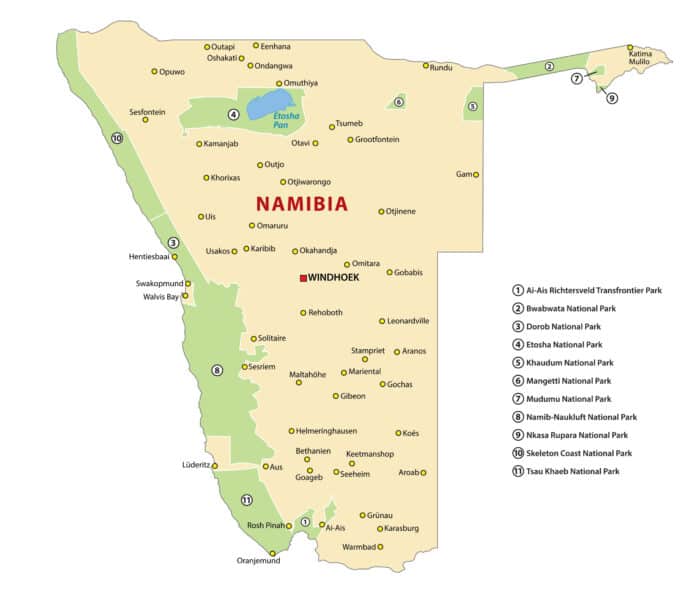
Good Luck in Namibia

We love Namibia . This is where you really connect with your wild side.
At first it seems like an endless empty wilderness. Spend time and look closer, because this is where safari secrets hide .
About The Author
Editorial Team
Related posts.

Cape Cross Seal Reserve: a smelly encounter
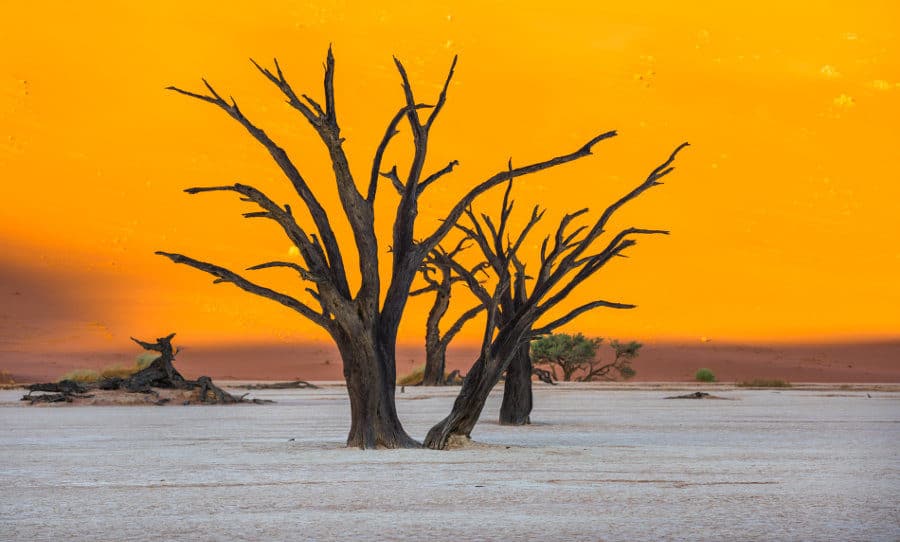
Deadvlei is far more impressive than Sossusvlei – Here’s why

Etosha National Park – The ultimate guide
2 thoughts on “namibia safari – the complete guide for first-time visitors”.
Is it easy to arrive in the capital of Namibia and get a 5, 6 day tour/safari in a local enterprise, that will be cheaper then the ones we find on the internet and we contacted previously when abroad? I mean, I would like to know if I arrive in Namibia will it be easy to find a safari organized by locals, that are cheaper then the ones I find on the internet?
Sure, it is definitely possible to organize your trip once you land in Namibia. There are various travel operators, especially in Windhoek.
That being said, I wouldn’t say it is necessarily “easy”.
It still requires time to organize things properly. You need to find a reliable operator, you might not have as many options… plus pricing will depend on the travel period (more expensive in the high season; in July-October).
NB: Namibia is the perfect destination for self drive safaris , so this could be a nice option to consider if you prefer more flexibility and freedom.
Hopefully this helps.
Happy planning,
Leave a Comment Cancel Reply
Your email address will not be published. Required fields are marked *
- +27 21 418 1325
- [email protected]

Best Time to Visits in Namibia
Discover the ideal season.
Home » Destinations » Namibia » Best Time to Visit Namibia
for Your Namibia Trip
With near-constant sunshine, any time is a good time to visit Namibia! Here’s how choosing the right season can maximize your adventure:
Peak Season (May-September)
The best time to visit for wildlife viewing – milder temperatures, dry landscapes, and animals concentrated near water sources. Expect more crowds, especially in popular parks like Etosha.
Summer (December-March)
Hot temperatures inland but milder on the coast, thanks to the Benguela Current. This less-crowded season offers blooming desert landscapes and potential for lower prices.
Rainy Season (February-March)
Witness a dramatic transformation! Namibia bursts with green landscapes and unique flowers. This quiet period provides a different, but still rewarding, experience.
Choosing Your Namibia Experience
Wildlife Focus: Opt for the dry season for the easiest spotting. Desert Landscapes: Summer heat may be worth it for blooming scenery. Budget-Friendly: Shoulder seasons or the rainy season might offer deals.
Our Recommended
Namibia tours, namibia fly-in safari: namib desert to windhoek.
- From USD 21,977 Per Person Sharing
Namibia Desert Safari: Sossusvlei, Skeleton Coast & Etosha National Park
- From USD 10,333 Per Person Sharing
Namibia Fly-In Safari: Sossusvlei, Damaraland & Etosha National Park
- From USD 5,749 Per Person Sharing
Enquire About
Your african safari.

International +27 21 418 1325

United States +1 929 256 6162

Australia +61 2 7908 6571

Brazil +55 11 24761102

United Kingdom +44 20 3991 2250
- +256 (0) 779 820 753
- +250 (0) 790 089 902
- [email protected] | [email protected]

Best Time to Visit Namibia: A Month-by-Month Guide
Best Time to Visit Namibia: A Month-by-Month Guide. When winter rolls around in North America and Europe, it’s summer in Namibia—just one example of how the seasons in Southern Africa are completely backwards from the northern hemisphere. If you want to go on a safari in Namibia , the best time to go is in the winter (summer in the northern hemisphere) because the animals are more visible and don’t wander too far from the few water sources left. The vegetation is also thinner and drier during this time, so it’s easier to spot them.
When Is The Best Time To Go To Namibia
Peak or high season.
Winter months of June, July, and August are the most popular since they correspond with the region’s school holidays (and, fortunately, with the northern hemisphere’s long summer vacation season). Peak season in Namibia spans from around May (fall) to October (spring). Nighttime lows, particularly in desert regions, are much lower than the warm and dry days. Tourists swarm to Etosha , Sossusvlei , and Swakopmund , three of Namibia’s most popular attractions, during this time.
Lodges, campgrounds, and hotels in Namibia are on the smaller side, so there won’t be a lot of people and cars jammed together. This results in a delightful peak season, but it also means that if you want to travel during this period, you’ll need to book your accommodations well in advance. Travellers who leave it till the last minute may discover that they are completely unable to be accommodated.
Green Or Low Season
From around November to April, the desert landscape of Namibia comes to life with green pastures and millions of vibrantly coloured flowers throughout the summer months of very hot days, warm nights, and infrequent rain. Only around 65 days of the year do you typically get rain.
One of the quietest periods to visit Namibia is during low season, when you can find better rates and a greater selection of accommodations, with the exception of around mid-December to mid-January (Christmas, New Year’s, regional school vacations), and around Easter. Summer is a fantastic travel season for people who enjoy hot weather (although not all hotels have air conditioning or pools). After a long day of exerting yourself, it’s essential to take a break and relax in the shade, just like the animals do.
During the low or “green” season, animals are less common due to the summer rains. Animals have greater freedom to move due to the abundance of water, but they are more difficult to spot due to the thicker foliage. On the other hand, there are substantial benefits, such as the immense joy and fulfilment that comes from actively seeking out sightings and the abundance of infants and birds in the area. From antelopes to zebras, every migratory species is making its way south to avoid the severe winters in Europe. Many grazers are also giving birth at this time to take advantage of the plentiful food. Because predators are unable to keep up with the sheer volume of prey, the odds of survival for the newborns are much improved when mothers give birth in large groups.
If you want to escape the heat and humidity of Namibia in January and February, you should stay away from the Caprivi Strip. The gravel road here could become impassable after a big storm if it gets too muddy.
While travelling in the winter is the most weather-friendly option, it will cost you more. On the other hand, summer is hotter but cheaper. No matter when you decide to go, it’s best to get in touch with your Africa Safari Expert early so you can get your preferred accommodations, transportation, and flights .
When Is The Best Time To Visit Namibia
It is generally believed that the months of May through October, when the weather is dry, are ideal for game viewing in Namibia, particularly in Etosha National Park . As the dry season progresses, the sky is clear, the likelihood of malaria is minimal, and animals are congregating near water sources in greater numbers. In contrast to the sweltering heat of September and October, June and July can bring chilliest nights. From November to April, the country has summer rainfall, which sometimes cause desert floods and turn the landscape green.
Month By Month Guide For Travelling To Namibia:
Travelling to namibia from january to april.
The majority of the nation is experiencing high temperatures and heavy afternoon showers in this mid-summer month of January. After the summer rains, Etosha National Park becomes verdant and verdant, however it can be difficult to see animals due to the thick vegetation. Now is a great time to go bird watching, and you can’t miss the flamingos’ pink plumes. During the rainy season, it is not recommended to visit the Zambezi Region (formerly the Caprivi Strip) because it receives the highest rainfall in Namibia and the roads there are prone to flooding. An increased likelihood of malaria is also present.
The hottest, rainiest, and most humid month is February. There is a lot to do if you can stand the weather. Even though it can be difficult to sight animals in Etosha National Park during February due to the calving season, there is a chance that you may glimpse newborn babies during this period.
March sees less precipitation overall, but the weather remains hot and muggy throughout the day and gradually cools down at night. While March isn’t the ideal season to see animals in Namibia, if you’re a serious photographer, April is when you should go. The sky are clear, and the landscape is waiting to be captured.
Visiting Namibia During May And June
Many people believe that May, the beginning of winter, is the best time to visit Namibia as it is then that the country’s prime safari season begins. The weather is ideal for game drives, with minimal humidity and almost no precipitation. As rivers and other major water sources dry up and become scarce, animals begin to congregate around watering holes.
In June, the nights get progressively chillier and the temperature drops considerably; in desert regions, it drops below freezing. Clear, blue skies characterise the daytime weather, which is quite comfortable. When it doesn’t rain in Namibia , the landscape gets sparse and dry, which makes it easier to see animals on a luxury safari. Even though the game parks are still rather empty at the beginning of the month, they can get extremely busy by the month’s conclusion.
Travelling To Namibia From July To October
The game parks in Namibia, particularly Etosha National Park , are at their most pleasant in July, the driest month of the year. It is not unusual to witness large groups of animals, including gazelles, wildebeests, elephants, zebras, and giraffes, all congregating around a single watering hole during this time.
Even though it’s the dead of winter in Namibia, August is a popular tourism month, so hotel rooms tend to fill up quickly. Daytime temperatures are nice and temperate despite very cold nights, making this a great month for outdoor desert activities and animal viewing. The Ai-Ais Richtersveld Transfrontier Park is truly a sight to behold in August, when the wild spring flowers burst into bloom, covering the terrain in a lovely carpet of blossoms.
The month of September is perfect for a safari in Namibia . The weather is lovely during the day and gets progressively warmer at night. Game viewing is at its best in the month of May since the weather remains dry across the countryside.
October is the final month of winter in Namibia. Even if there’s a danger of rain and temperatures are rising, the skies are often clear, making it an ideal time to watch the stars or a sporting event. Observe southern right, minke, and humpback whales as they pass through the Walvis Bay area in October during their yearly Atlantic migration if you’re planning a coastal whale watching trip in Namibia.
Visiting Namibia During November And December
In November, the country has its first rainy season and a general cooling of the weather. During this month, the weather can be very variable, but as the rain begins to fall, you might witness some spectacular thunderstorms. Thousands upon thousands of flamingos, each with a brilliant pink plume, congregate around lagoons at Swakopmund from November till around February.
Etosha National Park is at its best in December for wildlife watching, with excellent chances of seeing kudu, rhino, elephant, and lion. Since migratory birds start to arrive with the wet season, summer is the best time to visit Namibia if you want to go bird watching. Many people travel to Namibia for an end-of-year safari vacation during this busy time of year due to school holidays and the Christmas season.
Ready To Start Planning Your Trip To Namibia
Go on a conversation with an experienced soul. To create the perfect Namibia vacation, speak with one of our Africa Safari Experts.

Change location
- UK / International
- Call toll-free from 9am EDT
- 617-223-4521 617-223-4320 or
- REQUEST A QUOTE
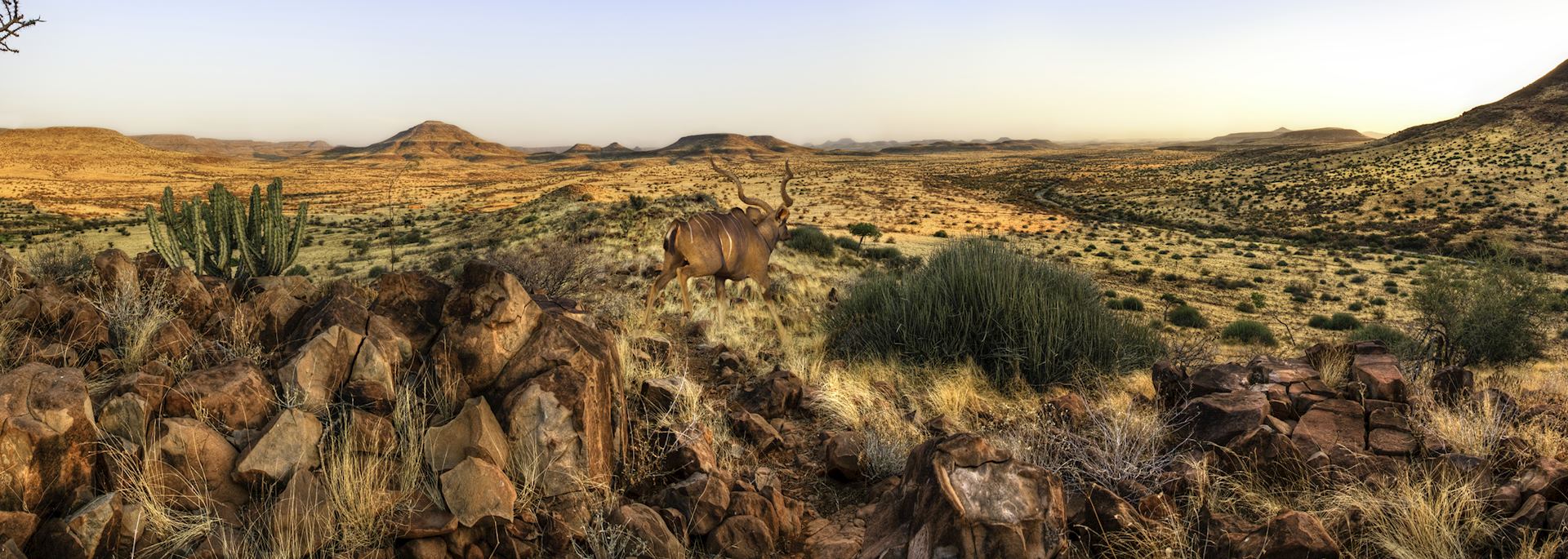
When is the best time to visit Namibia?
- Month-by-month
The best time to visit Namibia is from July to October, when the temperatures are just above 70°F and the chance of rain is low. This is also the best time for wildlife viewing, making it peak travel season — you will need to plan well in advance.
The Northern Hemisphere summer is warm and sunny, albeit with cold nights, while during the winter Namibia is hot with the chance of spectacular thunderstorms. However, it’s a predominantly dry country, where deep orange sand dunes contrast with cobalt skies.
- Make an inquiry
- Request a brochure
Month-by-month guide for traveling in Namibia
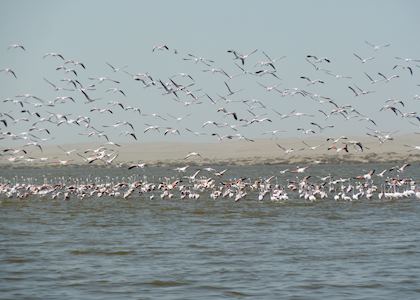
Visiting Namibia in January
This is mid-summer in Namibia. It tends to be hot and humid, with maximum temperatures hitting around 86°F to 95°F; reaching up to 104°F in the desert. There may be torrential downpours in the afternoon, but not every day. Mornings are usually clear, with the rain falling in the late afternoon.
Events & Festivals
- Birdwatching in the Caprivi Strip (November to February): The Caprivi Strip is at its best during the summer months, when there are fantastic birdwatching opportunities, with more than 450 species recorded in the area.
- Flamingos gather (November to February): The summer months are the best time to see a flamboyance of flamingos, where they gather on lagoons in their thousands in Swakopmund.
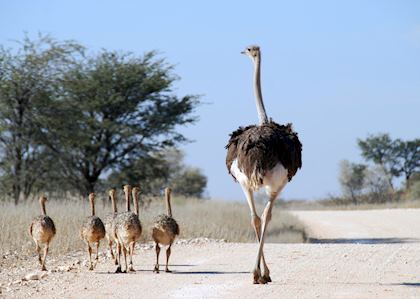
Visiting Namibia in February
Very similar to January, with hot, humid days and the chance of the occasional downpour in the afternoons.
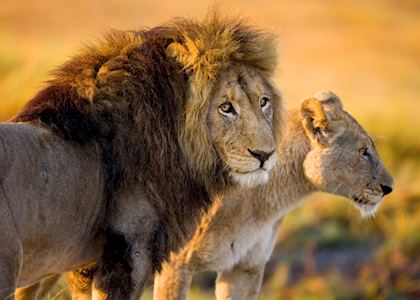
Visiting Namibia in March
Rainfall starts to decrease and temperatures lower after the rains. The nights start to get cooler again, with temperatures falling to around 59°F, although during the day this rises to around 86°F, making for pleasant conditions.
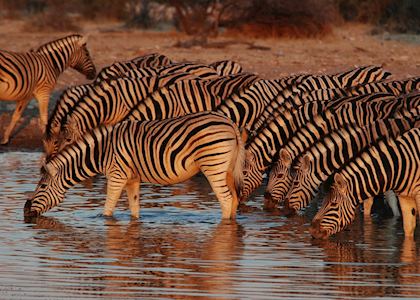
Visiting Namibia in April
The rain should have stopped by April and daytime temperatures should drop to around 77°F. Expect lows of around 55°F at night, although it can be cooler in the desert.
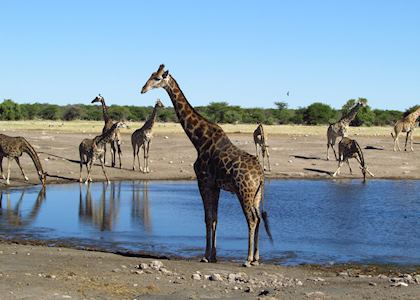
Visiting Namibia in May
May is the beginning of Namibia's winter. There is little to no rainfall during the winter and humidity is low. Wildlife will start to gather around the waterholes when rivers and other water sources dry up.

Visiting Namibia in June
The nights are getting cold and temperatures can drop to below 50°F, while in the desert areas it can get to freezing. Daytime temperatures are pleasant however, with blue skies and temperatures in the 70°Fs.
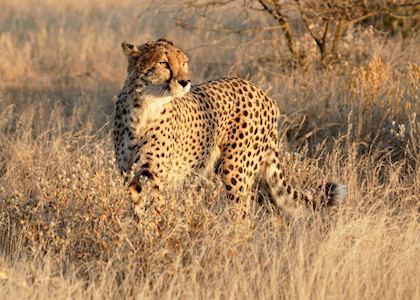
Visiting Namibia in July - August
July and August are the main winter months. Be sure to pack warm clothing because game drives in open vehicles can be chilly. The maximum temperature is around 70-77°F. At night it will be around 45°F, but it can drop to below freezing in the desert.
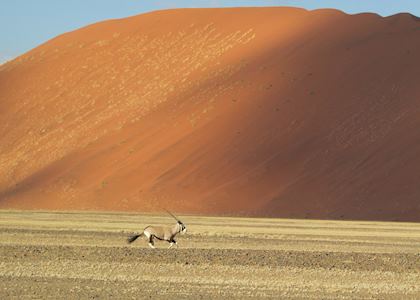
Visiting Namibia in September
September is a lovely month and considered the best time to travel to Namibia. It isn't yet too hot, but the humidity is still low, keeping it very pleasant. It is dry and the skies are clear.
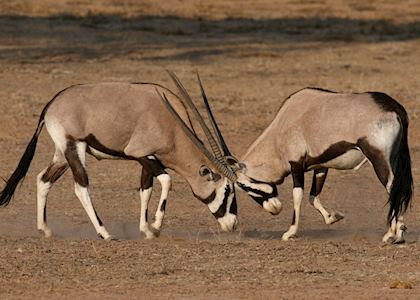
Visiting Namibia in October
During October the green vegetation is fading and the heat gradually builds up. This is a very good time for game viewing because the country is so dry. Temperatures during the day can reach 84°F and it gets even hotter in the desert.
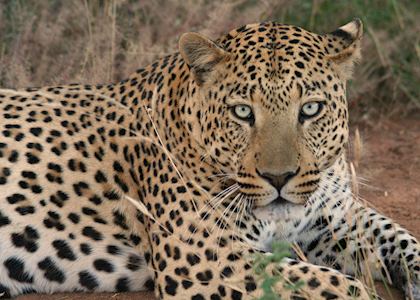
Visiting Namibia in November
The heat continues to rise by November and it will be very hot; although humidity is still low. On average, daytime temperatures are above 86°F. Clouds start to build in the afternoon, bringing a chance of rain.
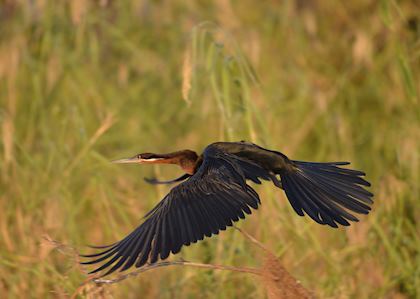
Visiting Namibia in December
The first rains usually arrive in December, and with it the temperature drops. The landscape changes after the first rains as everything comes to life, and the animals start to disperse as more water sources become available.
Namibia Climate Guide
More choice for your safari.
- Inspiration across all our African destinations
- Trip suggestions based on your interests
- Advice on where to safari, when
- Meet our team of safari experts

Travel advice
Practical tips for traveling to Namibia, from social protocols to guidance on money matters, with a link to the latest US State Department travel advice.

Request our brochure
Covering all seven continents, The World Your Way shows you how you can see the world with us. It features trip ideas from our specialists alongside hand-picked stays and experiences, and introduces our approach to creating meaningful travel experiences.
Trip ideas and travel guides for exploring Namibia

Namibia's wildlife highlights self-drive safari
11 days from $6,075pp
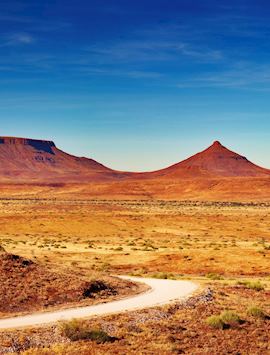
Namibia's highlights by private escorted tour (non self-drive)
13 days from $10,705pp

Namibia safaris
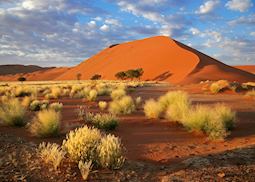
What to do in Namibia: our highlights guide
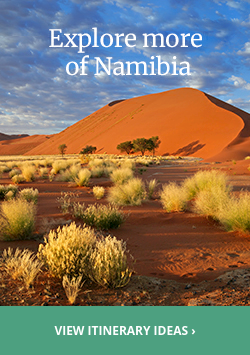
Our head office
0800 088 6002, [email protected], client log in, reset password, agent log in.

The Best Time to Visit Namibia
Namibia, a land of breathtaking landscapes and rich biodiversity, beckons travelers year-round, making any time a good time to travel to Namibia. Understanding the nuances of its seasons and events is essential for an unforgettable journey. When planning your Namibia tours , knowing the best times to visit Namibia ensures optimal experiences, whether you're chasing the drama of the October sky or seeking prime game viewing opportunities in the dry season. Join us as we delve into the intricacies of timing your Namibian adventure for maximum delight and discovery.
Month-by-Month Guide to Namibia's Seasons
January - march (wet season):.
- Weather: Expect warm temperatures with occasional heavy rainfall, especially in January and February. Lush greenery and vibrant landscapes.
- Cost: Generally lower costs for accommodations and tours due to lower demand offering the best time to travel on a budget.
- Crowds: Fewer tourists compared to the dry season, making it an excellent time for a quieter experience.
- Must-See Attractions: Witness the dramatic waterfalls at Epupa Falls, explore the wildlife-rich Caprivi Strip, and marvel at the seasonal flamingo and other bird migrations in Etosha National Park.
April - May (Transitional Season):
- Weather: Transition from wet to dry season ushers in mild daytime temperatures and decreasing rainfall, a prime time to see the landscapes in all their glory. The landscapes start to dry out, revealing clearer skies, making this the best time to travel for those who favor sun and clear skies.
- Cost: Prices remain moderate, with some discounts available before the peak tourist season.
- Crowds: Crowds are generally lighter than during the dry season, allowing for more intimate experiences at popular attractions.
- Must-See Attractions: Enjoy the lush greenery of the Kunene Region, visit the majestic sand dunes of Sossusvlei, and witness the wildlife congregating around waterholes in Etosha National Park.
June - October (Dry Season):
- Weather: Cool to warm days and chilly nights, with minimal to no rainfall. During your time to travel to Namibia, clear skies offer excellent stargazing opportunities, particularly after afternoon changing into the night.
- Cost: Higher costs due to increased demand, especially during the peak months of July and August making it a pricey time to travel to Namibia.
- Crowds: Expect larger crowds, particularly at popular attractions and national parks, in the summer months, although Namibia's vastness still allows for relative solitude.
- Must-See Attractions: Embark on a desert safari in Namib-Naukluft National Park, consider travelling to Namibia to spot elephants in Damaraland, and witness the iconic wildlife migrations in Etosha National Park - a must-see at any time.
November - December (Transitional Season):
- Weather: Transition from dry to wet season brings rising daytime temperatures and occasional thunderstorms, making it a dramatic but exciting time to see Namibia's weather in action. The landscapes begin to green up again shortly after the rain clears, creating a vibrant change in scenery.
- Cost: Prices start to decrease from the peak season, offering good value for those pondering when is the best time to travel to Namibia.
- Crowds: Crowds diminish as the dry season ends, providing more space to explore popular destinations.
- Must-See Attractions: Experience the awe-inspiring Fish River Canyon, discover the cultural heritage of the Himba people in Kaokoland, and enjoy birdwatching in the lush riverbeds of the Zambezi Region.
Understanding Namibia's seasonal variations allows travelers to tailor their experiences to match their preferences, whether they seek vibrant wildlife encounters, stunning landscapes, or cultural immersion.
Namibia Climate Guide for Traveling to Namibia
Namibia's climate varies across its diverse landscapes, offering travelers unique experiences throughout the year. Understanding the climate is essential for planning a successful trip. Here's what to expect:
Dry Season (June to October):
- Weather: Mild to warm days with cool nights. Minimal rainfall and clear skies, perfect for outdoor activities.
- Highlights: Ideal for wildlife viewing as animals congregate around water sources. Excellent for desert safaris and exploring iconic attractions like the dunes of Sossusvlei.
- Packing Tips: Light layers for daytime warmth and warmer clothing for evenings. Sunscreen and hats for sun protection.
Wet Season (November to April):
- Weather: Warmer temperatures with occasional heavy rainfall, especially from December to March. Lush greenery and dramatic landscapes.
- Highlights: Witness vibrant landscapes, seasonal waterfalls, and bird migrations. Great for photographers capturing Namibia's natural beauty.
- Packing Tips: Waterproof clothing, sturdy shoes for muddy trails, and insect repellent. Umbrella or raincoat for sudden showers.
Transitional Seasons (April-May and September-October):
- Weather: Transitioning between dry and wet seasons, with mild temperatures and decreasing rainfall.
- Highlights: Enjoy moderate temperatures and fewer crowds. Ideal for exploring both desert and wildlife areas with comfortable weather conditions.
- Packing Tips: Versatile clothing for changing temperatures. Binoculars for wildlife spotting and photography equipment for capturing scenic landscapes.
General Tips:
- Sun Protection: Namibia's sun can be intense year-round. Pack sunscreen, sunglasses, and wide-brimmed hats.
- Water: Stay hydrated, especially in the desert regions. Carry a refillable water bottle and drink plenty of fluids.
- Wildlife Viewing: Book safaris and game drives in advance, especially during the dry season when wildlife sightings are abundant.
- Road Conditions: Check road conditions, especially during the wet season when some routes may become impassable due to flooding.
By considering Namibia's climate guide, travelers can plan their trips to coincide with their interests and preferences, ensuring a memorable and enjoyable experience in this captivating African destination.
Safari Travel Advice: The Best Time for a Safari Experience on a Trip to Namibia
For an unforgettable safari experience in Namibia, the dry season from June to October is widely regarded as the best time to visit. During this period, the weather is mild, with minimal rainfall and clear skies, creating ideal conditions for wildlife viewing. Animals congregate around water sources, offering excellent opportunities to spot them in their natural habitats.
The months of July to September, in particular, are peak safari season, as vegetation is sparse, making it easier to spot wildlife against the backdrop of the arid landscapes. Etosha National Park, one of Namibia's premier safari destinations, is teeming with game during this time, including elephants, lions, giraffes, and rhinos.
Additionally, the dry season coincides with Namibia's winter months, resulting in cooler temperatures and comfortable weather for outdoor activities such as game drives and guided bush walks. The lack of foliage also improves visibility, allowing for clearer views of wildlife and picturesque landscapes.
While the dry season offers prime safari conditions, it's essential to book accommodations and activities well in advance, as popular lodges and camps tend to fill up quickly during this time. By planning your trip to Namibia between June and October, you'll maximize your chances of an extraordinary safari experience amidst the breathtaking beauty of this African wilderness.
Essential Tips for Exploring Namibia from June to October
Pack Appropriately : Despite warm days, nights can be chilly, especially in desert areas. Pack layers to accommodate temperature fluctuations.
Book Accommodations Early : The dry season is peak tourist season. Secure accommodations well in advance, especially for popular destinations like Etosha National Park.
Stay Hydrated : Even though temperatures are cooler, dehydration can still occur. Carry water bottles and drink plenty of fluids, especially during outdoor activities.
Protect from the Sun : Namibia's sun can be intense. Apply sunscreen regularly, wear sunglasses, and use hats or scarves for sun protection.
Plan Safari Activities : Research and book safari activities ahead of time. Game drives and guided walks are popular and may require reservations.
Be Flexible with Itineraries : Wildlife sightings are never guaranteed, but they're more frequent during the dry season. Stay flexible with your itinerary to maximize wildlife viewing opportunities.
Respect Wildlife : Remember to observe wildlife from a safe distance and follow park regulations. Avoid disturbing animals or getting too close for photographs.
Embrace Night Sky : Clear skies in Namibia offer incredible stargazing opportunities. Take advantage of this by joining a guided stargazing tour or simply enjoying the celestial display from your campsite.
Watch for Special Events : Check for special events or cultural festivals happening during your visit. These can offer unique insights into Namibia's culture and traditions.
Drive Safely : If self-driving, be cautious on Namibia's roads, especially in remote areas. Carry a spare tire, plenty of water, and a well-stocked emergency kit.
By following these essential tips, you can make the most of your exploration of Namibia during the dry season, ensuring a memorable and enjoyable experience in this stunning African country.
What to Expect When Traveling from December to March in Namibia
Weather : Expect warm temperatures with occasional heavy rainfall, especially in December and January. The weather gradually becomes milder towards March as the rainy season tapers off.
Lush Landscapes : The rainy season brings lush greenery and vibrant landscapes to Namibia, transforming the arid terrain into a picturesque oasis.
Wildlife : While wildlife sightings may be less predictable than during the dry season, the rainy season offers excellent opportunities to see newborn animals and migratory birds.
Water-Based Activities : With rivers and waterholes replenished by rainfall, water-based activities such as canoeing, fishing, and boat safaris become popular options for travelers.
Fewer Tourists : Compared to the dry season, the wet season sees fewer tourists, allowing for a more intimate and secluded experience at popular attractions.
Road Conditions : Some roads may become impassable due to flooding or muddy conditions, particularly in remote areas. It's essential to check road conditions and plan routes accordingly.
Mosquitoes and Malaria : The rainy season brings an increase in mosquito activity, particularly in northern regions. Take precautions against mosquito bites and consider malaria prophylaxis if traveling to high-risk areas.
Cultural Festivals : This time of year coincides with various cultural festivals and events across Namibia, offering opportunities to immerse yourself in local traditions and celebrations.
Accommodation Discounts : Some lodges and accommodations may offer discounted rates during the rainy season, providing budget-friendly options for travelers.
Photographic Opportunities : The lush landscapes and dramatic skies of the rainy season offer unique photographic opportunities, particularly for landscape and nature photographers.
Overall, traveling to Namibia from December to March offers a different perspective of the country, with its lush landscapes, diverse wildlife, and cultural experiences. However, it's essential to be prepared for variable weather conditions and plan activities accordingly.
Frequently Asked Questions
What months to go on safari in namibia .
The best months for safari in Namibia are during the dry season, from June to October. Wildlife congregates around water sources, providing excellent opportunities for game viewing.
What is the best month to visit Namibia?
The best time to visit Namibia varies. June to October offers pleasant temperatures, clear blue skies, and little to no rainfall, creating ideal conditions for outdoor activities like safaris. November to April, though considered mid-summer, may experience hot and humid conditions with a chance of rain, but locations like Swakopmund might still enjoy pleasant conditions, especially when the flamingos gather in its lagoon.
What is the wettest month in Namibia?
January to March is indeed the wettest period in Namibia. While rainfall occurs, it's generally not characterized by torrential downpours, especially in coastal areas like Swakopmund, where conditions may still remain pleasant.
What is the coldest month in Namibia?
The coldest month in Namibia is usually July, which falls within the dry season. However, temperatures can vary depending on the region, with colder temperatures experienced in higher-altitude areas such as the Namib-Naukluft Park.
Is Namibia safe for travelers?
Namibia is generally considered safe for travelers. However, exercise caution in urban areas, avoid walking alone at night, and be aware of wildlife when driving in rural areas.
What should I pack for a trip to Namibia?
Essential items include lightweight clothing, sunscreen, a hat, sturdy walking shoes, a reusable water bottle, insect repellent, and any necessary medications. In the rainy season, pack waterproof gear.
Do I need a visa to visit Namibia?
Visitors from many countries do not require a visa for stays of up to 90 days. However, it's essential to check visa requirements based on your nationality before traveling.
What are the must-see attractions in Namibia?
Namibia boasts stunning attractions such as the towering sand dunes of Sossusvlei, the wildlife-rich Etosha National Park, the rugged landscapes of Damaraland, and the breathtaking Fish River Canyon.
How should I travel around Namibia?
Options include self-driving, guided tours, and domestic flights. Renting a 4x4 vehicle is recommended for exploring remote areas, while guided tours offer insights into Namibia's culture and wildlife.
Are there health risks to consider when traveling to Namibia?
While Namibia is relatively low-risk for infectious diseases, it's essential to take precautions against malaria, particularly in northern regions. Consult with a healthcare provider before traveling for any necessary vaccinations or medications.
What currency is used in Namibia?
The currency of Namibia is the Namibian Dollar (NAD), which is equivalent in value to the South African Rand (ZAR). Both currencies are widely accepted throughout the country.
Can I drink tap water in Namibia?
While tap water is generally safe to drink in urban areas, it's advisable to stick to bottled or filtered water, especially in remote areas and during the rainy season when water quality may be compromised.
How can I stay informed about travel advisories for Namibia?
Stay updated on travel advisories by checking government websites, consulting with travel agencies, and monitoring local news sources. It's also advisable to register with your country's embassy or consulate when traveling abroad.
Search our Blog
Related tours.
CAMPING OR ACCOMMODATED. This 3-week East African wildlife odyssey takes you from Livingstone to Nairobi taking n all the major sites en route, including South Luangwa National Park, Lake Malawi, Zanzibar and the Serengeti
CAMPING OR ACCOMMODATED. This tour gives a great introduction to these beautiful and wildlife rich countries. We visit several national parks, meet local tribes, explore the Okavango Delta and finish at Victoria Falls.
CAMPING OR ACCOMMODATED. This comprehensive 20-day tour covers the well worn route from Cape Town to Victoria Falls, crossing South Africa, Namibia and Botswana, and ending in Zimbabwe. It's a truly grand African safari.
RECENT POSTS FROM OUR BLOG
Need some travel inspiration or looking for some handy travel tips? Our blog provides excellent insight into our travel destinations - from tour updates to country guides, packing lists to little known things to do, you'll find it all in our travel blog.
Top Five Photography Spots in Namibia: Beautiful Places Unveiled
Explore the best photography locations in Namibia. The best spots to visit as well as advice about appropriate gear and shooting times for capturing stunning landscapes and dune vistas.
Celebrations, Holidays, and Cultural Festivals in South Africa
Discover South Africa's rich and diverse culture through festivals like the Jazz Festival. Celebrate African festivals year-round on stunning beaches.
Best Time to Visit South Africa
Discover when's the best time to visit South Africa for your dream safari or exploring Cape Town. Plan your trip based on what you want to experience.
Ultimate South Africa Packing List - What to Pack for South Africa Tours - Essential Items to Include in Your Luggage
Discover the ultimate South Africa packing list for your Kruger safari, Cape Town adventures, and beach excursions. Pack for South Africa with everything you need, including essentials for the diverse climate and iconic destinations like Table Mountain and the Garden Route.
A Complete Namibia Packing List: The Only Packing List for Namibia You Need
Discover what to pack for Namibia and enjoy the ultimate safari adventure. Get a complete Namibia packing list for your stay.
The Best Time of Year to Visit Morocco: A Climate Guide to the Best Time to Visit Morocco
Unlocking the Moroccan Magic: Why Spring Reigns as the Best Time to Visit Morocco for Trekking Adventures Along the Atlantic Coast - A Climate Guide.
Best Photography Locations in Morocco for Every Photographer: Best Places in Morocco
Discover the best photography locations in Morocco. From bustling cities to serene landscapes, explore the top spots for stunning photos.
Encounters Travel Nominated as Finalist for Top Travel Retailer Award
Encounters Travel is honored to be a finalist for the Top Travel Retailer Award. Join us in celebrating this recognition of our commitment to exceptional travel experiences and ethical tourism practices.

Best Time to Visit Namibia
Unlike many other African countries, Namibia is a fantastic year-round destination. The dry season offers the best game viewing, while the wet (green) season is ideal for capturing stunning scenery, bird watching and general photography.
The months of: January, February, March & April:

Wildlife and game viewing: Animals, especially in Etosha, tend to spread out and not gather at the waterholes. However, this does not mean that one does not see animals. Many of the plains game like springbok and zebra, give birth during this time so lots of young to be seen . Animals like the lions, leopard and others stay in their territories and do not move away.
Desert and landscapes: This period is the best time to visit the Namib Desert with its green grasses, open and clear skies with some beautiful cloud formations.
Photography: This is an excellent time in the desert for the Namibia landscapes, beautiful colours as well as ethnic people.
Climate / Temperatures:
January & February - The hottest of the summer months. It can get extremely hot and humid with temperatures averaging around 30 - 35ºC / 86 - 95ºF but often reaching peaks of 40ºC / 104ºF in the southern and more northern areas of the country. Downpours are common in the afternoons but also not falling every day.
March & April - Rainfall is less throughout March and has usually stopped completely by the end of April. Daytime temperatures are cooler than in the peak of summer and the nights start to get colder. Most days will see temperatures of around 25 - 30ºC / 77 - 86ºF.
The months of: May, June, July & August:

Wildlife and game viewing: Water levels are dropping and animals start congregating at waterholes for their daily drink. Still quite a lot of vegetation so animals are a quite spread out. These are good months for game viewing in Namibia.
Desert and landscapes: Autumn and winter months means cool and chilly evenings bringing crisp conditions, clear skies and pristine dunes and landscapes.
Photography: Fantastic months for photography . Landscapes, dune formations etc are at their best with little dust in the air giving clear and open skies.
May - Rains have ceased and therefore scenery is lovely and green. During the day temperatures are moderate between 24 - 28ºC / 75-82ºF. Evenings and nights are not that cold yet and are at most times pleasant but cool.
June - Falling just before the winter months, it starts getting colder in the evenings and at night, where temperatures can start dropping to 10ºC / 50ºF. In the southern desert areas it can get very cold. During the day temperatures are still pleasant between 20 - 24ºC / 68 - 75ºF.
July & August - Usually the coldest of the winter months. Average temperatures during the day are around 21 - 25ºC / 70 - 77ºF. At night it drops to around 7ºC / 45ºF and can fall below freezing in the southern desert areas and more northern regions of the country. Pack enough warm clothing and jackets are essential for early morning and late afternoon activities and on safaris.
The months of: September, October, November & December:

Wildlife and game viewing: This period can get very hot indeed which makes for excellent game viewing … again, a wide range of animals meeting at the waterholes. This is often during the heat of the day so good game viewing throughout the day. In the north of Namibia, the rains can start as early as December but game viewing is normally still excellent.
Desert and landscapes: All year destination but can get extremely hot from about 11h00 to 16h00.
Photography: Photography in Namibia is always good … game in Etosha , dunes at Sossusvlei , landscapes and ethnic people . Plan for sunrise and sunset . Middle of the day and early afternoon is hot and the light would not be that good.
September & October- From September, daytime temperatures warm up slightly but it still isn’t too hot. The morning and evening chill factor is less and skies are clear as it is still dry season. During October it gets even drier throughout the country, due to the longer period without rain, and it slowly starts to get warmer during the days and evenings. Daytime temperatures can during this time get quite hot.
November - It starts to really warm up as we head towards our peak summer months. It can get very hot throughout Namibia during November, but humidity is still low. Daytime temperatures can rise to 30ºC / 86ºF but can be a lot higher in the southern desert areas and far north of Namibia. Clouds can often be seen in the afternoons but it is not common for rain to fall yet.
December - A hot month overall with the first rains starting to fall throughout the country. When it rains it cools off a bit making for pleasant temperatures. Rains are usually in short bursts and don’t last too long.
Related Travel Guides

10 Best Places to Visit in Namibia

Top 10 Things To Do in Namibia

Best Time to Visit Etosha
Tour & safari inspiration.
Private Guided

Meet the Team

"We loved our experience with NTS"
We loved Namibia and its unique landscapes and kind people. It was certainly an adventure and a privilege to get to spend time there.
"We can't wait to return"
I can't thank you enough for helping to put together this trip. It exceeded all our expectations and we fell in love with your country.
"We had a wonderful time in Namibia"
All in all we had a wonderful time and appreciate the effort made to ensure all aspects of our tour ran smoothly with prompt email support where needed.
"What a wonderful journey we had in beautiful and friendly Namibia!"
Namibia has stolen our travel-heart and you can consider us as new ambassadors of this spectacular country.
Quick Enquiry
Subscribe to our newsletter, get in touch.

social media
By continuing to browse this site, you consent to the use of cookies. For more information on how we use cookies please review our Privacy Policy .
Best Time to Visit Namibia
Ocean, dunes, mountains and deserts. this vast desert country of rolling dunes and swirling mists stirs the spirit and moves the heart..
Namibia is a country located in southwestern Africa, known for its vast desert landscapes, stunning natural wonders, and unique wildlife. The best time to visit Namibia depends on what you want to see and experience.
The dry winter months from May to October are generally considered the best time to visit Namibia. During this time, the weather is mild and dry, making it comfortable to explore the country's national parks and reserves. Additionally, the clear skies make for excellent photographic opportunities, and the cooler temperatures make it more comfortable to explore the desert landscapes. Wildlife viewing is also excellent during this time, as the animals congregate around the remaining water sources.
The summer months from November to April can be hot and humid, but the landscapes are transformed by brief but intense periods of rainfall, and the country is lush and green during this time. This can be a great time for photography, and the waterfalls and streams in the national parks are at their most beautiful. Additionally, migratory birds are abundant during this time, making it a great time for bird watching. However, the high temperatures can make exploring the country's desert landscapes more challenging.
Overall, the best time to visit Namibia depends on your interests and priorities. If you are interested in outdoor activities like hiking, wildlife viewing, and exploring the desert landscapes, the dry winter months from May to October are ideal. If you are interested in photography and prefer to see the country with a bit more greenery, the summer months from November to April may be more suitable.
Are you planning a tour in Tanzania ?
Namibia Discovery
14 days | explore the coastlines, sand dunes and wildlife-filled savanna grasslands of namibia.

Travel to Namibia and discover one of the most sparsely populated countries on earth. Crossing the border from South Africa, you’ll travel along Namibia's beautiful coastline, to sand dunes, moonscapes and savanna grasslands teeming with wildlife. Namibia is a country of contrasts and a paradise for wilderness lovers! Scale dunes, walk through the desert, savour local dishes, and relax on seldom-visited beaches. Soak up African sunsets, birdwatch, go on game drives through Etosha National Park and do it all with a local leader armed with all the fascinating insights.
Trip overview
- Dine in Lambert's Bay in an open-air restaurant, Muisbosskerm. National Geographic rated this amazing spot as having one of the 'Top Ten Sea Views to Dine For'.
- Spend a full day exploring Cape Town. With its world-renowned beaches, vibrant communities, and nearby winelands, it's the perfect blend of natural beauty and urban zest.
- Go birdwatching in Fish River Canyon and watch the African sunset that makes this place so much more than just one of the world's largest gorges.
- Enjoy plenty of time for seaside leisure in Swakopmund, amid the dramatic breakers of the Atlantic Ocean. Maybe visit the local markets or chill out on the beach.
- Etosha National Park is one of the best places in the world for wildlife spotting, and you'll enjoy a full day of game drives here, both in closed trucks and open-air 4WDs.
- This is an overland trip. That means you’ll be travelling with a group in a purpose-built vehicle, visiting remote communities, and getting the best possible views of Africa's iconic wildlife. While the trucks don’t have air conditioning, they do have sliding windows that let in the breeze and make it even easier to take spectacular snaps of the local wildlife. The drive days can be long, but it’s as much about the journey as the destination, and half the fun is the camaraderie. For more info on this style of travel, see our Africa overland page: https://www.intrepidtravel.com/au/africa/overland
- Namibian summer (November to March) can be very hot and humid with maximum temperatures around 30-35°C and peaks of over 40°C in the desert.
- There will be many early starts either to make use of the better safari time or to beat the morning traffic on long travel days.
- This trip can be partnered with other adventures into a ‘combo’, which means that some of your fellow travellers may carry on to further destinations at the end of this tour. If you’d like to spend more time in Africa, have a look at the combo itinerary: Amazing Southern Africa (UBKEC)
View the itinerary for departures between 01 January 2024 - 31 December 2024
Welkom! Welcome to Cape Town. Your adventure begins with a welcome meeting at 6 pm tonight. If you arrive early, there's plenty to see and do. You will have a free day to explore Cape Town with the help of your leader and fellow travel companions, so we recommend checking the weather forcaste and planning your activities in Cape Town accordingly. After the welcome meeting, get to know your new travel group over an optional dinner with your local leader.
- Hotel (1 night)
There are no meals included on this day.
- Complimentary Arrival Transfer
It’s very important that you attend the welcome meeting as we will be collecting insurance and emergency contact details at this time. If you are going to be late, please let your travel agent or hotel reception know. Ask reception or look for a note in the lobby for more information on where the meeting will take place.
The arrival transfer is only valid if arriving on Day 1 or if you have booked pre-trip accommodation through Intrepid. Please provide your flight details at the time of booking, or a minimum 14 days prior to travel.
Cape Town is a dynamic city renowned for its stunning landscapes, pristine beaches, and rich cultural heritage. With a wealth of activities to choose from, you're free to craft your own adventure, guided by the expert advice of your leader and possibly some enthusiastic group members. Many experiences here are weather-dependent, such as a trip to the top of Table Mountain, which is best enjoyed on a clear day to take in the spectacular views. Rain or shine, whether it’s hiking, visiting wineries, or seeing the penguins, there's always something exciting to explore in Cape Town.
- Cape Town - Cape Peninsula and SUP Tour - Full Day - ZAR2100
- Cape Town - Robben Island Ferry & Table Mountain Tour - Full Day - ZAR1800
- Cape Town - Best of the Cape Combo Tour - Full Day - ZAR2000
- Cape Town - Cape Peninsula & Kirstenbosch Tour - Full Day - ZAR2000
- Cape Town - District Six & Bo-Kapp Cultural Tour - Half Day - ZAR965
- Cape Town - Winelands Tour - Full Day - ZAR1800
- Cape Town - Township Experience - Half Day - ZAR965
- Cape Town - City and Waterfront Tour - Half Day - ZAR1100
- Cape Town - Cape Malay Cooking Tour - Half Day - ZAR1200
- Cape Town - Winelands Tour - Half Day - ZAR1350
- Cape Town - Cape Peninsula & Table Mountain Tour - Full Day - ZAR2000
- Cape Town - Harbour cruise - ZAR200
- Cape Town - Table Mountain Aerial Cable - ZAR380
- Cape Town - Table Mountain Hike - ZAR1600
- Cape Town - Robben Island tour - ZAR550
Depart Cape Town and travel along the west coast to the small seaside town of Lamberts Bay. The bay’s white beaches, lobsters and incredible wildlife earned its nickname ‘the diamond of the west coast’. When you arrive, enjoy a delicious feast at a local open-air restaurant, where the amazing ocean views will make for the perfect meal setting. After your seaside lunch, you'll head to Trawal to relax and soak in the views of wine farms and Cedarberg mountain range.
Your travel time today will be approximately 5 hours.
Say farewell to South Africa as you cross the border into Namibia. You should reach your destination on the banks of the Orange River by mid-afternoon. The border crossing and a few photo stops along the way can delay this arrival time. Orange River is the longest river in South Africa, running from high up in the Drakensberg Mountain range and into the Atlantic Ocean. The river is significant for its role in transporting diamonds, which in turn leaves deposits that are found along the Namibian coastline.
- Lodge (1 night)
Your travel time today will be approximately 7 hours.
Spend a leisurely morning getting some extra rest, or unwind by the outdoor pool, soaking in the stunning views of the Orange River in morning light. If relaxing isn't your style, then head out on an optional canoe adventure along the Orange River. With a local guide, you’ll wind through the ancient Richtersveld Mountains in 2-man canoes. This is a slow-paced trip covering approximately 10 km and you’ll mostly be travelling downstream. Later on, venture to Fish River Canyon – one of the biggest canyons in the world. You’ll stop at various lookouts along the way – all great opportunities to catch this gigantic gorge on camera. Look out for some exotic birdlife while you’re here, including plovers, wagtails, hammerkops and herons. You might even catch a glimpse of a baboon or an antelope at dusk!
- Desert Camp (1 night)
- Fish River Canyon - Canyon entrance
- Orange River - Canoe trip - NAD550
Please bring your own towel for the canoe trip.
Today is a long travel day, so grab a window seat if you can or play some road trip games with your fellow travellers. You’re heading to the eastern edge of the Namib Desert today – this region of the world's oldest desert is known for its array of geological features. Take in the diversity and sprawling beauty of the scenery as you drive, and when you arrive, relax at your desert lodge.
Your travel time today will be approximately 9 hours.
Today, you’ll make an early morning visit to Sossusvlei, which lies at the end of an ancient riverbed. If you find yourself in the mood, a climb to the top of Dune 45 will reward you with unparalleled views. After breakfast, head to Dead Vlei – a clay pan well known for the iconic postcard-like images taken here by many. The pan is surrounded by some of the highest dunes in the world, including ‘Big Daddy’ and ‘Crazy Dune’. If you'd like to avoid a long walk in the sun, you can opt to pay extra for a 4WD transfer out to the entrance point. In the afternoon, visit Sesriem Gorge – a tranquil natural corridor you can walk through and explore. The canyon was caused by water erosion over thousands of years and the people who lived in the area used to pull buckets of water up from the depths with six knotted belts. Therefore, the canyon was named after the Afrikaans word ‘sesriem’, meaning ‘six belts’.
- Sesriem - Sesriem Canyon Visit
- Sossusvlei - Dune 45
Depart your desert lodge and travel across the Namib Desert today, ending up on the gorgeous Atlantic Ocean coastline. The drive goes through a diverse and colourful landscape, so keep your eyes on the windows and soak up the scenery. You'll see the incredible Kuiseb Canyon along the way, before arriving at the beachside town of Swakopmund, located on the Skeleton Coast.
Your travel time today will be approximately 6 hours.
Your leader will take you to a local centre where a range of activities will be on offer. We have not risk-assessed all activities, and only those listed in our itinerary are recommended. If you are unsure please check with your leader.
Please note that it is against company policy for leaders to facilitate the booking of any activities that have not been risk assessed or do not adhere to our company’s Responsible Travel policy and ethos. This includes organising transport to and from these activities in our vehicles.
Enjoy some free time in this gorgeous coastal oasis. Your accommodation is within walking distance of town, making optional activities easy to access. Maybe stroll along the beach, explore the open-air markets or visit the local museum. Your local leader will take you to the local activity centre if you’re not quite sure how you’d like to spend your day.
- Swakopmund - Swakopmund Museum - USD2
Get off the beaten track and head into the heart of Damaraland. The ancient landscapes of the Kunene Region are ruggedly spectacular – think awesome sunsets and night skies filled with a multitude of dazzling stars. This part of Namibia is also known as Damaraland, as it’s the ancestral homeland of the enigmatic Damara people (whose exact origins remain unclear). This is also home to a small population of hardy desert adapted elephants and some super unique flora and fauna.
Many of the roads we travel on today will be untarred and often corrugated. They are some of the worst on this itinerary, so be prepared for some extra bumps.
Spend the morning exploring the surrounding sights, including the Twyfelfontein Heritage Site, which boasts one of the largest concentrations of ancient rock engravings in southern Africa, and the Petrified Forest, home to 280-million-year-old fossilized tree trunks. You’ll be guided by locals at both sites, gaining fascinating insights into the area’s history. Visit the Living Museum of the Damara to experience traditional Damara culture, a rare opportunity to connect with one of Namibia's oldest communities. Stop at Burnt Mountain, a 200-meter-high hill at the base of a barren volcanic ridge. It was formed 80 million years ago by a lava flow that dramatically transformed the now desolate landscape. It can get hot, so bring a hat, sunscreen, and water. Spend the rest of the day back at the lodge, relaxing by the pool or enjoying a book in the shade.
- Damaraland - Petrified Forest
- Damaraland - Twyfelfontein Bushman Paintings
- Damaraland - Burnt Mountain
- Damaraland - Living Museum
Today, you'll enjoy a full-day game drive through Etosha National Park in open 4WD vehicles. Keep your eyes peeled for black rhino, Hartmann's mountain zebra, black-faced impala, roan antelope, and the tiny Damara dik-dik. Game viewing in the park is relatively easy due to the man-made waterholes and the large, sparsely vegetated pans. The bushland surrounding the pans is hard to see through, but there are enough clearings, pans, and waterholes to allow for some sightings. Head back to the lodge after and enjoy a free evening.
- Etosha National Park - Overland Vehicle Game drives
From Etosha National Park, you’ll head to Windhoek – an old German town that’s now a cosmopolitan centre. The Germanic colonial architecture of this city contributes to its charming feel. You'll arrive in the late afternoon or early evening. Your trip comes to an end here, so no accommodation is included tonight. If you're staying in the area, the Tintenpalast (Ink Palace), the Christuskirche (church), the gymnasium and the Genossenschaftshaus are all well worth visiting. If you need to organise extra accommodation, speak to your booking agent ahead of time.
- Etosha National Park - 4x4 Vehicle Game Drive
You can fly out today if you wish, but bear in mind that the airport is an hour's drive from town, so it’s recommended you stay at least an extra night.
13 breakfasts, 10 lunches, 8 dinners
Overland vehicle, Canoe
Lodge (7 nights), Hotel (4 nights), Desert Camp (2 nights)
Dates and availability
Important notes.
1. A single supplement is available if you’d prefer not to share a room on this trip. The single supplement applies to all nights of your trip and is subject to availability. Please speak to your booking agent for further information.
2. A complimentary airport arrival transfer is included; valid if you are arriving on Day 1 or if you have booked pre-tour accommodation through us. You must provide your flight details to your booking agent at least 14 days prior to travel.
3. This trip finishes on arrival in Windhoek on Day 14. Please do not book any flights out this evening. The Airport is located 1hr drive out of Windhoek, and although we generally make it back to the hotel in Windhoek by 5:00pm, it can be difficult to get to the airport in time for flights.
4. The weight of baggage that can be brought on this tour is limited by the packing space and weight restrictions of the truck. The weight limit for luggage on all of our trucks is a maximum of 15-20kgs per person, plus a maximum of 5kgs for your day pack. Backpacks shouldn’t have an external frame unless it can easily be removed and stored separately to avoid damaging other people’s luggage. We strongly advise passengers to travel with a backpack or a duffel bag, and it is essential that no hard suitcases be brought on tour. For valuables, like passports, we offer a safe on each vehicle that is shared by all passengers to keep their documentation safe during their journey.
5. The minimum age for this trip is 15 at the time of travel. Any travellers under the age of 18 must be accompanied by a legal guardian, or in lieu of a legal guardian, by an escort over the age of 18, appointed by their legal guardian. The legal guardian or their designee will be responsible for the traveller under the age of 18 day to day’s care. If a legal guardian elects to designate an escort in their lieu, they will be required to complete and sign a relevant document to delegate their authority.
6. Border crossing delays in the region are sporadic and difficult to predict. What takes an hour one day may take four hours the next. This may affect the order of activities in the itinerary. We understand this uncertainty can be frustrating, and we strongly recommend packing a bit of patience and flexibility.
Want an in-depth insight into this trip? Essential Trip Information provides a detailed itinerary, visa info, how to get to your hotel, what's included - pretty much everything you need to know about this adventure and more.
Filter by rating

Written by: Colin on 10 September 2024
When is the best time to visit Etosha National Park? A Comprehensive Guide
- Travel Tips

The best time to visit Etosha National Park for a safari is during the dry season, from May to October. During this time, temperatures are at their lowest, and wildlife viewing conditions are at their best, making it easier to spot a wide variety of species. In this blog, we will explore why the timing of your visit to Etosha is crucial and highlight lesser-known periods perfect for landscape photographers and nature enthusiasts seeking to leave the rest of the world behind.

Table of Contents
An overview of Etosha National Park
Although the best time to visit Etosha National Park in northern Namibia is during the dry season, you can visit the park year-round. It is a dream destination, home to a wide variety of wildlife, including four of the Big Five. It features dramatic landscapes that can appear harsh at times but abundant at others.
Much of the Etosha region consists of savannah grasslands, with the Etosha pan in its centre. The pan, a vast lake bed visible from space, is dry most of the year due to the hot, semi-arid climate. Yet, the park’s seemingly barren appearance is an illusion, as this ecosystem is home to one of the most abundant displays of wildlife in southern Africa. This incredible landscape can support vast numbers due to numerous underground reservoirs feeding permanent waterholes along the southern edge of the pan and the surrounding plains.

To truly appreciate Etosha National Park, it’s essential to understand its yearly life cycle. The wet and dry seasons influence the numerous fascinating phenomena in the park, such as calving, mating, migratory movements, blooming of desert flowers, and predator-prey dynamics – and essentially the best time to visit Etosha National Park. The following sections reveal more and will help you plan for an unforgettable experience in this incredible park.
Would you like to know more about traveling in Namibia? Just get in touch with us!
When is the best time to visit Etosha? Understanding the seasons in Etosha National Park
The wet season (november to april) – what to expect.
In the wet season, Etosha National Park experiences high temperatures and afternoon rainfall. Abundant forage and water allow wildlife to spread into the vast savannah, and rising water levels make parts of the park unreachable. This results in challenging wildlife spotting. Nonetheless, the dry pan has transformed into a lake, and the park is lush and green. Additionally, it’s the low season, making it the best time to visit Etosha if you love being in nature, are passionate about landscape photography, or want to avoid crowds. Moreover, as game drives occur in the early morning and evening, you can avoid the afternoon heat and thunderstorms.
The park’s annual story begins at the end of a long six-month dry season. This period is challenging for the herbivores because there is little to feed on, and swirling dust devils fill the air. Daily visits to drying waterholes to obtain life-sustaining drinking water become increasingly dangerous, as well-fed predators lie in ambush to pick off the weak and old. However, hope appears on the horizon in the form of distant rainstorms.

During Namibia’s wet season, rainfall varies from 2mm in the Namib Desert along the coast to 600mm in the Caprivi Strip to the northeast. Etosha National Park receives approximately 418mm of rainfall, and afternoon temperatures range from 32°C (90°F) to 35°C (95°F).
When the rains arrive in short afternoon thunderstorms, they transform the park, especially during the peak rainfall from January to March. The pan, a natural depression with no outlet, is fed by several small rivers, including the Ekuma River, and slowly fills. It is believed that the larger northern Kunene River once filled the lake before tectonic plate movement disrupted the flow from the Angola highlands, its source, and redirected the river to the Atlantic Ocean.
The lake, now 50 miles across and only two feet deep, comes to life. Catfish spawn after remaining buried in the lake bed during the dry season, while bullfrogs give birth to thousands of tadpoles. These defenceless young quickly fall prey to egrets, herons, snakes, terrapins, Fish eagles, Blue cranes and other predators. Great-white pelicans arrive en mass to give birth to their young on predator-free islands, and flamingos dot the shoreline.

The grasslands absorb the water, and wildflowers appear, accompanied by the chorus of mating bullfrogs. Herbivores, like wildebeest and zebra, have plenty to eat, spread out into the plains and give birth to their young in lush green landscapes under a vast, dust-free African sky. Despite the higher temperatures and lower wildlife numbers, the colours and abundance of nature make it a spectacular time to visit Etosha.
Thanks to the wet season, the wildlife of Etosha experiences a bountiful season; strengthened and renewed, they are now prepared for the long, harsh dry season ahead.

The Dry Season (May to October) – what to expect
The best time to visit Etosha National Park is during the dry season, when a wide variety of wildlife can be observed. As the landscapes dry out, vast numbers of animals and birds gather near the park’s 40+ spring-fed waterholes, providing the opportunity to see four of the Big Five, excluding buffalo, and many other wildlife species. Additionally, temperatures are lower, with comfortable highs ranging from 27°C (80°F) to 33°C (91°F). Yet mornings are cold. It is the high season, and the park is at its busiest.
The dry season is fascinating, and each passing month has unique characteristics. As grasslands dry, the rutting season starts for species such as the blue wildebeest, black-faced impala, and springbok. Males clash horns as they compete to mate with small groups of females. Often distracted, they fall prey to lion attacks.

As the months pass, the lake begins to dry, and zebras can be seen wading through the mud to find new grazing areas. The lake eventually hardens under the harsh sun, forming a pattern of cracks on the surface and exposing the previously safe Pelican islands. This allows Black-backed jackals and Spotted hyenas to carry out evening raids on the colony to prey on flightless chicks. Soon, the lakebed turns into a dusty white pan, which gives the park its name, originating from the Oshindonga word, “Great White Place.”
The drying grasslands prompt grazers to seek fresh grass, following trails from one waterhole to another. Herds of elephants dusted white from the pan’s clay soils create wide, meandering paths, which Angolan giraffes, Greater kudus, oryx, and Southwestern black and Southern-white rhinos use.

After three rainless months, the waterholes become even more perilous. As the wildlife nervously comes to drink, the shrill call from Blacksmith-plover and fleeting Crowned guinea fowl signal a lion or leopard charging from a concealed position, and chaos ensues. It is a dramatic time to be in the park.
At dawn and dusk, the waterholes are a paradise for birdwatchers. They are frequented by ostriches, Bateleur eagles, Kori bustards, Glossy starlings, Red-headed finches, weavers, and large flocks of Red-billed quelea, as well as many more.
For the past six months, there has been no rain in Etosha. Egyptian geese wade in muddy pools, bat-eared foxes scratch for ground-dwelling insects, adding to the dusty haze, and grazing herds return in long, meandering lines to the shoreline. By the time the rains arrive, they will have reached the same breeding grounds as the year before. Looming thunderstorms appear. Life-giving rain will replenish this stunning ecosystem, and the annual cycle of death and renewal will continue, just as it has for millions of years.

When is the best time to visit Etosha National Park? Month by Month
The wet season: november to april.
The wet season is the best time to visit Etosha National Park for landscape photography and to see the ecosystem transformed:
November and December experience short afternoon thunderstorms that bring some relief to the plains; however, rainfall is relatively low at this time of year. Nonetheless, it is enough for acacia trees to blossom and form new leaves, which brings sustenance to Angolan Giraffes and foraging insects. It is the hottest time of year, with afternoon temperatures reaching 35°C (95°F) and higher.
January, February, and March experience peak rainfall, transforming the pan into a lake. An abundance of grasses and wildflowers emerge from the dusty plains, and the calving season starts, bringing new life to the plains. From January, temperatures fall with each passing month and afternoon temperatures range from 34°C (93°F) to 35°C (95°F).
April experiences less rainfall and lower temperatures, ranging from 29°C (84°F) to 32°C (90°F). It is also a quieter month in the park, making April an excellent month to visit Etosha.

The Dry Season: May to October
The dry season is the best time to visit Etosha National Park for wildlife viewing:
May, June, July and August are cool, dry and sunny, with temperatures ranging from 25°C (77°F) to 29°C (84°F). However, mornings are cold and wearing multiple thin layers is required to keep you warm during early morning game drives. August is the peak of the dry season, and temperatures begin to rise. Wildlife viewing is exceptional due to a high concentration of animals that never stray far from permanent water holes.
September and October are the final dramatic months of the dry season. The temperatures continue to rise each month, ranging from 32°C (90°F) to 34°C (93°F), causing the water holes to begin to dry out. Wildlife viewing is fantastic, and towards the end of October, occasional afternoon thunderstorms hint at what’s to come.
Since the dry season from May to October is the best time to visit Etosha for a safari, the most popular accommodations fill up quickly. We recommend booking one year in advance.
Two of our favourite tours with a stop in Etosha:

Fascinating Namibia
Places Windhoek, Kalahari, Namib Desert, Swakopmund, Erongo Mountains, Damaraland, Etosha National Park, Waterberg Plateau
from 63,000 NAD person sharing a double room

Namibia Highlights
Places Windhoek, Namib Desert, Swakopmund, Spitzkoppe, Erongo Mountains, Damaraland, Etosha National Park, Waterberg Plateau
from 29,500 NAD person sharing a double room
Planning your visit and getting to Etosha National Park
By now, you’ll have a good idea of when to go to Etosha National Park. There are multiple places to stay in Etosha, including various lodges, permanent tented camps, campsites, and luxury accommodation. However, the demand for accommodation can outweigh the supply during the dry season (high season), so advanced booking is recommended. Our country experts can help you choose accommodation that is best for your budget and preferences.

Getting to Etosha National Park is straightforward. Catch a connecting flight from South Africa’s International Airports to Namibia’s Hosea Kutako International Airport (HKIA/WDH) or Walvis Bay International Airport (WVB). Once in Namibia, you can get to Etosha National Park by choosing a self-drive , private-guided , or group-guided safari. Driving distances are long, but you’ll be accompanied by incredible scenery.

Before booking, we recommend reading our What to Do guide to add unique experiences to your safari, such as star-gazing , trekking or enjoying a hot-air balloon safari over Namibia’s famous dunes.
Preparing for your trip to Etosha National Park can be daunting, but when you book with us, we’ll email you a packing list and other guides to help you prepare for your safari. We’ll be there for you every step of the way.

Where to stay in and around Etosha National Park
There are camps inside and just outside the Etosha National Park. The number of camps inside the park is limited. The ones available are quite basic and you shouldn’t expect a very high standard. The reason why some visitors still opt for the more basic accommodations: they have flood-lit waterholes. These waterholes attract wildlife especially during the dry season. You can sit near these waterholes until late into the evening to observe wildlife passing by for a drink.
On the outskirts of the national park, there are numerous different camps and lodges you can choose from. These accommodations range from basic to highly luxurious. They are often more charming than the accommodations inside the park.
Since the most popular camps are booked up quickly, we recommend booking a year in advance. Especially, if you want to travel during the high season.

Combining Etosha with other destinations
You can combine a safari to Etosha National Park with numerous incredible destinations in northern Namibia. You’ll find the Damaraland , where stunning scenery and desert-dwelling wildlife can be seen west of Etosha. Those set on seeing buffalo, the missing member of the Big Five, and more incredible wildlife can travel to northeast Namibia to visit the beautiful parks in the Caprivi Strip (Zambezi Region) .
In the south, you can visit the Fish River Canyon , the Kalahari Desert, and Sossusvlei in the Namib Desert, home to Namibia’s world-renowned dunes.
Along the Atlantic coastline, you can visit Swakopmund to see small desert-adapted wildlife, and Luderitz offers the chance to see Atlantic Ocean wildlife and spot wild horses.
The best time to visit Etosha coincides with the ideal traveling time for other highlights in Namibia. This makes the dry season from May to October the most popular time to see Namibia’s wildlife, scenic and cultural highlights.
The best time to visit Etosha: Conclusion
Etosha National Park is an exceptional destination for observing wildlife in a stunning ecosystem. As a result, safaris to Etosha are worth your while year-round. Still, the best time to visit Etosha is during the dry season from May to October to see abundant wildlife. Since it is the high season, booking accommodation as early as possible is recommended. Alternatively, you can travel during the wet season to witness grasslands teeming with wildflowers, the calving season, and the pan transformed into a lake. Finally, consider combining other incredible destinations to discover more of what Namibia offers.

With a team of guides, vehicles, and twenty years of experience, we can make your dream safari to Etosha a reality. We suggest reading what other guests say and then contacting one of our country experts for a no-obligation conversation to take the first step in making your safari a reality.
You may also like

When is the best time to travel to Namibia?
When the best time to travel to Namibia is depends on what you want to do and see. Our guide helps you find the best time to travel for you.

Where can you see Desert Elephants in Namibia?
The desert elephants of Namibia are a unique phenomenon. Find out how they arrived here and where you can still see them today.

When is the best time to visit the Namib Desert? Our Comprehensive Guide
When is the best time to visit the Namib Desert? Our guide shows you the best way to enjoy dune climbing, wildlife viewing, and photography. Get expert advice on activities, weather and planning your adventure.

IMAGES
VIDEO
COMMENTS
Month by month description of the best time to visit Namibia. Including the best months, pros/cons, high/low seasons and the best/worst weather! Menu. Safaris & Tours. Botswana (572) Congo (DRC) (20) ... 14-Day Namibia Flying Safari. $19,594 to $28,801 pp (USD)
The best time to visit Namibia falls between May and October when temperatures range from 68-82°F, creating perfect conditions for safaris, hiking, and wildlife viewing. During these months, the weather is comfortable for exploring the outdoors, and the reduced water sources draw animals to waterholes, enhancing the safari experience.
April and May are lovely times to be in Namibia. Much of the country is covered in shades of vivid green, the rains have washed away the late dry-season dust and the air is exceptionally clear. Daytime temperatures range from 24ºC to 28ºC (75ºF to 82ºF). Apart from the Easter holidays, safari camps are generally not full.
Best time to go to Namibia: Regions and months. Namibia is a beautiful country to visit, regardless of the season and popular with visitors arriving into Namibia from the U.S, U.K, Germany, Switzerland, Italy, South Africa and beyond. Some visitors may require a Namibia visa to secure their entry.. The country has a subtropical desert climate characterised by great differences in day and ...
Best Time to Visit Namibia. ... To take advantage of this quieter (and cheaper!) time, our special Green Season Safari captures the best of Namibia—with savings of more than $1,500 per person compared with safaris in the peak season. January. Visiting during the summer's peak means higher temperatures and afternoon showers, which is a small ...
The best time to visit Namibia is from July to October, when the temperatures are just above 70°F and the chance of rain is low. This is also the best time for wildlife viewing, making it peak travel season — you will need to plan well in advance. ... Our safari consultants have lived and worked in Africa and have a real passion for what ...
The best time to visit Namibia for a safari is during the dry season, from May to October, when wild animals congregate near water bodies, making them easier to spot. The weather during these months is mostly dry and cool, especially from June to August, providing comfortable conditions for game drives and outdoor activities. ...
The best time to visit Namibia for a safari is during the dry winter from June to October. Temperatures are comfortably around 20°C, vegetation is thinner and wildlife congregates around waterholes, where predators hungrily await. This is also the best time to travel to Namibia and Botswana for a combined trip.
The best time to go on safari in Namibia depends on where you're going, and what you'd like to see. October to March is the best time to visit Namibia's coast around Walvis Bay and Sossusvlei as the climate provides a pleasant respite from the heated interior. If you're travelling through the Skeleton Coast region the climate is similar ...
June - August. Known as winter in Namibia, this is the country's peak tourist season with good, dry weather and lower temperatures. However, the number of other travellers and prices of accommodation etc are high and it can get very cold at night, so bring warm layers. September - November.
Visiting Namibia during May and June. May is the start of winter and is highly regarded as the best time to go to Namibia, as it marks the start of peak safari season. The conditions are perfect for game drives, with little to no rainfall and a low humidity. This is when wildlife start gathering around watering holes as the rivers and other ...
The best time to visit Namibia is generally during the country's dry winter season, which runs from May to September. This is when the days are warm, but not scorching hot. As a largely desert-covered country, Namibia sees extreme climatic changes throughout the year. From over 100°F in summer, down to freezing at night time in winter ...
The best time to visit Namibia is from May to September. This is the country's dry season. Known for its mild daytime temperatures and clear, sunny skies, it's the perfect time for long days spent out on an African safari.During these dry, or 'winter' months, it will be slightly cooler than the humid summer season, with nights getting a little chilly - so we'd recommend bringing a jacket.
This is the most popular time of year to visit Namibia (along with August and September) so booking well in advance - often a year or more - is advised. August Winter continues with cool days, little wind and clear skies, making Namibia the perfect destination for intrepid explorers and wildlife enthusiasts alike.
The average temperature hovers between a low of 19°C and a high of 30°C. The start of January is a popular time of year to visit Namibia, with the Christmas holidays continuing with the New Year. But the rest of the month is considered low season. In fact, visitors at this time of year should expect heavy rains, which fall across an average ...
1. Africa's natural art gallery. Namibia requires time. It's one of the world's most sparsely populated countries and it's difficult getting around. There's virtually nothing other than wilderness. Even a town that's signposted for 500 kilometres passes by in the blink of an eye. Most of the land is inhospitable.
The best time to visit for wildlife viewing - milder temperatures, dry landscapes, and animals concentrated near water sources. Expect more crowds, especially in popular parks like Etosha. ... Namibia Desert Safari: Sossusvlei, Skeleton Coast & Etosha National Park. Discover Namibia's desert wonders and wildlife on this 7-day safari. Explore ...
Best Time to Visit Namibia: A Month-by-Month Guide. When Is The Best Time To Visit Namibia - The dry May to October winter months are widely regarded as the best time to visit Namibia for game viewing - especially in Etosha National Park. The skies are clear, the risk of malaria is at its lowest, and animals are increasingly concentrated around water sources as the dry season wears on.
Best time to visit. The best time to visit Namibia is from July to October, when the temperatures are just above 70°F and the chance of rain is low. This is also the best time for wildlife viewing, making it peak travel season — you will need to plan well in advance. The Northern Hemisphere summer is warm and sunny, albeit with cold nights ...
The Best Time To Visit Namibia On Safari There's a certain timelessness to Namibia - a country where ancient rocks cast long shadows, and the wind sweeps away sandy footprints. Where shipwrecks gracefully rust into obscurity, and desert-adapted elephant seek secret springs. That said, climatic variations can have a bearing on the best time ...
Safari Travel Advice: The Best Time for a Safari Experience on a Trip to Namibia. For an unforgettable safari experience in Namibia, the dry season from June to October is widely regarded as the best time to visit. During this period, the weather is mild, with minimal rainfall and clear skies, creating ideal conditions for wildlife viewing.
Best Time to Visit Namibia. September 5, 2024. Unlike many other African countries, Namibia is a fantastic year-round destination. The dry season offers the best game viewing, while the wet (green) season is ideal for capturing stunning scenery, bird watching and general photography.
The best time to visit Namibia depends on what you want to see and experience. The dry winter months from May to October are generally considered the best time to visit Namibia. During this time, the weather is mild and dry, making it comfortable to explore the country's national parks and reserves.
Enjoy plenty of time for seaside leisure in Swakopmund, amid the dramatic breakers of the Atlantic Ocean. Maybe visit the local markets or chill out on the beach. Etosha National Park is one of the best places in the world for wildlife spotting, and you'll enjoy a full day of game drives here, both in closed trucks and open-air 4WDs.
Planning your visit and getting to Etosha National Park. By now, you'll have a good idea of when to go to Etosha National Park. There are multiple places to stay in Etosha, including various lodges, permanent tented camps, campsites, and luxury accommodation.However, the demand for accommodation can outweigh the supply during the dry season (high season), so advanced booking is recommended.